20 Football Stadiums you Should Visit at Least Once in Your Lifetime

- 1 Pinterest
Football: the most known, practised and followed sport in the world. Everybody on this planet played it at least once. It can be played everywhere, but the atmosphere that football stadiums are able to provide is something unique. Here it is the list of the best 20 football stadiums in the world , that every football lover should visit at least once in his life.
TourScanner is the No 1 meta-search engine for tours & travel activities. Search over 15 bookings websites and find your ideal travel activity at the best price .
- Visit TourScanner

1- Allianz Stadium, Turin, Italy

“Juve has always been a wonderful painting, and a wonderful painting needs a wonderful frame like this”.

A Walk of Fame honours the 50 most representative players of Juventus’ history. Juventus is also the first football team to have a dedicated docu-reality on Netflix, called First Team: Juventus.
Among the most heartfelt rivalries, we find those with Torino FC, ACF Fiorentina, AC Milan and FC Internazionale Milano.
Discover all the deals for Allianz Stadium on TourScanner.
- Check rates
2 – Vodafone Park, Istanbul, Turkey
If you think about Beşiktaş JK ‘s Vodafone Park, one of the noisiest football stadiums in the world, the first thing that comes to your mind is the support of local fans.
It currently holds the world record of decibels produced during a game: 141. THIS noise IS even higher than that of an airplane during take-off.

For more information about this, ask Timo Werner , RB Leipzig’s striker. He asked to be substituted during a UEFA Champions League game due to the noise produced by the stadium.
Among the rivals, the main ones are Fenerbahçe SK and Galatasaray AŞ. These teams, together with Beşiktaş JK, represent the main clubs of the country.
Discover all the deals for Vodafone Park on TourScanner.
3 – Estadio Centenario, Montevideo, Uruguay
Estadio Centenario is definitely one of the football stadiums that every football lover must visit. This name so particular comes from the fact that the stadium was inaugurated exactly 100 years after the proclamation of the first Constitution of Uruguay, which took place in 1830.

Nowadays it hosts the home games of Club Atlético Peñarol , the most important team in Uruguay.
Historically, this stadium hosted the 1930 FIFA World Cup Final, the first in history. Uruguay won 4-2 against Argentina.
As evidence of its importance, in 1983, FIFA proclaimed this facility as a World Football Monument. There are no other football stadiums that received such award.
4 – Azteca Stadium, Mexico City, Mexico
Azteca Stadium, also known as Coloso de Santa Úrsula, pays homage to the civilization of the Aztecs. Among football stadiums, t is the only one, together with Maracanã of Rio de Janeiro, that hosted two FIFA World Cup Finals (1970 and 1986).
It is the place where Diego Armando Maradona scored, in 1986, the most beautiful goal in the history of football .

It is also the football stadium where The Game of the Century took place. Italy defeated West Germany 4-3 in the famous semi-final of the 1970 FIFA World Cup. Outside the stadium you may find a plaque commemorating this event:
“El Estadio Azteca rinde homenaje a las selecciones de: Italia (4) y Alemania (3) protagonistas en el Mundial de 1970, del “PARTIDO DEL SIGLO”. 17 de junio de 1970.”
(The Azteca Stadium pays homage to the National Teams of Italy (4) and Germany (3), who starred in the 1970 FIFA World Cup, the “Game of the Century”. June 17th, 1970.)
Nowadays, it hosts the home games of Club América and of the Mexico national football team.
Discover all the deals for Azteca Stadium on TourScanner.
5 – Estádio do Sport Lisboa and Benfica, Lisbon, Portugal
This stadium is also known as Estádio Da Luz . It hosts the home games of SL Benfica , one of the most powerful clubs of the country, competing every year against FC Porto and Sporting Clube de Portugal.

It opened in 2003, with a friendly game between SL Benfica and Club Nacional de Futebol. It was the stage of the 2004 European Football Championships Final and of the 2013-2014 UEFA Champions League Final.
Among the various awards, the readers of the French newspaper L’équipe voted it as the most beautiful among football stadiums in Europe, with 48% of preferences.
When you visit Estádio Da Luz, you must take a picture with the statue of the legend Eusébio , located outside the stadium. A whole section of SL Benfica’s museum pays homage to the Black Panther .

One of the peculiarities of this football stadium is that, before each game, an eagle , symbol of SL Benfica, flies over the entire facility. Only SL Benfica and SSC Lazio have this type of ritual inside their football stadiums.
Discover all the deals for Estádio do Sport Lisboa and Benfica on TourScanner.
6 – Anfield, Liverpool, England
Probably just a few people know that Everton FC’s rivals built Anfield, the stadium that hosts the home games of Liverpool FC . The Toffees played in this stadium from 1884 to 1892. Among the rivals, we find Manchester United FC, in the one that is called the North-West Derby .

Liverpool FC and Anfield are something unique. The journalist Federico Buffa says
“Anfield has the Kop that has been intact since 1928 when it was built. If you had been there in the Sixties and Seventies, even on non-game days there was a distinct smell of beer and onions. Liverpool FC fans are ahead compared to those of the other teams, especially from a musical point of view. they are used to associate famous songs to their players in order to support them”.

Discover all the deals for Anfield on TourScanner.
7 – Celtic Park, Glasgow, Scotland
Since 1892 Celtic Park (also dubbed Parkhead or Paradise) hosts the home games of the glorious Celtic FC . It is a veritable monument of the British football that every football lover should visit. It is also one of the oldest football stadiums in the United Kingdom.
If you think about football and Glasgow the first thing that comes to your mind is the Old Firm. Played 411 times, it is much more than just a football game. it is the game between the white-green Catholics and the white-red-blue Protestants.
The religious aspect of Celtic FC is an important part of the culture of the team. Brother Walfrid , a religious, founded the club in order to collect money to help the poor people of the city.
Pride is the word that better represent Celtic FC, as evidenced Jock Stein , the coach who brought the club to conquer the 1966-1967 UEFA Champions League: “The Celtic jerseys are not for the second choices”.

Tradition, extra-football themes and pride, all of these things in one stadium: Celtic Park is a must for every football lover.
Discover all the deals for Celtic Park on TourScanner.
8 – San Siro, Milan, Italy
Milan: city of the Duomo , of risotto with saffron and… of the legendary San Siro stadium. It hosts the home games of two of the most popular football teams in Italy: AC Milan and FC Internazionale Milano . Since decades, these clubs face each other in one of the strongest rivalries of the European football.

The newspaper The Times placed this facility, dubbed La Scala del Calcio with a strong reference to the historic Milanese theatre, in second standing in the ranking of the most beautiful football stadiums in the world .
“San Siro is la Scala del Calcio, Ancelotti told me at the debut that only the big ones play here and he is right. it is a stadium that gives you emotions. in the evening it is a show, it is stuff to play in tuxedos”
said Hernan Crespo , a striker who played for both the teams of Milan during his career.
The stadium was inaugurated in 1926 with a game between the two teams of the city. The Nerazzurri won with the result of 6-3.
San Siro hosted the UEFA Champions League Final four times, the last one in the season 2015-2016 .
Discover all the deals for San Siro on TourScanner.
9 – Estadio Santiago Bernabéu, Madrid, Spain
“The Real Madrid shirt is white. It can stain of mud, sweat and even of blood, but never of shame! Our titles give us our nobility”. Few words, but full of meaning, pronounced by Santiago Bernabéu , historical president of the Merengues. Real Madrid Club de Fútbol ‘s stadium is dedicated to this historic figure of Madridism.

the museum is Absolutely unmissable. here, among Golden Balls and Golden Shoes, you can find the 12 UEFA Champions League that the club won.
The club makes tradition one of its strong points, but it also looks at the future. About this, it has been announced a 400-million-euro restructuring project of the stadium. Thanks to these works, Santiago Bernabéu will become something unique among football stadiums in the world.

Among the rivals, the main ones are FC Barcelona and Club Atlético de Madrid.
Discover all the deals for Santiago Bernabéu on TourScanner.
10 – Old Trafford, Manchester, England
Old Trafford, home of Manchester United FC since 1910, is something that every football lover must visit. Sir Bobby Charlton dubbed it The Theater of Dreams . It is definitely one of the best football stadiums in the world.

Only for a short period of time, from 1941 to 1949, The Red Devils had to leave their stadium to move to Maine Road, which hosted the home games of the historic rivals of Manchester City. This happened because of the air raids of the German army during the World War II damaged heavily Old Trafford.
For Manchester United FC players and coaches are not just people, but men who sometimes remain in the legend and that, when this happens, are properly celebrated.
Among the others, imprinted in the myth of The Red Devils , we find Sir Matt Busby and Sir Alex Ferguson (a stand of the stadium has also his name). To them, we add Sir Bobby Charlton (another stand of the stadium has his name), George Best and Denis Law . Together, these three last legends compose T he Holy Trinity .

The statues of all these men surround the sports facility, signifying the importance they had in building the halo of legend that characterizes Manchester United FC.
Discover all the deals for Old Trafford on TourScanner.
11 – Allianz Arena, Munich, Germany
Stadium of FC Bayern München since 2005 and of TSV 1860 München until 2017, Allianz Arena has some unique features compared to the other football stadiums.
Among the other things, 2,760 diamond-shaped cushions cover the outer wall of the stadium. Together, they form the world’s largest membrane cladding, covering an area of 66,500 m². The colour of the coating changes according to whether team is playing in the stadium: red for FC Bayern München, blue for TSV 1860 München and white for the Germany national football team.

this football stadium has a brightness so strong. on cloudless nights, it can be spotted from a distance of 80 kilometres.
A unique record also regards the turnout during the Bundesliga home games. Starting from the season 2007-2008, the Bavarian facility has always been sold out . This is a record that other football stadiums cannot claim.

Discover all the deals for Allianz Arena on TourScanner.
12 – La Bombonera, Buenos Aires, Argentina
“La Bombonera no tiembla. Late” (“Bombonera does not tremble. Pulsate”). This phrase well expresses the spirit of La Bombonera, the nickname of Estadio Alberto José Armando, where Club Atlético Boca Juniors play their home games since 1940.

Inspired by Artemio Franchi stadium of Florence, the nickname “ La Bombonera ” has undoubtedly a particular origin. It is due to José Delpini, one of the designers of this football stadium. Once the construction work had finished, he compared the facility he made to a box of “ bombones “, like those he received as a gift the day of the inauguration.

the museum, located inside the stadium, is absolutely unmissable. Here you can find the Hall of Fame of the club and a mural depicting Diego Armando Maradona.
Discover all the deals for La Bombonera on TourScanner.
13 – Wembley, London, England
Inaugurated on the ashes of old Wembley, new Wembley, despite its young age, has already a lot to say for every football lover. It opened in 2007 and cost 918 million euros . Among football stadiums in Europe, it is the second largest after Camp Nou of Barcelona.

It holds every year The FA Cup, League Cup and Community Shield finals. Moreover, it is the stadium of the English national football team and, for the season 2017-2018, it hosts the home games of Tottenham Hotspur FC .
The symbol of this stadium is the steel arch built over the North Stand. This arch is 133 meters high and 315 meters long and has significantly changed the skyline of the city of London.

Discover all the deals for Wembley on TourScanner.
14 – Emirates Stadium, London, England
For a football lover, the stadium of its own team is a sacred place. This also applies to Arsenal FC supporters, who have struggled to greet Highbury. It will be forever the spiritual home of The Gunners , that now play their home games at Emirates Stadium.

In 2009, in order to bring the fans closer to the new stadium, the Arsenalization process of Emirates began.
Among the various initiatives, one of the most important was the construction of The Spirit of Highbury . This shrine depicts all of the players to have played for Arsenal during its 93-year residence at the Highbury. Moreover, 8 murals , each of which depicts four club legends hugging each other, surround the outer wall of the stadium. Altogether, these 32 legends create a huddle embracing the whole stadium.

Among the rivalries, the strongest ones are with Tottenham Hotspur FC, Chelsea FC, West Ham United FC and Manchester United FC.
Discover all the deals for Emirates Stadium on TourScanner.
15 – Lužniki Stadium, Moscow, Russia
Lužniki Stadium is located in the city of Moscow. It is a stadium that every football lover who visits the Russian capital cannot miss. Theatre of the Lužniki Disaster in 1982, in which 66 football fans of FC Spartak Moskva died for safety reasons, this stadium hosted the 2007-2008 UEFA Champions League Final.

Among the football stadiums of the next FIFA World Cup , this will be the main stage of the tournament.
Among other games, the opening one of the tournament between Russia and Saudi Arabia will take place here and the same for the final of the of 15th of July.
All the fans around the world hope that, at the end of this day, the anthem of their national football team will resonate above Lužniki Stadium.
Discover all the deals for Lužniki Stadium on TourScanner.
16 – Camp Nou, Barcelona, Spain
Més que un club , more than a club . Any football lover knows that these four words represent the identity of FC Barcelona . This team is more than just a football club. It is the symbol in which all the inhabitants of a region, Catalonia, identify themselves. A team that is més que un club can only have what we could call more than a stadium : Camp Nou.

It is a true temple of football, the largest among football stadiums in Europe, with a capacity of over 99,000 seats.
Among the rivals, the main one is Real Madrid Club de Futébol, in a game dubbed El Clásico . The atmosphere that surrounds this football stadium during this game is something unbelievable. During El Clásico Camp Nou is something absolutely worth to visit.

Discover all the deals for Camp Nou on TourScanner.
17 – Maracanã Stadium, Rio de Janeiro, Brazil
Perhaps Maracanã is the most famous among football stadiums in the world. But probably there are not many people who know that the official name of this stadium is Estádio Jornalista Mário Filho. This to thank the columnist who campaigned hard for the building of the stadium against serious opposition.

This facility holds the record of attendance for a football game. during the last game of 1950 FIFA World Cup official attendance was listed as 199.854 (standing), but actual attendance was estimated at closer to 210,000.
This game went down in history as the Maracanaço . When the game ended the then president of FIFA, Jules Rimet , said, “everything was planned, except for the triumph of Uruguay”. But what happened? It happened that the Celeste graduated as world champion at the expense of the Brazil national football team. At the triple whistle of the referee, a surreal silence enveloped the stadium. In the stands, tens of people were seized with a heart attack and some sources spoke of at least ten people died.

Renewed for the 2014 FIFA World Cup, it was the stage of the Final of the aforementioned tournament.
Discover all the deals for Maracanã on TourScanner.
18 – Soccer City, Johannesburg, South Africa
The 2010 FIFA World Cup: the first one hosted by an African country, the first one that saw the triumph of La Roja , the Spain national football team.
Among football stadiums, Soccer City (officially FNB Stadium) was undoubtedly the main one of this event. It hosted the inaugural game and the final one of the tournament.

Another nickname with which this stadium is known is The Calabash, because of its resemblance to a typical African pot.
For this reason, panels cover the external wall of the stadium. They make up a mosaic of warm colours , at the base of which there is a ring of lights that simulate a fire that heats the pot.
Some of the seats inside the stadium form 10 black stripes . Each of them looks towards the other 9 stadiums where the games of the tournament took place, plus one revolt towards the Olympiastadion in Berlin, home of the previous Final in 2006.

19 – Parc des Princes, Paris, France
The Parc des Princes, in its current version, was inaugurated in 1972 and represents the third version of the stadium . The first one dates back to 1897, while the second to 1932. In both cases, they were mainly used as velodromes. This stadium has been hosting the home games of Paris Saint-Germain since 1974.

It could be defined as “the football stadium of the first times”.
Here the inaugural game of the 1938 FIFA World Cup, between Germany and Switzerland, took place. In addition, it hosted the first UEFA Champions League and European Football Championship Finals , respectively in 1956 and 1960.
Paris Saint-Germain has become, with 27 titles, the most titled club in France, outranking its biggest rival, the Olympique de Marseille.
20 – Georgios Karaiskakis Stadium, Athens, Greece
Inaugurated in 1895 as a velodrome for the 1896 Summer Olympics , the Georgios Karaiskakis Stadium hosts the home games of Olympiacos FC .

The stadium pays homage to a military commander who, during the Greek War of Independence, died near the area where the stadium is located.
In this football stadium the Karaiskakis Stadium disaster , also known as The Gate 7 Tragedy, happened. Here, in 1981, 21 fans died during a football game. In memory of this event, twenty-one seats are black coloured instead of red, shaping the number “7”. On the eastern side of the stadium, a monument pays tribute to those people.

We hope you enjoyed this list with the best football stadiums in the world. It was very difficult to choose the stadiums. Moreover, we hope that reading this article you discovered at least one thing that you did not know before. We are sure that now all of you want to go visit these football stadiums, to find other interesting things we did not talk about.
- My Quiz Activity
- Newsletters
- Sports Betting
- MY FAVORITES
- Add Sports/Teams
- Arizona Cardinals
- Atlanta Falcons
- Baltimore Ravens
- Buffalo Bills
- Carolina Panthers
- Chicago Bears
- Cincinnati Bengals
- Cleveland Browns
- Dallas Cowboys
- Denver Broncos
- Detroit Lions
- Green Bay Packers
- Houston Texans
- Indianapolis Colts
- Jacksonville Jaguars
- Kansas City Chiefs
- Las Vegas Raiders
- Los Angeles Chargers
- Los Angeles Rams
- Miami Dolphins
- Minnesota Vikings
- New England Patriots
- New Orleans Saints
- New York Jets
- New York Giants
- Philadelphia Eagles
- Pittsburgh Steelers
- San Francisco 49ers
- Seattle Seahawks
- Tampa Bay Buccaneers
- Tennessee Titans
- Washington Commanders
- Arizona Diamondbacks
- Atlanta Braves
- Baltimore Orioles
- Boston Red Sox
- Chicago White Sox
- Chicago Cubs
- Cincinnati Reds
- Cleveland Guardians
- Colorado Rockies
- Detroit Tigers
- Houston Astros
- Kansas City Royals
- Los Angeles Angels
- Los Angeles Dodgers
- Miami Marlins
- Milwaukee Brewers
- Minnesota Twins
- New York Yankees
- New York Mets
- Oakland Athletics
- Philadelphia Phillies
- Pittsburgh Pirates
- San Diego Padres
- San Francisco Giants
- Seattle Mariners
- St. Louis Cardinals
- Tampa Bay Rays
- Texas Rangers
- Toronto Blue Jays
- Washington Nationals
- Atlanta Hawks
- Boston Celtics
- Brooklyn Nets
- Charlotte Hornets
- Chicago Bulls
- Cleveland Cavaliers
- Dallas Mavericks
- Denver Nuggets
- Detroit Pistons
- Golden State Warriors
- Houston Rockets
- Indiana Pacers
- Los Angeles Clippers
- Los Angeles Lakers
- Memphis Grizzlies
- Milwaukee Bucks
- Minnesota Timberwolves
- New Orleans Pelicans
- New York Knicks
- Oklahoma City Thunder
- Orlando Magic
- Philadelphia 76ers
- Phoenix Suns
- Portland Trail Blazers
- Sacramento Kings
- San Antonio Spurs
- Toronto Raptors
- Washington Wizards
- Anaheim Ducks
- Arizona Coyotes
- Boston Bruins
- Buffalo Sabres
- Calgary Flames
- Carolina Hurricanes
- Chicago Blackhawks
- Colorado Avalanche
- Columbus Blue Jackets
- Dallas Stars
- Detroit Red Wings
- Edmonton Oilers
- Florida Panthers
- Los Angeles Kings
- Minnesota Wild
- Montreal Canadiens
- Nashville Predators
- New Jersey Devils
- New York Islanders
- New York Rangers
- Ottawa Senators
- Philadelphia Flyers
- Pittsburgh Penguins
- San Jose Sharks
- Seattle Kraken
- St. Louis Blues
- Tampa Bay Lightning
- Toronto Maple Leafs
- Vancouver Canucks
- Vegas Golden Knights
- Washington Capitals
- Winnipeg Jets
- Entertainment Home
- Lifestyle Home
- More Sports
- YB on Facebook
- YB on Twitter
- YB on Flipboard
- Privacy Policy
- Terms of Service
- College Basketball
- College Football
- Entertainment
- Formula One
- Horse Racing
- Motor Sports
- Premier League
- Sports Business
- Track and Field
- More Sports ▸
The 25 best college football stadiums
As much as college football fans love the players on the field, the stadium experience is what keeps people coming back. Whether it is the smell of freshly grilled hot dogs or being a part of the tens of thousands of fans screaming their heads off, there is something special about being in a stadium and rooting for your favorite college team.
Stadiums have rich histories that speak to fans, reminding them of great teams and players who have reached incredible heights. The best venues honor those histories while giving fans new experiences to make lifelong memories.
Here are 25 of the best college football stadiums in the country.
Alabama: Bryant-Denny Stadium
Bryant-Denny Stadium may not have the big-game history Legion Field in Birmingham, Alabama, has, but it is still one of the rowdiest stadiums in the nation. Whether it’s Crimson Tide fans screaming “Sweet Home Alabama” or taunting the opposition with “Rammer Jammer,” Alabama’s newly renovated stadium is as loud as it gets in the SEC. The amenities are top-notch, and the sight lines are great. With the Crimson Tide winning national championships at an incredible clip, it's nothing but the best for the best.
Army: Michie Stadium
There’s nothing like fall in upstate New York, and football fans get the full experience at Army’s Michie Stadium. While Army is not as mighty as it once was, it is still one of the best college football experiences in the nation. Fans tailgate on the Hudson River and walk to the stadium that is tucked into a thicket of multicolor trees and a serene reservoir. Michie seats only 30,000, but attending a game there is an intimate experience every college football fan should take part in.
Auburn: Jordan-Hare Stadium
Not to be outdone by Alabama or other SEC rivals, Auburn spent a whopping $13.9 million on the largest video board in all of college football. The Crimson Tide may have them in size, but the Tigers continually invest in ways to improve their stadium experience rather than adding more volume. The walls of the stadium go straight up, so the 80,000 fans who attend the game sound like 120,000. Those high walls also make the traditional pregame flight to War Eagle even more majestic.
Clemson: Memorial Stadium
While Memorial Stadium shares the “Death Valley” nickname with LSU’s Tiger Stadium, the home of the Clemson Tigers is the real deal. Legendary coach Frank Howard added a piece of the actual Death Valley National Park at one of the end zones in the stadium. The feature is the centerpiece of Clemson football’s most iconic tradition of sprinting down the hill and rubbing the rock before games. Clemson’s recent run of success, including its national championship last season, has put the spotlight on Memorial Stadium, but Death Valley has always been as loud and proud as it is today.
Colorado: Folsom Field
Colorado’s recent resurgence has reintroduced the country to the beautiful Folsom Field. Boulder is located at the base of the Rocky Mountains, and the famed mountain range is featured as a backdrop to the stadium. Folsom Field seats just over 53,000 fans, and if you want to enjoy one of the most beautiful venues in all of college football, head to where the Buffaloes roam.
Florida: Ben Hill Griffin Stadium
When visiting teams go to Gainesville, Florida, they usually are treated to hot, sticky weather and thousands of gator-chomping fans. Welcome to the Swamp. The orange trim of the stadium gives the venue a more Florida feel, and the three tiers on either end zone make it nearly impossible to hear anything when opponents reach the red zone. Don’t expect an easy win when you step onto the humid confines of the newly minted Steve Spurrier Field.
Florida State: Doak Campbell Stadium
Florida schools are known for their fans' hand gestures, and Florida State may have the most intimidating of them all. When 80,000 fans gather together and chop down in unison, it is one of the coolest things to see in the country. Doak Campbell has undergone renovations, hoping to make the game experience more comfortable. Don’t miss out on Osceola slamming his spear to start the game. It is one of the most spine-tingling experiences college football has to offer.
Georgia: Sanford Stadium
You think other stadiums are scary? When teams hit the road to play the Georgia Bulldogs, they play on a literal cemetery. All of Georgia’s beloved short-snouted mascots are buried in the confines of Sanford Stadium, providing the SEC with a morbid venue that’s equal parts loud and spooky. Still, the home of the Bulldogs is one of the more charming stadiums, with tediously tended hedges around the lower bowl. Not only is Georgia going to beat you, but it’s also going to do it in style.
Georgia Tech: Bobby Dodd Stadium
You can’t have a list of best college football stadiums and exclude the oldest one in the country. One of the more underrated venues because of its size, Bobby Dodd is placed perfectly into the neighborhood. Not only are you seated in a piece of history, but you also have the Atlanta skyline popping out behind the two-tiered walls for an understated, pleasing view.
Iowa: Kinnick Stadium
The Hawkeyes have one of the most passionate fan bases in the country, and nothing allows them to show it more than their intimate stadium. Kinnick holds over 70,000 screaming Iowa fans, and opponents feel that volume on top of them, with thinner sidelines to make visitors even more uncomfortable. The stadium is also towered over by a children’s hospital where sick kids can watch the game from the top floors. Kinnick’s proximity to the hospital started one of the sweetest traditions, with the entire crowd turning toward the children at the end of the first quarter and waving.
LSU: Tiger Stadium
Welcome to Death Valley. There are few venues louder than Tiger Stadium. When the fans are at their rowdiest, opposing teams are treated to deafening noise created by over 100,000 faithful. Many opponents count Tiger Stadium as the toughest place they have played. Legendary Alabama coach Bear Bryant said Tiger Stadium was the loudest and the worst place for a visiting team. That kind of respect from a conference rival is what makes this venue one of the best in the country.
Michigan: Michigan Stadium
There is no more appropriate name for Michigan Stadium than the Big House. The largest stadium in all of college football seats over 109,000, but you wouldn’t be able to tell looking in from South Main St. The stadium is dug into the ground, where the only things visible from street level are the upper bowl and the press box. Standing on field level, you feel like a sea of blue and maize is screaming for your demise and on the brink of engulfing you. There aren’t a lot of things more intimidating than that.
Mississippi State: Davis Wade Stadium
Starkville, Mississippi, has a fever, and the only cure is more cowbell. The second-oldest college football stadium got a much-needed expansion in 2014, adding 6,000 more seats and at least 6,000 more cowbells to its mix of unique crowd noise. Davis Wade is the only stadium in the country that allows artificial noisemakers in the venue, making it one of the most distinctive game-day experiences in the country.
Nebraska: Memorial Stadium
You can’t have a 360-game sellout streak without a special stadium. Since 1962, Nebraska’s Memorial Stadium has been filled through the incredible highs and terrible lows. While the stadium itself has no outstanding features, the fans make it great. On any given Saturday, Memorial Stadium is filled with a sea of red that is something to behold.
Notre Dame: Notre Dame Stadium
The House that Rockne Built is one of the oldest stadiums in the NCAA, and most of the historic idiosyncrasies are still intact. From the striped end zones to Touchdown Jesus overseeing the action, Notre Dame Stadium is where tradition lives for the Fighting Irish. The stadium expanded in 1997 from nearly 60,000 seats to over 80,000. The locker room was even revamped but didn’t lose its most iconic item: the “Play Like a Champion” sign players slap before stepping onto the field.
Ohio State: Ohio Stadium
The Horseshoe is not much of a horseshoe anymore, but Ohio Stadium is still one of the best places in the country to watch a football game. The home of the Ohio State Buckeyes accommodates over 100,000 fans after the addition of seats in what used to be an open end zone. Built in 1922, Ohio Stadium is one of the oldest in the nation. It is also one of the loudest with acoustics that keep sound in the bowl, making it difficult for opponents to execute. There are a lot of reasons Ohio State has won eight national champions — Ohio Stadium filled with devoted fans is one of them.
Oregon: Autzen Stadium
Nestled in the quiet trees of the Pacific Northwest is one of the loudest stadiums in the country. Autzen holds only around 54,000 thousand fans, but the unique potato chip design bounces sound off the walls of the stadium and back down to the field. This small venue packs a big punch in the talented Pac-12 Conference.
Penn State: Beaver Stadium
It may not be the prettiest venue in college football, but there is no denying it is one of the most intimidating. Beaver Stadium was built like a 10-year-old forcing a steel school project together the night before, but it is one of the scariest places to play football. The stadium rises on all sides like a metal trap closing in on top of the opposition. The fans are relentless, and White Out Night is one of the most surreal experiences of any venue in the country. When teams step into the second-largest stadium in the nation, they better be prepared.
Tennessee: Neyland Stadium
It’s hard to imagine a time when Neyland Stadium held 3,200 fans, but every stadium starts somewhere. The Volunteers’ home opened in 1921 with a capacity more fit for high school football in Texas. Now, after a few renovations, Neyland houses over 100,000 screaming fans every Saturday. The stadium comes complete with the Vol Navy, a group of boats out on the Tennessee River next to Neyland filled with tailgaters on the water before and during the game. The orange-and-white checkered pattern on the end zones is one of the most recognizable features of the stadium, but that pales in comparison to the sea of orange-clad fans singing “Rocky Top” at the top of their lungs.
Texas A&M: Kyle Field
While Michigan’s open bowl construction makes it surprisingly tame, Kyle Field's vertical construction makes it one of the loudest stadiums in the country. The university spent nearly half a billion dollars renovating the stadium in 2014 to increase the capacity to over 100,000 screaming fans, and the difference is astounding. The upper decks on all sides make opponents feel trapped in a cage of deafening sound. With the number of Aggie fans who pack the stadium every week, it’s hard to imagine a more daunting venue at which to play.
UCLA: Rose Bowl
No matter where you go in the country, you would be hard-pressed to find a stadium more iconic in college football lore. The UCLA Bruins call the Rose Bowl home, but it is better known as the site of bowl classics from the Rose Bowl to the National Championship Game. Vince Young made his famous drive to win the national title against the mighty USC Trojans there. This also is where Sam Darnold led the Trojans to a miraculous Rose Bowl win two years ago. The Bruins might call this venue home, but it is the national stage that puts the Rose Bowl high on this list.
USC: Los Angeles Memorial Coliseum
USC fans get a bad rap for their low attendance rate for such a storied program. Still, when the lights are on in Los Angeles Memorial Stadium, it is one of the best venues to watch a football game. Whether it’s the armored warhorse Traveler galloping through the stadium or the lighting of the torch after the third quarter, the Trojans have plenty of tradition fans can look forward to. Plus, you never know who will show up to a USC game. It is Los Angeles after all.
Virginia Tech: Lane Stadium
Most stadiums in the country are just blobs of concrete and steel. Virginia Tech, on the other hand, has a piece of itself in the stadium. Yes, most of the stadium is concrete and steel, but Hokie stone taken from a quarry near the Blacksburg campus was used in the construction of Lane Stadium. One of the more interesting parts of Lane is the wall of seats situated on the south end zone that has been a nightmare for opposing kickers. It may not hold the most fans in college football, but it certainly has its quirks that make it special.
Washington: Husky Stadium
Built on the shores of Lake Washington, Husky Stadium provides one of the prettiest backdrops in all of college football. The Cascade Mountains coupled with the sun-kissed lake provide a serene setting before the chaos of Washington football, but the dichotomy somehow works in creating a great stadium experience. The vertical upper deck creates an imposing wall of fans who look like they will crash on top of the opposition while also creating a wall of sound that can be heard from miles away. Try running an offense through that disruption.
Wisconsin: Camp Randall Stadium
You would think mixing a century-old stadium and tens of thousands of jumping fans would be a recipe for disaster. But at Wisconsin, it makes for one hell of a tradition. When the horns of House of Pain’s party anthem, “Jump Around,” blare on the speakers after the third quarter, Camp Randall shakes with every hop of Badgers fans across the stadium. While the stadium seats over 80,000 fans, it has an intimate environment where people can celebrate and commiserate with others around them.
More must-reads:
- The 25 best rivalries in college football
- Cowboys bolster offensive line with Big 12 pick at No. 29
- The 'National Championship QBs' quiz
Breaking News
Customize your newsletter.

Get the latest news and rumors, customized to your favorite sports and teams. Emailed daily. Always free!

- NBA Games Today
- Super Bowl 2023 Predictions
- NFL Mock Draft 2022
- Kyler Murray Rumors
Best College Football Stadiums 2023: Ranking the NCAA Best and Biggest Stadiums

- Share on Facebook
- Share on Twitter
- Share on Flipboard
- Share on Pinterest
- Share on WhatsApp
- Share via Email
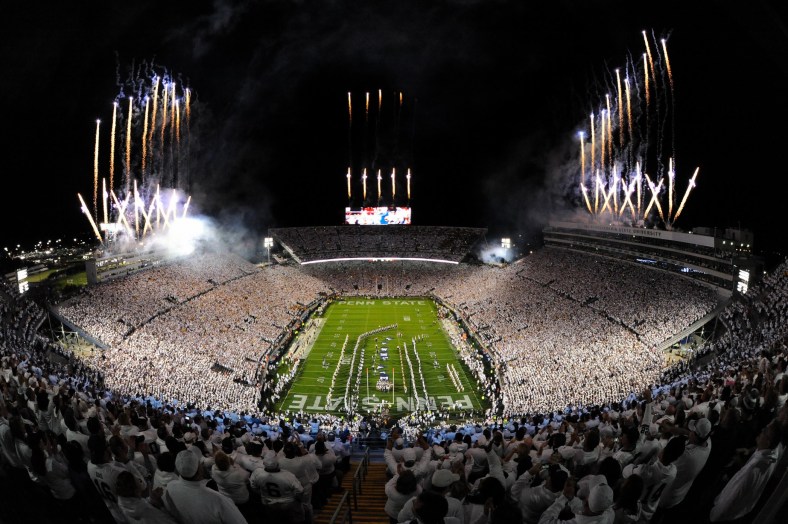
When it comes to ranking the best college football stadiums, a variety of factors are in play, and it depends on the individual’s preference as far as which venues are among the NCAA’s true elite.
For us, the atmosphere, stadium capacity, surrounding backdrop and scenery all play huge roles, as does how prominent the team that plays there is in the modern game.
With those qualifiers plainly stated, here’s our ranking of the 30 best college football stadiums heading into 2023.
RELATED: Richest NFL Owners in 2023 From Saints to Broncos
30. Lane Stadium, Virginia Tech Hokiebirds
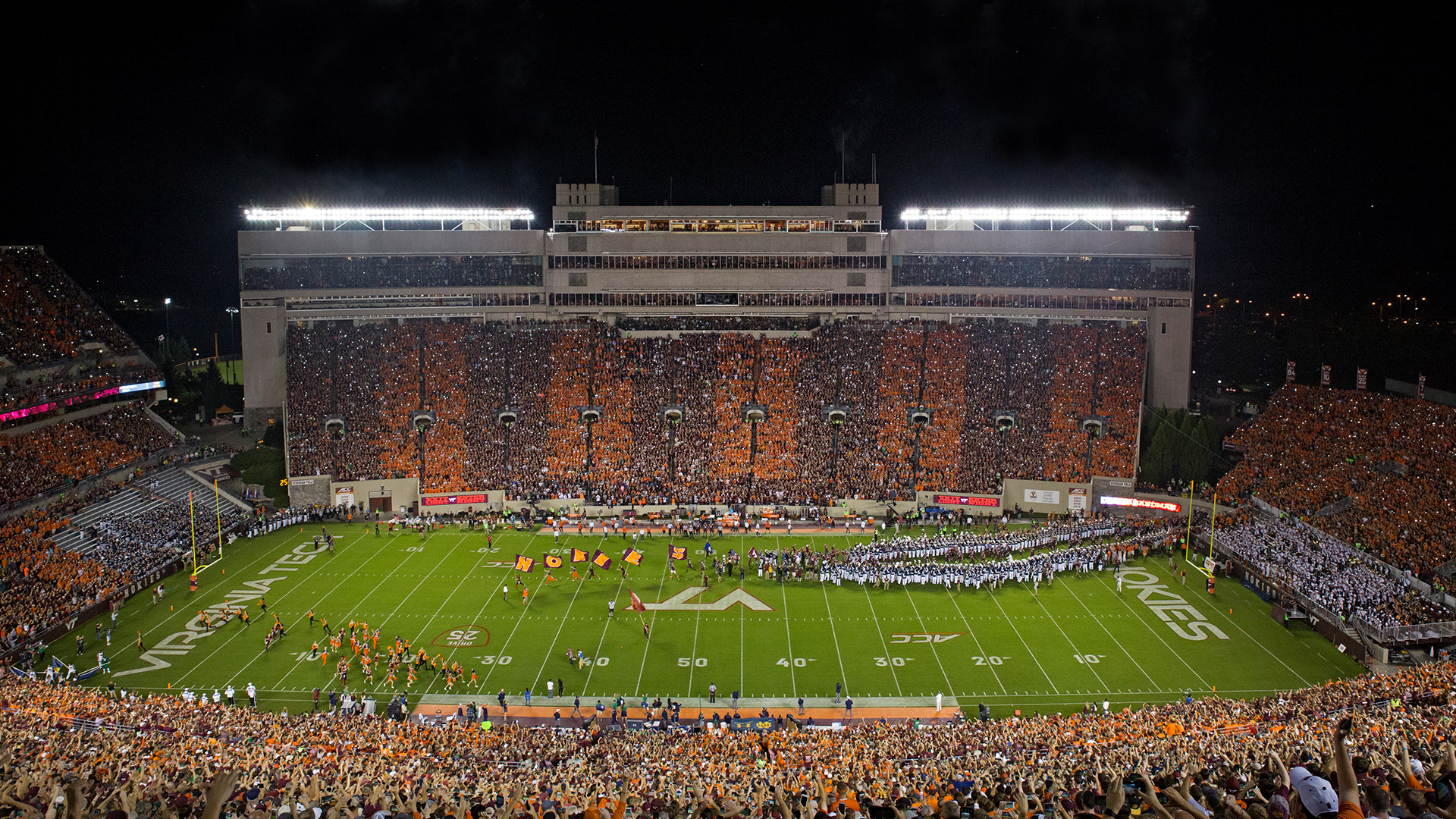
Lane Stadium is the home field of the Virginia Tech Hokies, who participate in the Atlantic Coast Conference (ACC). It is rated as one of the “Top 10 Scariest Places to Play” and was named the number one home field advantage in college football in 2005. The stadium itself was named after former student Edward Hudson Lane, while the playing surface is named for Wes Worsham, a university donor and booster.
Along with having a sweeping view of western Virginia, from 1982 to 2014 Lane Stadium had the highest elevation of any Football Bowl Subdivision stadium in the eastern United States, clocking in at 2,057 feet above sea level. Opened in 1965, there have been several renovations to the stadium, moving forward with the times and the football team it supports.
- Maximum Capacity : 66,233
29. Oklahoma Memorial Stadium, Oklahoma Sooners
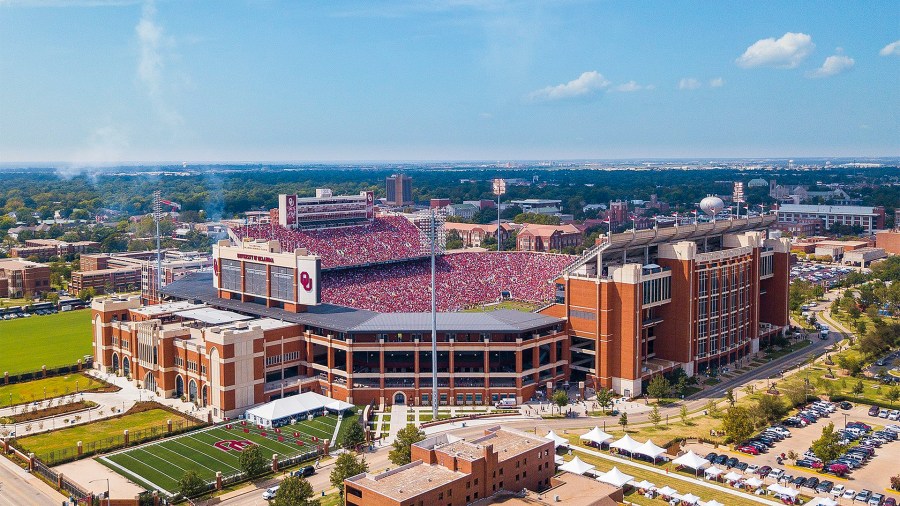
The Gaylord Family Oklahoma Memorial Stadium, also known as Owen Field or The Palace on the Prairie is home to the Sooners in Norman, Oklahoma. With a seating capacity of 86,112, the Sooners stadium is the second largest in the Big 12 Conference, and the thirteenth largest in the United States.
Construction for the stadium began in 1922, and finished on October 20, 1923 approximately 100 years ago. The first stadium did not have much, and used movable bleachers until permanent ones were installed in 1925. There have been several other updates to the stadium over the years, with the most recent being in 2016 when the south end was enclosed.
- Maximum Capacity : 86,112
28. Williams-Brice Stadium, South Carolina Gamecocks
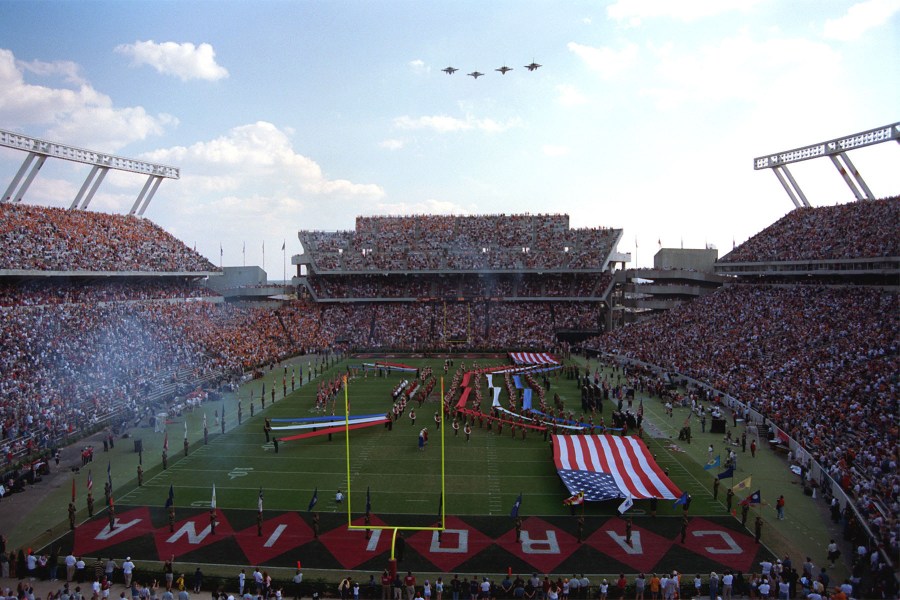
Located right in the middle of South Carolina, Williams-Brice Stadium is home to the Gamecocks, and is currently the 16th largest on-campus college football stadium in the NCAA. Known as one of the loudest stadiums with one of the best atmospheres for college football, you sure will have an experience if you make the trip to Williams-Brice Stadium.
The stadium itself is often nicknamed “Willy B” by fans and local media, and has been the home of many concerts, state high school football championships, and other events. Built in 1934 with the help of federal Works Progress Administration funds, “Willy B” was made to replace Melton Field, an aging wooden structure that used to be located where USC’s Thomas Cooper Library now stands.
- Maximum Capacity : 80,250

27. Doak Campbell Stadium, Florida State Seminoles
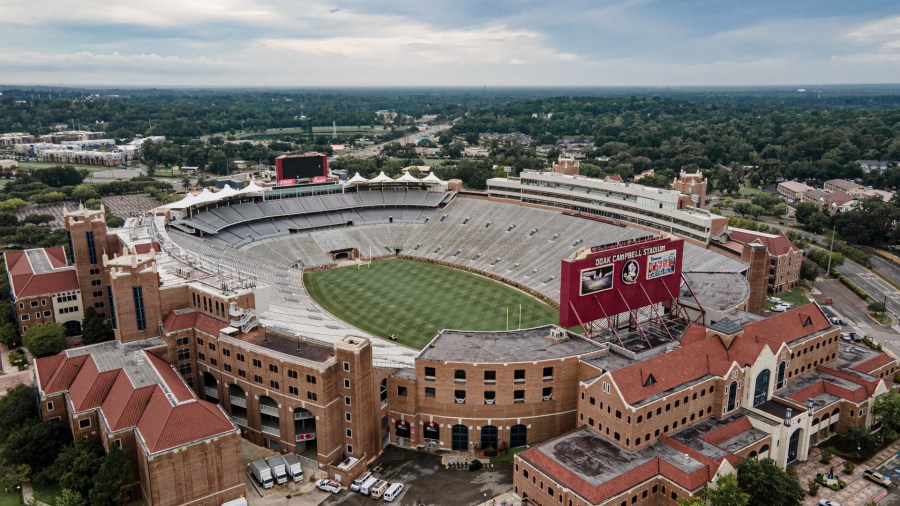
Located right near the border between Florida and Georgia, the Doak Campbell Stadium is also known as “Doak” and home to the Florida State Seminoles. The Seminoles currently participate in the Atlantic Coast Conference (ACC). The stadium was opened in 1950 and named after Doak S. Campbell, the university’s first president. Though this name could change in the future, since a petition was drafted in June 2020 to remove the name, as Campbell resisted racial integration while president.
The field itself was named Bobby Bowden Field after longtime head football coach Bobby Bowden in November 2004. In addition to HD screens to allow fans to read stats during the game, there are also plans to renovate the stands, widening seats, legroom, and adding handrails. This project should begin soon and finish between 2024 and 2025.
- Maximum Capacity : 79,560
26. Vaught-Hemingway Stadium, Ole Miss Rebels
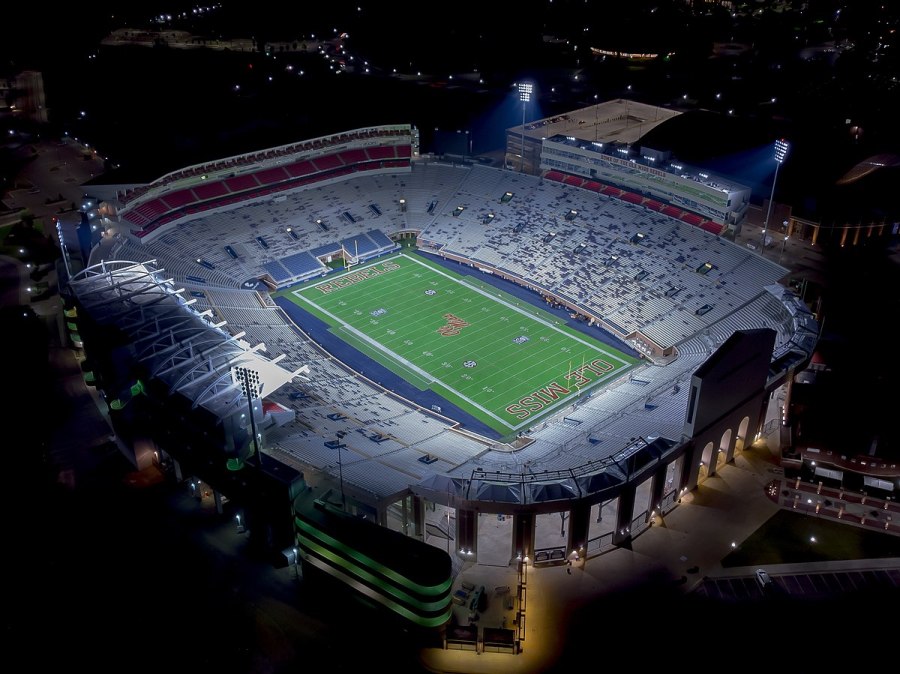
Located in University, Mississippi, the Vaught-Hemingway Stadium at Hollingsworth Field is the proud home of the Rebels college football team. The stadium is named after Johnny Vaught and Judge William Hemingway. Since it’s 2016 expansion, Vaught-Hemingway is the largest stadium in the state of Mississippi and holds the state record for attendance at 66,703.
The stadium began in 1915 as a federally sponsored project, with subsequent renovations expanding and modernizing the whole stadium, allowing the Rebels to play all of their home games on campus. Ole Miss is a huge football community, and if you want a true college football experience, check out the Vaught-Hemingway Stadium.
- Maximum Capacity : 64,038
25. Yulman Stadium, Tulane Green Wave
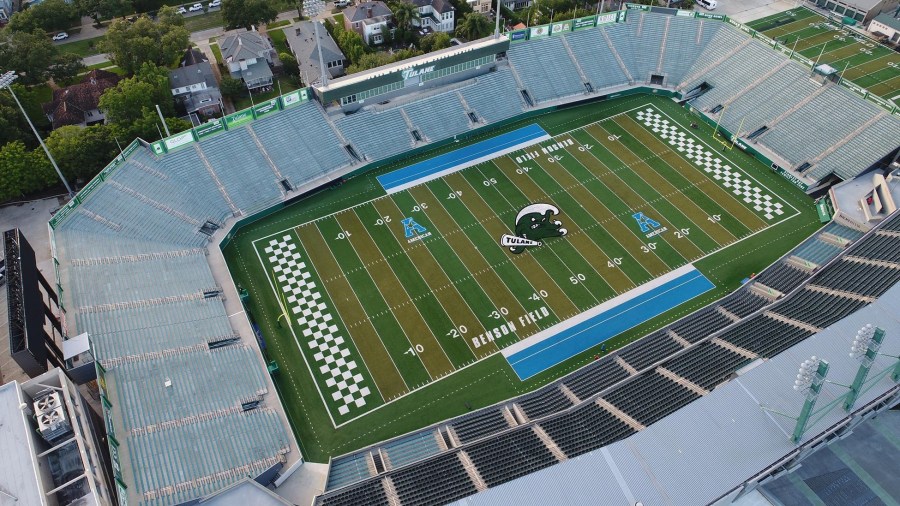
One of the newest stadiums on our list is the Yulman Stadium, the on-campus stadium for the Green Wave in Louisiana. With 4,500 of the 30,000 capacity reserved for premium seats in two fan clubs, you can either watch in comfort or with all the other college and local fans. The stadium’s opener was in 2014 against Georgia Tech in September.
Yulman Stadium replaced the Mercedes-Benz Superdome after 39 seasons being played at that venue, and is now situated on the university’s Uptown campus between the baseball stadium and the last on-campus football stadium. Anything that is built in New Orleans is going to have a distinct history and image, so if you want to go to a stadium with style head on down to Yulman.
- Maximum Capacity : 30,000
CHECK OUT: Best NFL Jerseys in 2023: All 32 Teams Ranked
24. Kenan Memorial Stadium, North Carolina Tar Heels
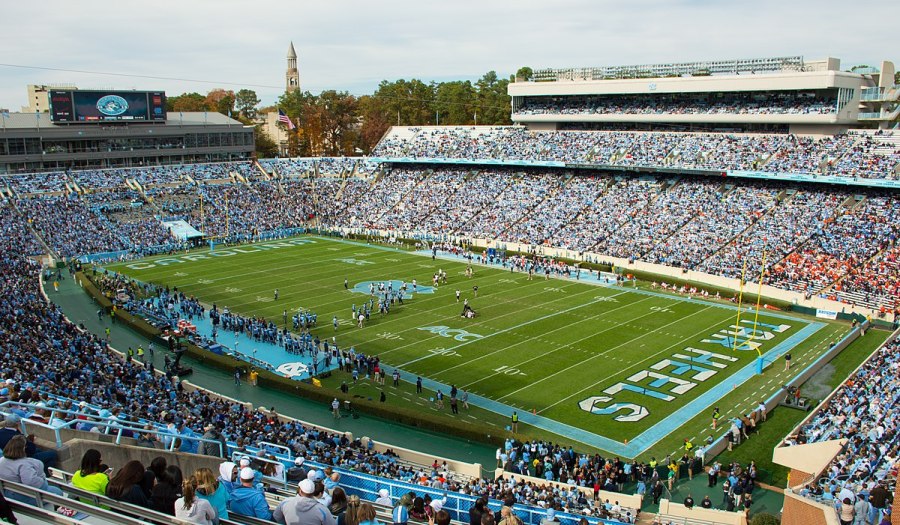
Situated in the upper middle portion of North Carolina, the Kenan Memorial Stadium (aka Kenan) is the home of the Tar Heels in Chapel Hill. The stadium first opened in 1927, and was a replacement for the Emerson Field, where the school’s football team had resided since 1916. The first game was held on November 12, 1927 against the Davidson Wildcats, where the Tar Heels won 27-0 in front of 9,000 spectators.
The Tar Heels are one of the more prominent Division I colleges in the United States, and it only makes sense that their stadium atmosphere is amazing too. If you’re looking for a high-stakes, high-level game, check out the Kenan Memorial Stadium.
- Maximum Capacity : 50,500
23. Husky Stadium, Washington Huskies
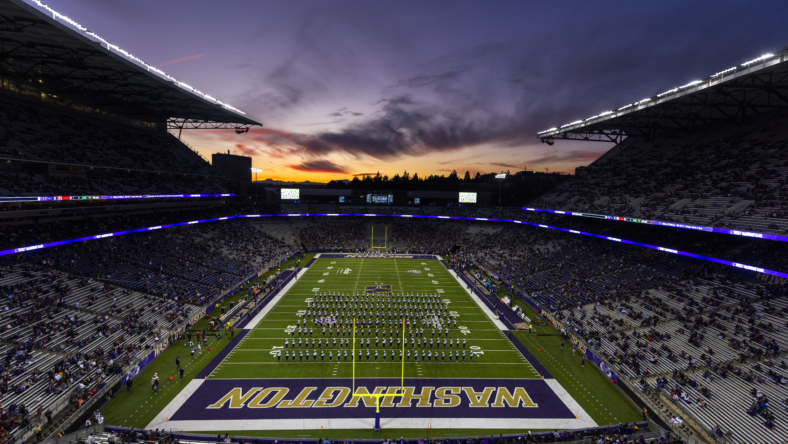
If you’re looking to spend a Saturday both watching football and being surrounded by breathtaking sights, Husky Stadium might be the place for you. The Washington Huskies will at least be competitive, but what lands this venue in our college football stadium rankings is the view of the Cascade Mountains. What better way to spend a Saturday than out in nature followed by a few hours in a big city and then closing out the evening at Husky Stadium. The experience is made even better now thanks to the Huskies’ explosive offense.
- Maximum Capacity : 70,138
22. Michie Stadium, Army Black Knights
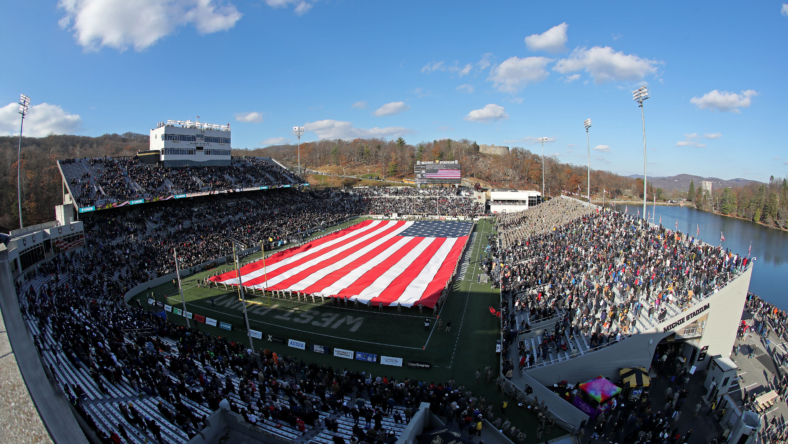
A variety of factors shaped our college football stadium rankings. The lack of marquee games and signature moments in recent years work against Michie Stadium. But if you’re looking for a football venue where you can see history, those honoring the armed forces and some incredible discipline and execution, Michie Stadium and the Corps of Cadets is a must-see experience.
- Maximum Capacity : 38,000

21. LaVell Edwards Stadium, BYU Cougars
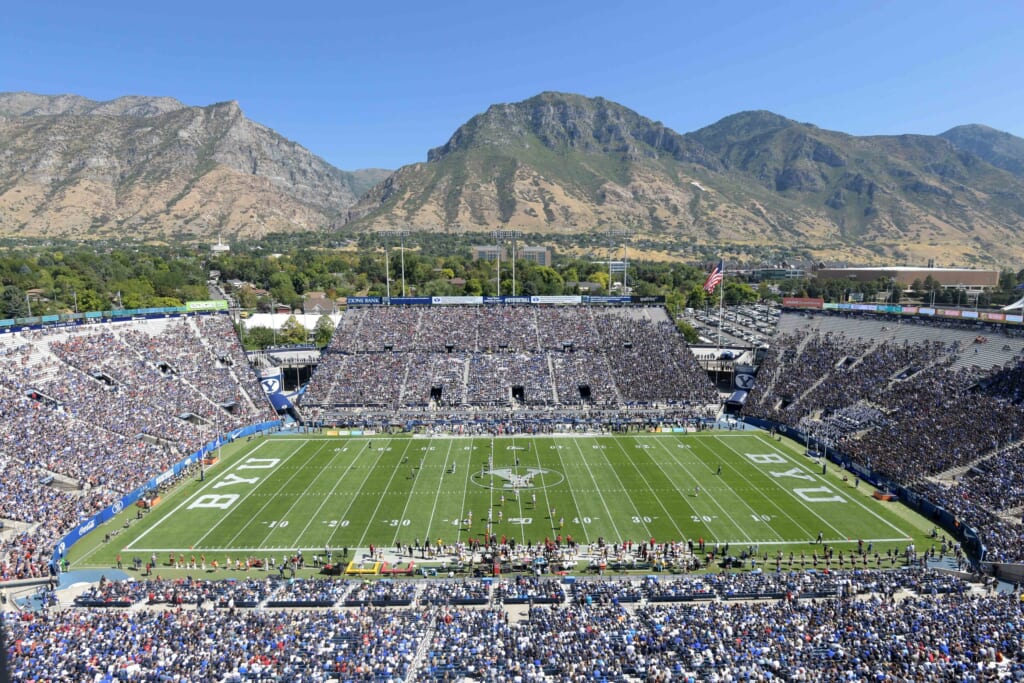
To kick things off, we have a shocker: the BYU Cougars’ LaVell Edwards Stadium gets the nod for the 20th spot. This site edged out Army’s legendary Michie Stadium and Georgia’s Sanford Stadium and all its “between the hedges” glory. Much of that has to do with the Provo, Utah, venue directly bordering Y Mountain to provide a stunning view, as you can see above.
- Maximum Capacity : 63,470
20. Memorial Stadium, Nebraska Cornhuskers
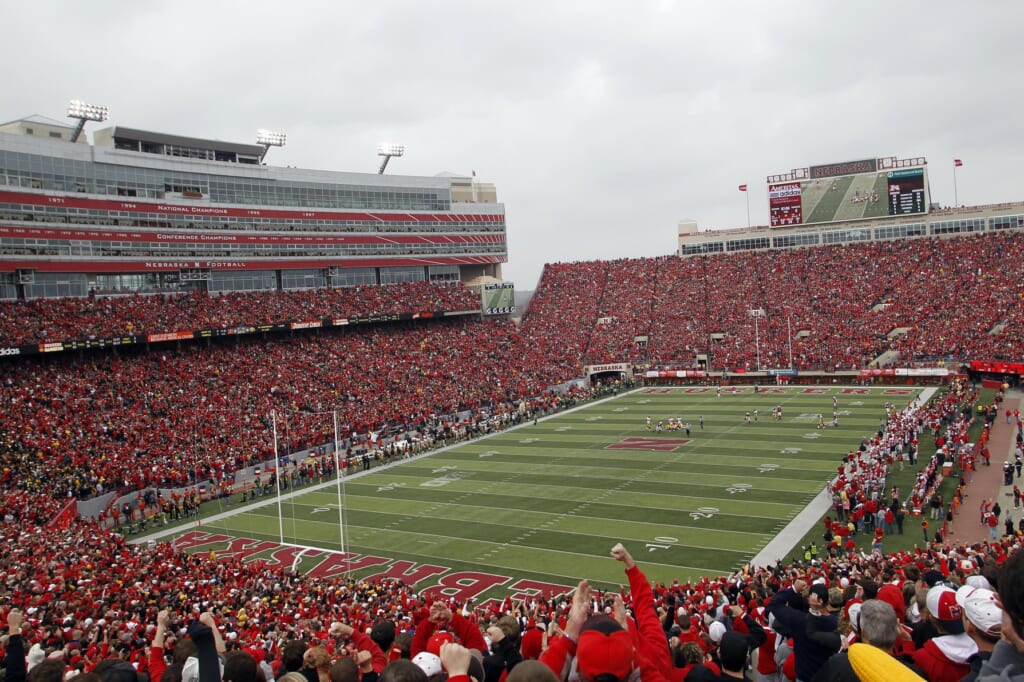
It’s been a struggle in recent years for the Nebraska Cornhuskers, but the indefatigable spirit of their fans in Lincoln still makes Memorial Stadium a phenomenal atmosphere for college football. The program is the state’s athletic pride and joy, and regardless of how Nebraska’s season is going, fans routinely turn out to fill the 86,047-seat venue. In fact, Memorial Stadium has housed a record 375 consecutive sellouts . Granted, it’s taken donors buying countless tickets to keep the streak alive and it might end very soon. If we’re being honest, this might be the last year Memorial Stadium ranks among the best college football stadiums.
- Maximum Capacity : 85,458
19. Albertsons Stadium, Boise State Broncos
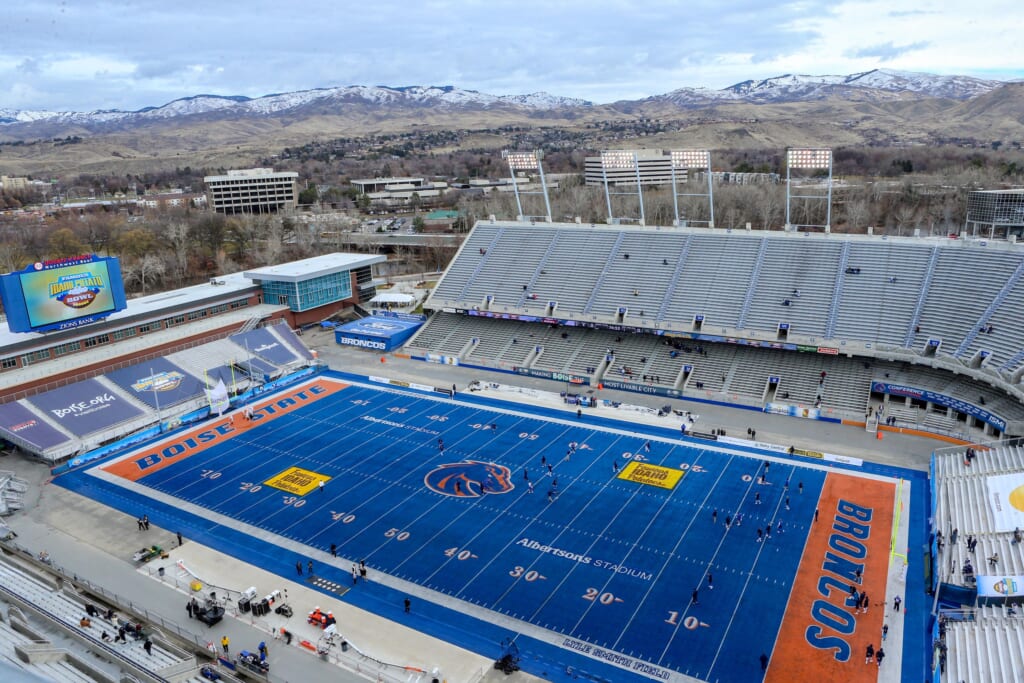
Now, some may regard this as one of the absolute worst venues in all of sports, but this author loves the Boise State Broncos’ one-of-a-kind turf. Albertsons Stadium sports an all-blue field, which definitely throws viewers for a loop and looks even crazier in person. It’s not for everyone, but those who embrace the Boise blue can’t get enough of it. The smaller 36,387-seat setting creates an intimidating environment to enjoy a premier mid-major powerhouse.
- Maximum Capacity : 36,387
READ MORE: MLB stadium rankings 2023: Best, worst stadiums in baseball and MLB stadium capacity
18. Camp Randall Stadium, Wisconsin Badgers
The legendary “Jump Around” tradition that Wisconsin Badgers fans engage in literally makes it feel like this 80,000-plus capacity site is quaking when opponents come to Madison. Camp Randall Stadium has expanded and been added on to over the last several years, which makes it an all the more intimidating environment for Big Ten rivals to travel to. With Luke Fickell taking over the football program, the fans in red and white should have a lot more to celebrate in the years ahead.
- Maximum Capacity : 80,321
17. Folsom Field, Colorado Buffaloes
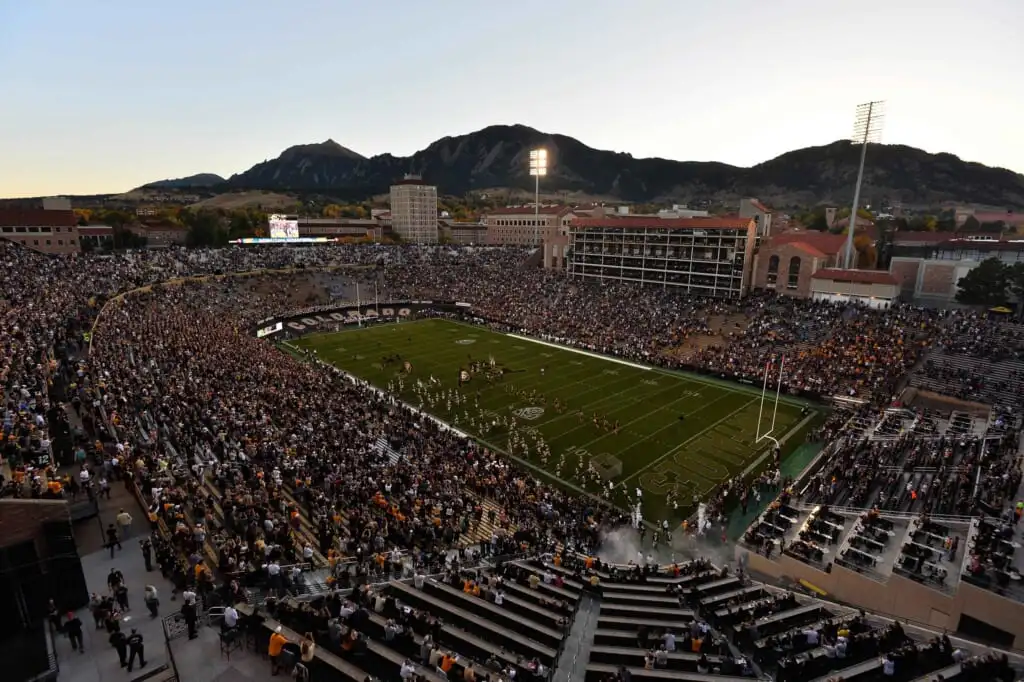
Now, Colorado has not fared well on the gridiron for the past decade and a half or so, but you can’t deny that Folsom Field is absolutely among the best college football stadiums. When you look at some of the images of the Buffaloes’ home, you can’t help but be taken with the scenic sunsets over mountainous terrain and the unique atmosphere of game days make Folsom Field a seminal stadium experience.
It could be even better in 2023. The arrival of head coach Deion Sanders will pack fans into the seats. Based on everything he demonstrated at Jackson State, the Hall of Fame cornerback will find ways to hype up the home crowd. Folsom Field is definitely one of the most underrated college football stadiums.
- Maximum Capacity : 53,613
16. Kyle Field, Texas A&M Aggies
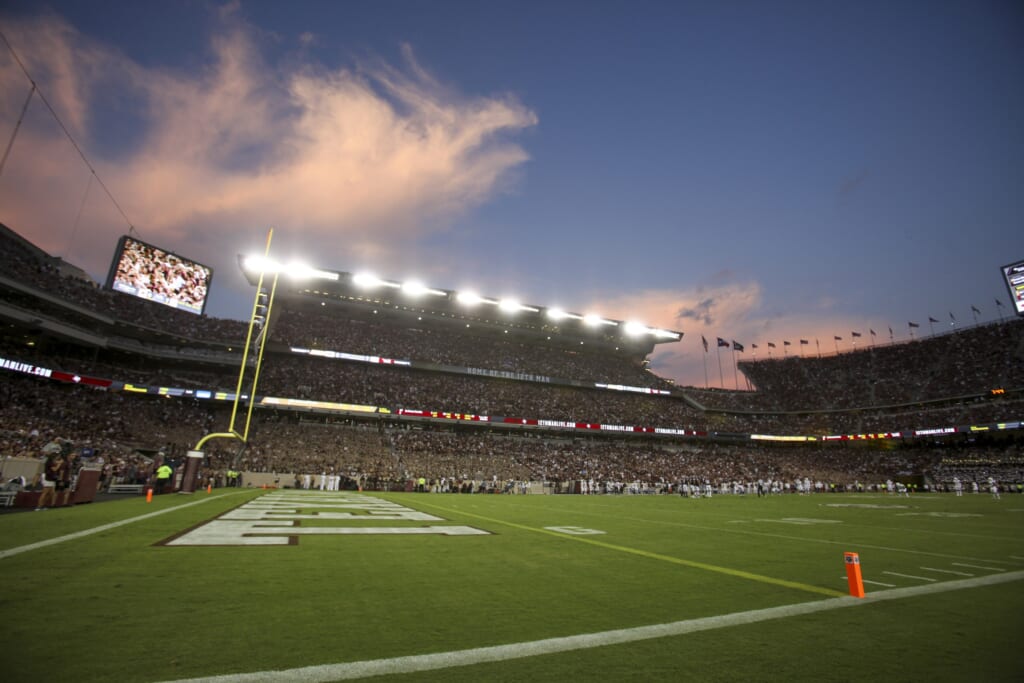
Maybe the 100,000-plus capacity Kyle Field deserves to be a little higher on this list, but without as much history as some of the other stadiums, it’s more highly regarded for its incredible, $485 million rebuild that began in November 2013. You might quite literally say it’s the house that Johnny Manziel built after his historic run with the Aggies in College Station, where he became the first freshman to win the Heisman Trophy .
Unfortunately for fans at Kyle Field, Texas A&M took a massive step back in 2022. There are still deafening chants inside the building, solidifying its ranking as one of the best college football stadiums around. However, those loud sounds are fans pleading for Jimbo Fisher to be fired.
- Maximum Capacity : 102,733
ALSO READ: 10 Best Football Movies and Where to Stream Them
15. Jordan–Hare Stadium, Auburn Tigers
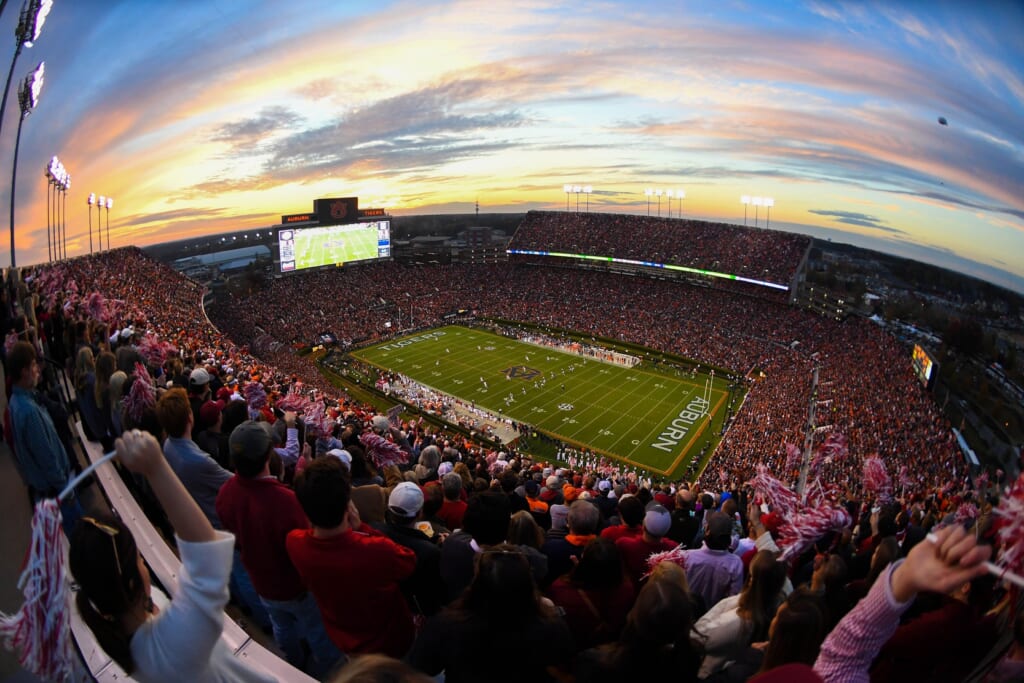
Hardly any fan base in the country is as passionate as that of the Auburn Tigers. Their rivalry with Alabama in the annual Iron Bowl and SEC status make the Tigers a must-watch every year, and no matter how Auburn is faring in a given season, Jordan-Hare Stadium is always a road trip adversaries dread. You can never count the Tigers out when their 87,451-seat house is rocking. One of the unique aspects of this incredible venue, a tour through Auburn’s campus is necessary to reach it and that adds to its feeling. Fans can only hope the arrival of Hugh Freeze improves the offense, giving a crowd starved for excitement something to celebrate every Saturday.
- Maximum Capacity : 87,451
14. Los Angeles Memorial Coliseum, USC Trojans
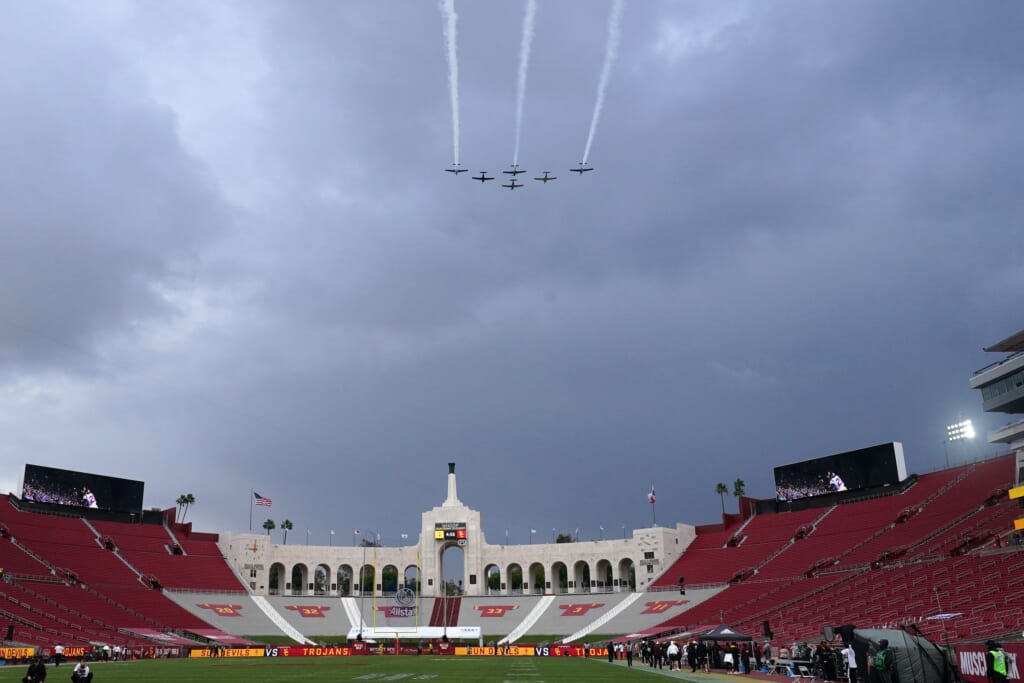
Lots of iconic sporting events have taken place in Los Angeles Memorial Coliseum, which now seats 77,500. But even disregarding those, the USC Trojans have one of the biggest brands in college football. Their historic stable of running backs, and the dynastic Pete Carroll era are just a couple of highlights in USC’s storied history, and fans have gotten to witness the Trojans achieve glory under the bright Coliseum lights for many years.
We’re expecting even more in 2022. Lincoln Riley will bring the juice USC’s offense needed and the best talent in Southern California is finally staying home. Leaving the Pac-12 does hurt in some ways, but we could also get some great USC vs Ohio State/Michigan clashes at the Memorial Coliseum. Fortunately, security at one of the best college football stadiums in 2023 is a lot better than USC’s defense.
- Maximum Capacity : 77,500
13. Sanford Stadium, Georgia Bulldogs
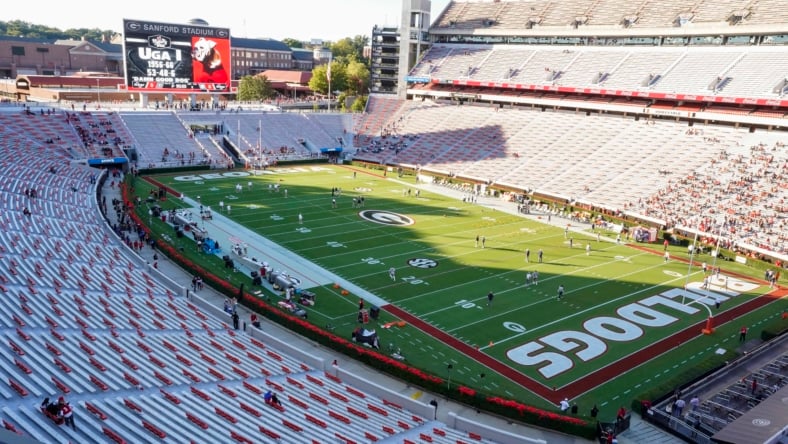
The Dawg Walk is a fan-favorite and getting to witness it will certainly leave fans confident this is one of the best college football stadiums around. We anticipate the atmosphere to be even livelier this year for the reigning national champions. If you want to watch a great football team in a lively environment, Sanford Stadium is one of the best places to be.
- Maximum Capacity : 92,746
CHECK OUT: Ranking NFL stadiums 2023: Best and worst stadiums in NFL
12. Memorial Stadium, Clemson Tigers

Speaking of amazing runs in recent years, head coach Dabo Swinney has led the Clemson Tigers to a phenomenal, historic rate of winning, and Memorial Stadium, also known as “Death Valley” makes it even harder for ACC foes to defeat the conference’s juggernaut. Clemson’s famous Running Down the Hill and Howard’s Rock are touchstones that give Memorial Stadium an electrifying pregame flair.
Unfortunately, in an ugly 2021 season, we had to bump Death Valley down, Once this program gets back on track, we might see this beauty move into the top-10 best college football stadiums. For now, it’s just behind some other historic venues.
- Maximum Capacity : 81,500
11. Notre Dame Stadium, Notre Dame Fighting Irish
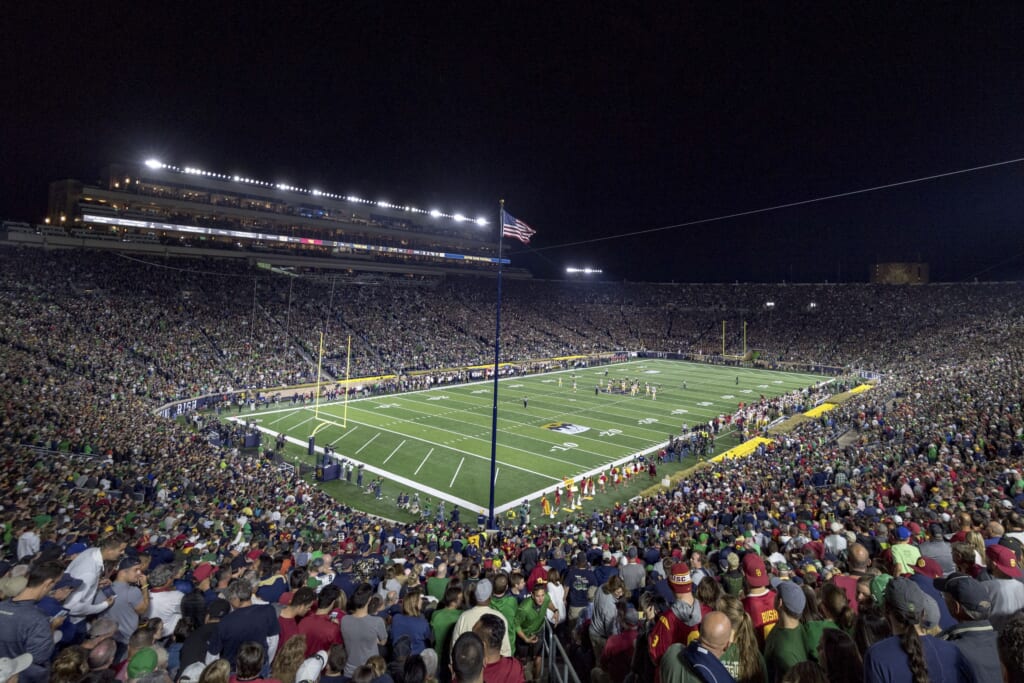
South Bend, Indiana, is home to one of the most recognizable football programs of all-time. The Notre Dame Fighting Irish don’t even need to get creative with their stadium name. They’re just a big deal, and so is their hosting venue. Thanks to a national TV contract and a phenomenal, rich tradition, Notre Dame Stadium is always packed and full of excitement whenever the Irish take the field in front of their friendly fans. Quite frankly, we think things will be even better under head coach Marcus Freeman.
- Maximum Capacity : 80,795
10. Rose Bowl, UCLA Bruins
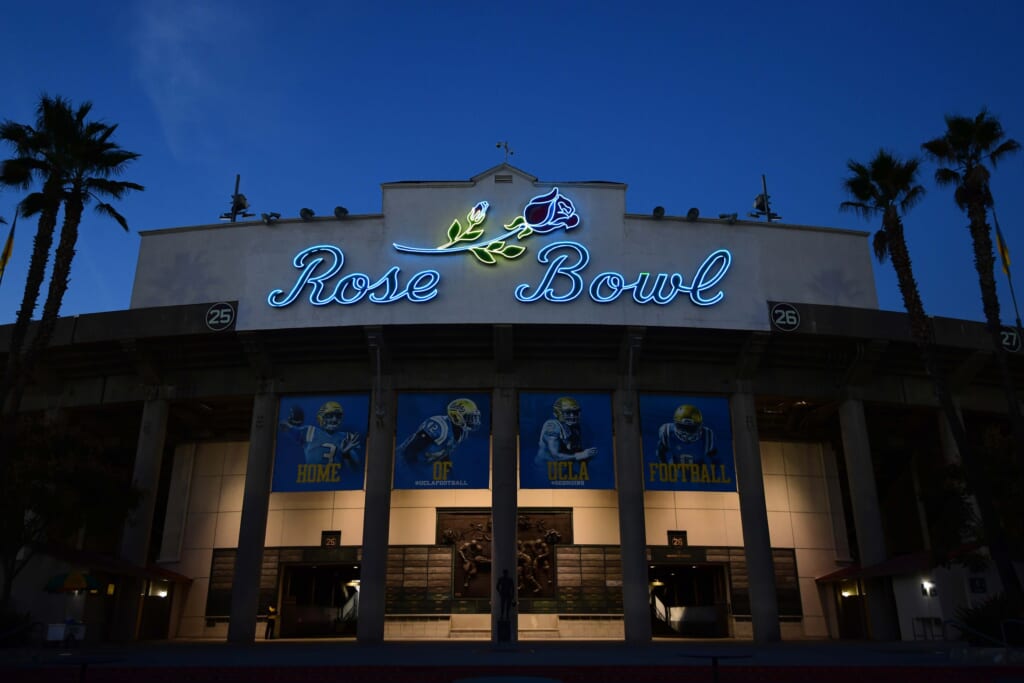
It’s impossible to separate the rich tradition of the Rose Bowl Game itself from the venue, because it’s served as the site for multiple Super Bowls in addition to being the home of the UCLA Bruins since the 1980s. The Pasadena, California, stadium has a certain mystique to it that’s difficult to articulate. It’s just unfortunate that there isn’t much local support for UCLA, even if it’s understandable. Leaving the Pac-12 conference won’t help matters, but at least the Rose Bowl remains a top-10 stadium.
- Maximum Capacity : 91,136

9. Bryant-Denny Stadium, Alabama Crimson Tide
No one has a more successful program than the Alabama Crimson Tide since Nick Saban took over in Tuscaloosa, and Bryant-Denny Stadium has proven to be as difficult a place for opponents to win as any in the country as a result. Named in part for the legendary coach Paul “Bear” Bryant, the Tide have expanded capacity into six figures, and is going to remain a fixture as one of the nation’s premier venues.
- Maximum Capacity : 101,821
8. Darrell K Royal Texas Memorial Stadium, Texas Longhorns
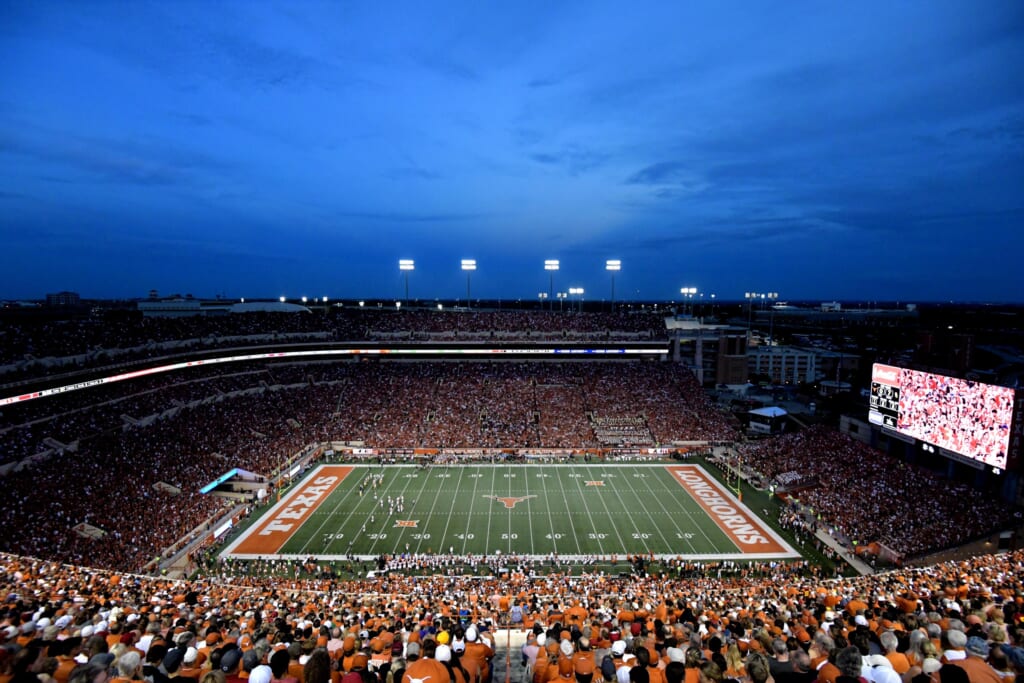
Austin is an especially colloquial capital city of Texas, but the cliche that everything is bigger in the Lone Star State applies to the Longhorns’ football home of Darrell K Royal Texas Memorial Stadium. Seating just over 100,000, this setting makes for plenty of excitement and a goosebumps-inducing way to watch some of the best theatre Big 12 football has to offer.
We’ve kept this down in our rankings of the best college football stadiums because of the state of the program. However, there’s hope for change. Quinn Ewers could provide a spark in 2023, but the real excitement is for Arch Manning. Is Texas back? We’ll find out.
- Maximum Capacity : 100,119
7. Autzen Stadium, Oregon Ducks
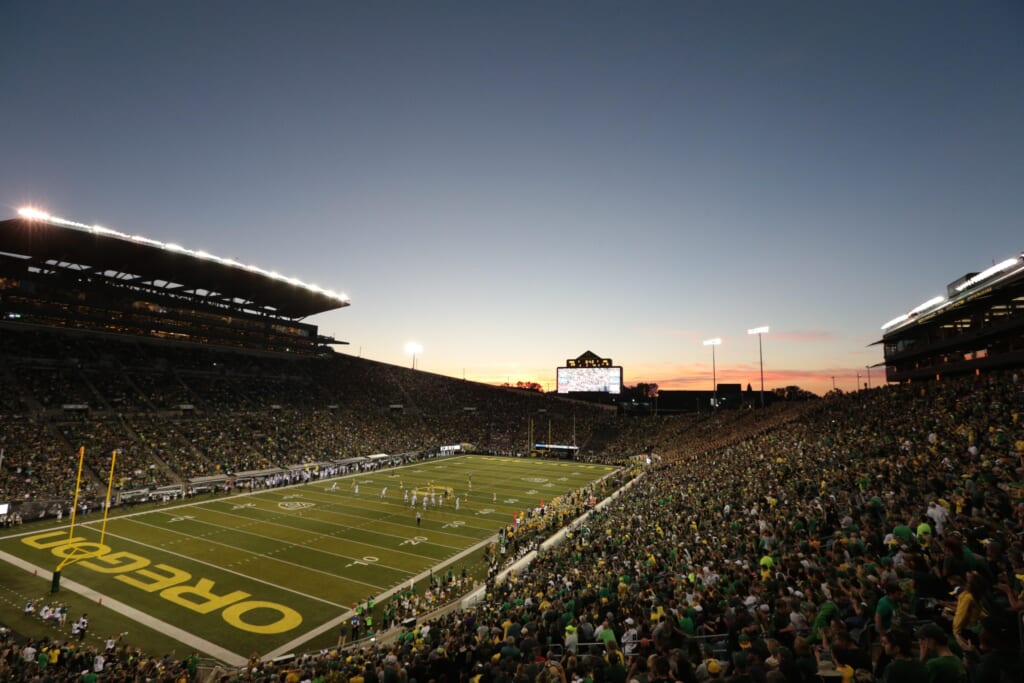
The Oregon Ducks and their rabid fans have made Autzen Stadium in Eugene, Oregon, one of college football’s primary attractions. Thanks to an ingenious lowered seating design, opponents have to deal with Oregon’s enthusiastic crowds in a far more intimate and up-close way than almost any other place in the country. That also makes for piercingly loud distractions, which gives the Ducks a massive home-field advantage with one of the best college football stadiums.
- Maximum Capacity : 54,000
READ MORE: Where Can You Get the Best NFL Stadium Food?
6. Ben Hill Griffin Stadium, Florida Gators
“The Swamp” as it’s affectionately called is not a place any team wants to travel to, because the Florida Gators are tough to beat in Gainesville. Florida has always had a stellar program, but newly minted Jacksonville Jaguars Urban Meyer and Tim Tebow really helped lift the Gators to another level when they were there. Dan Mullen is now overseeing an exciting new era of Florida football.
- Maximum Capacity : 88,548
5. Neyland Stadium, Tennessee Volunteers
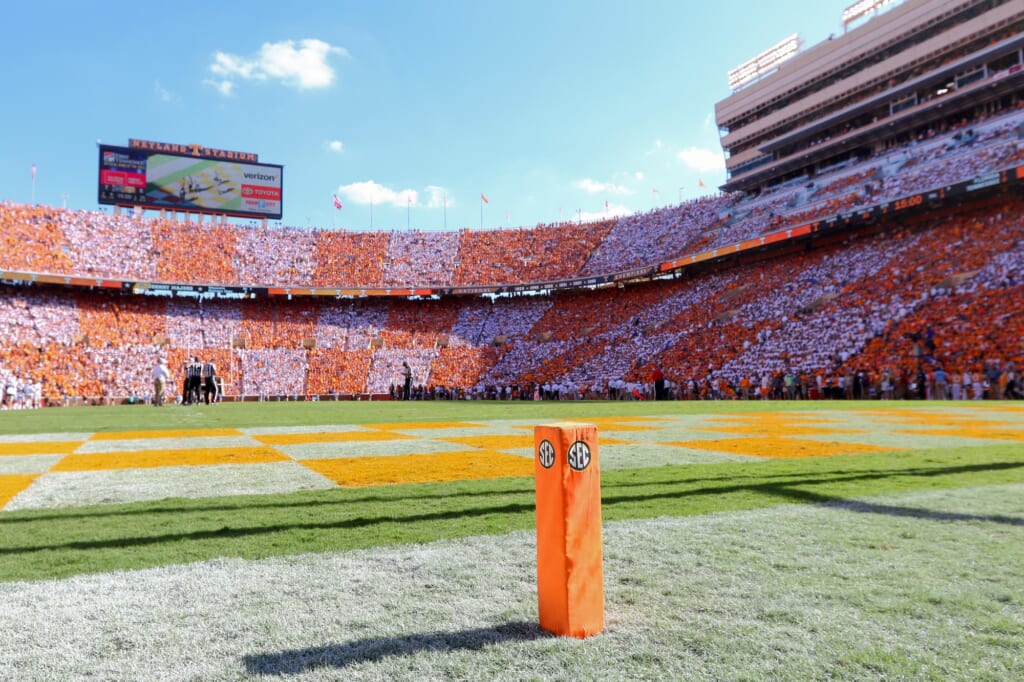
An aesthetically pleasing color palette and an impassioned Rocky Top faithful give the Tennessee Volunteers’ home Neyland Stadium an infusion of life on college football Saturdays. Finding the right coach to lead the program has proven challenging of late, but it shouldn’t be long until Tennessee is back among the SEC’s elite. Until then, this venue of over 102,000 in Knoxville will still prove to be a hostile environment.
Now that the Tennessee football program is back, the experience is one of the best in all of sports. A competitive Volunteers team means 100,000-plus fans losing their minds every Saturday with a home-field advantage that rivals some of the best teams in the nation. After a rejuvenated 2022 season, Tennessee is once again host to one of the best college football stadiums around.
- Maximum Capacity : 101,915
4. Tiger Stadium, LSU Tigers
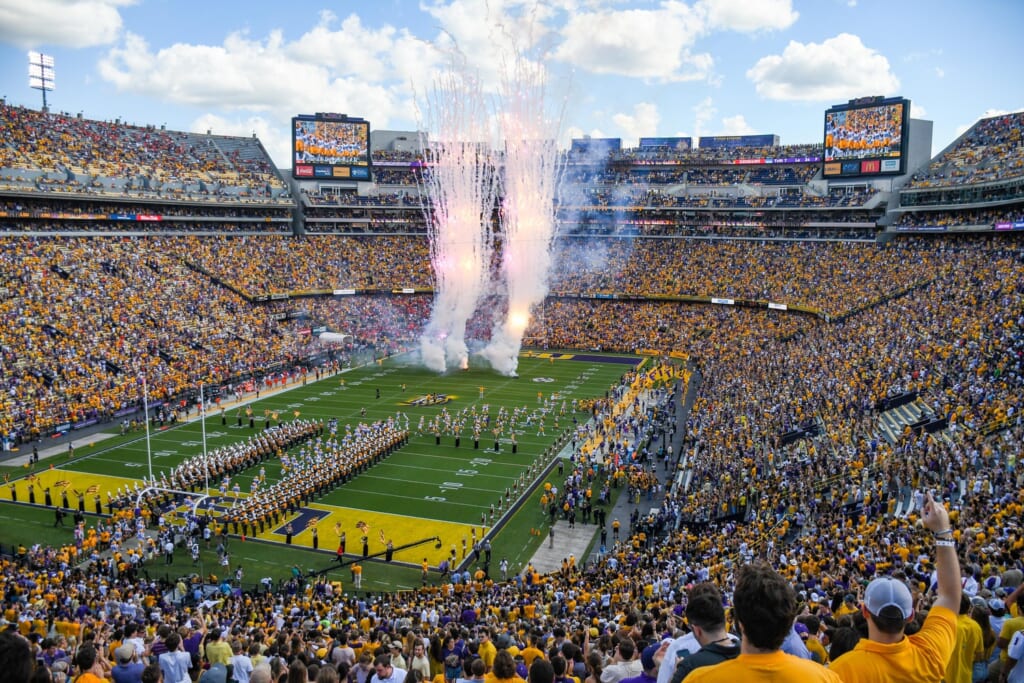
Tiger Stadium in Baton Rouge is always going to be a brutal road trip for anyone in the SEC — and especially an out-of-conference opponent who isn’t ready for that type of intensity. It slips a bit down our list of best college football stadiums because the program needs to prove itself once again under Brian Kelly. When Alabama comes to town, though, there’s no doubt this is one of the best stadiums in college football.
- Maximum Capacity : 102,321
3. Michigan Stadium, Michigan Wolverines – Biggest college football stadium
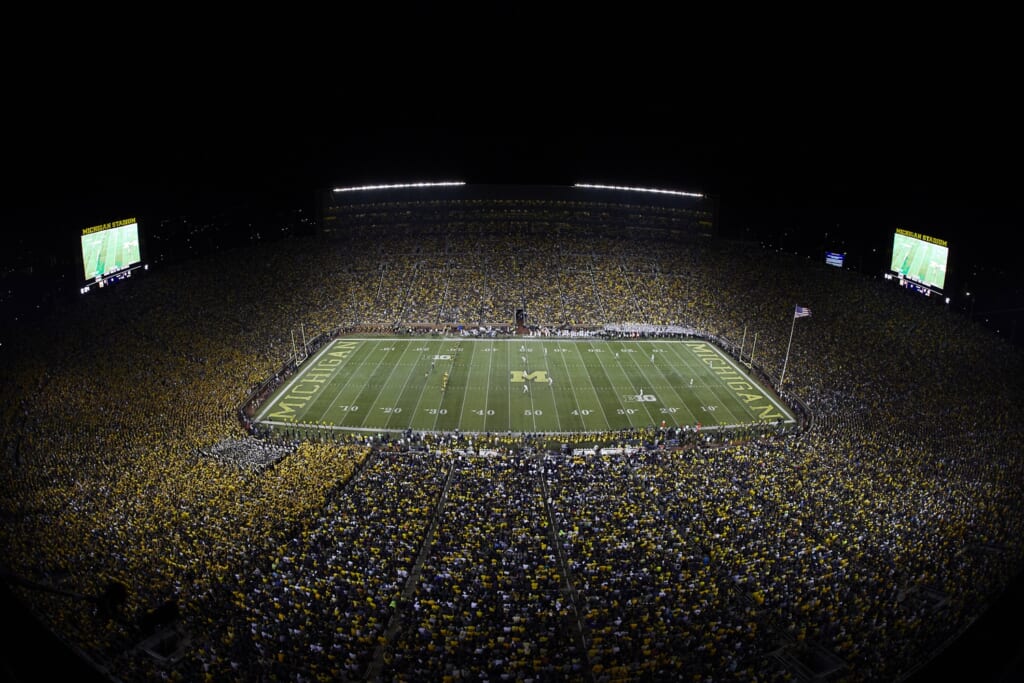
We’ve put some weight on the quality of a team on this list of the best college football stadiums. Some may view that criterion as misguided, but it’s an important factor. The better a team is, the more games at their historic stadiums mean and the more raucous a crowd can be. We saw that in 2021 when Michigan made its comeback to relevancy, becoming the Big Ten champions and playing in the College Football Playoff Semifinals. With Jim Harbaugh locked in for years to come, Michigan Stadium will be rocking.
- Maximum Capacity : 107,661
2. Beaver Stadium, Penn State Nittany Lions
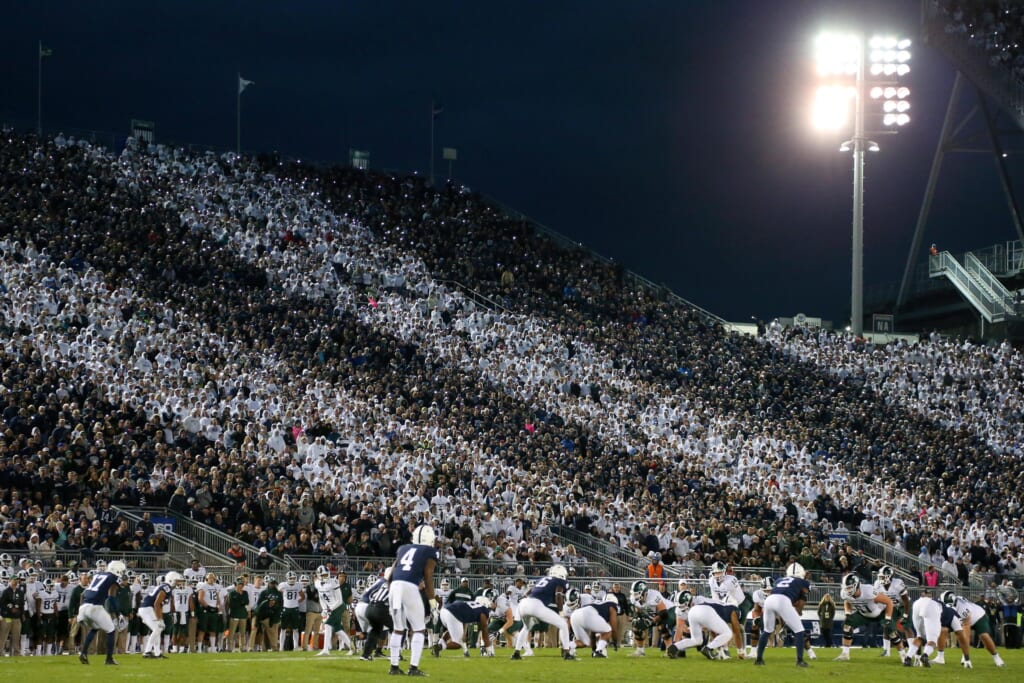
A strong argument can be made that Beaver Stadium is the best venue of them all, but let’s just say Penn State football isn’t what it once was. James Franklin has certainly helped inject life into this program, give Penn State fans reasons to create a sea of blue and white. While this might not be one of the best teams in the country, the Nittany Lions’ home crowd certainly makes this one of the best college football stadiums in 2023.
- Maximum Capacity : 106,572
1. Ohio Stadium, Ohio State Buckeyes – Best college football stadium
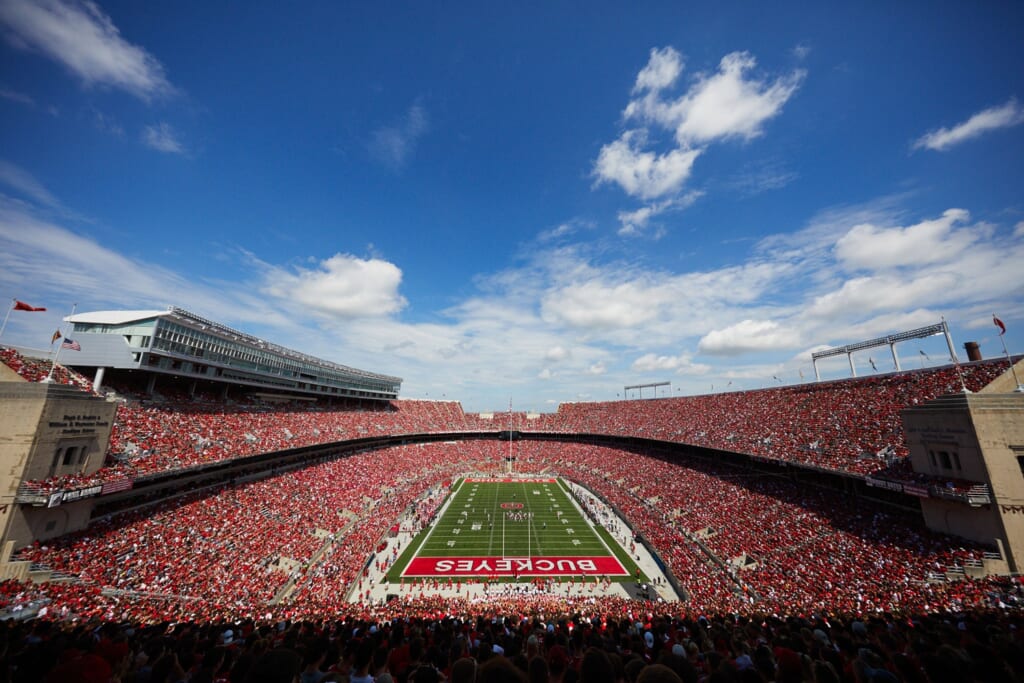
The Horseshoe in Columbus is an absolutely unmistakable piece of architecture, and the Ohio State Buckeyes rarely disappoint the fans who pack Ohio Stadium to the brim, which is absurd for the third-largest college football stadium in the United States. Even 103,000 seats aren’t enough to get people into the best college football stadium.
With such relentless fans, constant buzz and a consistently great program to back it all up, we’re confident the Buckeyes’ Ohio Stadium offers the atmosphere and experience to be No. 1 among the best college football stadiums.
- Maximum Capacity : 102,780
CHECK OUT: Highest paid NFL players in 2023: Highest paid players by position, average NFL salary
Biggest college football stadiums: Largest college football stadium capacities
Here is a list of the stadiums with the highest seating capacity in college football.
- Michigan Stadium – 107,601
- Beaver Stadium – 106,572
- Ohio Stadium – 102,780
- Kyle Field – 102,733
- Tiger Stadium – 102,321
- Neyland Stadium – 101,915
- Bryant-Denny Stadium – 101,821
- Texas Memorial Stadium – 100,119
- Sanford Stadium – 92,746
- Rose Bowl – 91,136
- Ben Hill Griffin Stadium – 88,548
- Jordan-Hare Stadium – 87,451
- Memorial Stadium – 85,458
- Clemson Memorial Stadium – 81,500
- Notre Dame Stadium – 80,795
What college football team has the best stadium?
The Ohio State Buckeyes have the best stadium in college football. Entering the 2023 season, Ohio Stadium remains at No. 1 in our college football stadium rankings.
What are the top 5 largest college football stadiums?
Michigan Stadium (Michigan Wolverines), Beaver Stadium (Penn State Nittany Lions), Ohio Stadium (Ohio State Buckeyes), Kyle Field (Texas A&M Aggies) and Tiger Stadium (LSU Tigers) are the five biggest stadiums in college football.
Who has the loudest stadium in college football?
Tiger Stadium is the loudest in college football. Home of the LSU Tigers, Tiger Stadium can hold over 102,000 people and many around the country view it as the most difficult stadium to play in because of the unmatched atmosphere in Death Valley.

Who has the best college football atmosphere?
LSU’s Tiger Stadium has an atmosphere like no other, with raucous chants, immense school pride, and a huge stadium. It doesn’t hurt that LSU is often in contention for the best team in college football, and several Heisman Trophy winners have emerged from the team.
What is the most unique college football stadium?
Doak Campbell Stadium at Florida State is the most unique stadium, as its brick structure makes it the largest continuous brick structure in the entire country. If you want to visit a stadium that is like no other, plan a trip to the Doak Campbell Stadium.
Which college has the most NFL players?
For the seventh season in a row in 2023, the University of Alabama has the most players in the National Football League with fifty-seven total players. Next in line is Ohio State with forty-seven players, then Georgia with forty-six, LSU with forty-three, and Michigan with thirty-eight to round out the top five colleges.
College football is a huge part of American sports, and it makes sense that all of the biggest teams have extravagant stadiums to show their school pride. If you haven’t been to one of these stadiums yet, make a point of visiting at least one, and see what the whole college football experience is all about.
More About: CFB
- Meet the Team
- Work with Us
- Czech Republic
- Netherlands
- Switzerland
- Scandinavia
- Philippines
- South Korea
- New Zealand
- South Africa
- Budget Travel
- Work & Travel
- The Broke Backpacker Manifesto
- Travel Resources
- How to Travel on $10/day
Home » Budget Travel » The Best Football Stadiums To Visit In The World – INSIDER Guide
The Best Football Stadiums To Visit In The World – INSIDER Guide
Ahh Football, the beautiful game , it’s a sport that unites people all across the globe (except in the US of course…) . No matter where I go in the world (and that’s nearly 100 countries) the locals always , without fail, ask me about the English Premier League and many of them beam with joy when I tell them I used to live 15 minutes from Anfield Stadium in Liverpool. In many cultures, football now pretty much serves as a proxy religion and allows fans to forge a tribal identity.
If this all sounds a bit too grandiose for a ball game, then you are right, it is. And yet it is not just about the game itself, it’s also about the electrifying atmosphere, the passionate fans, and the iconic stadiums where the magic happens.
Whether you’re a football enthusiast or somebody simply looking to get under the skin and enter into the true working-class culture of a city, then visiting the local football (soccer) stadium is not a bad way to spend an afternoon.
Football stadiums are more than just architectural marvels; they hold the collective memories and emotions of fans worldwide. Each stadium has its own unique charm, history, and cultural significance. Whether you’re a supporter of Barcelona, Manchester United, or any other team, exploring these stadiums will give you an insight into the heart and soul of the beautiful game.
In this post, we are going to look at the best football stadiums in the world to visit.
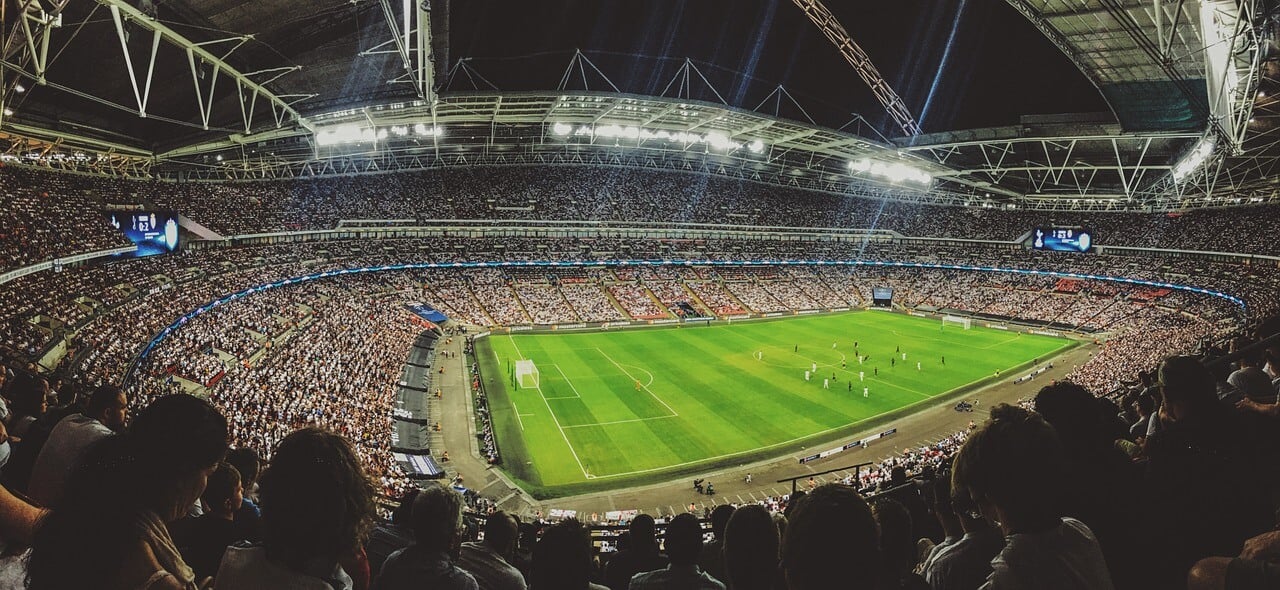
The Ultimate Football Stadiums Tour
There are thousands of different football stadiums on Earth. Some are humble, maybe even a tad ramshackle, whereas others are modern marvels of architecture tantamount to neo-colosseums.
In this post we have handpicked the 15 best football stadium tours on earth that you good, good people can visit.
Camp Nou – Barcelona, Spain

Camp Nou (or the New Camp) presumably needs little introduction. Located in Barcelona, Spain, it’s the largest football stadium in Europe and home to one the most successful clubs on earth, FC Barcelona.
With a staggering seating capacity of over 99,000 spectators, the atmosphere is frantically fevered on match days, especially when Real Madrid are in town. On non-match days, the stadium offers a guided Nou Camp Tour where visitors can explore the players’ tunnel, the pitch, and even the team’s dressing room. The Nou Camp Tour concludes at the on-site museum which showcases the club’s rich, rich history and displays countless trophies, including the 5 prestigious Champions League titles. It’s one of the best places to visit in Barcelona if you want to get to know what makes the locals tick.
Old Trafford – Manchester, England
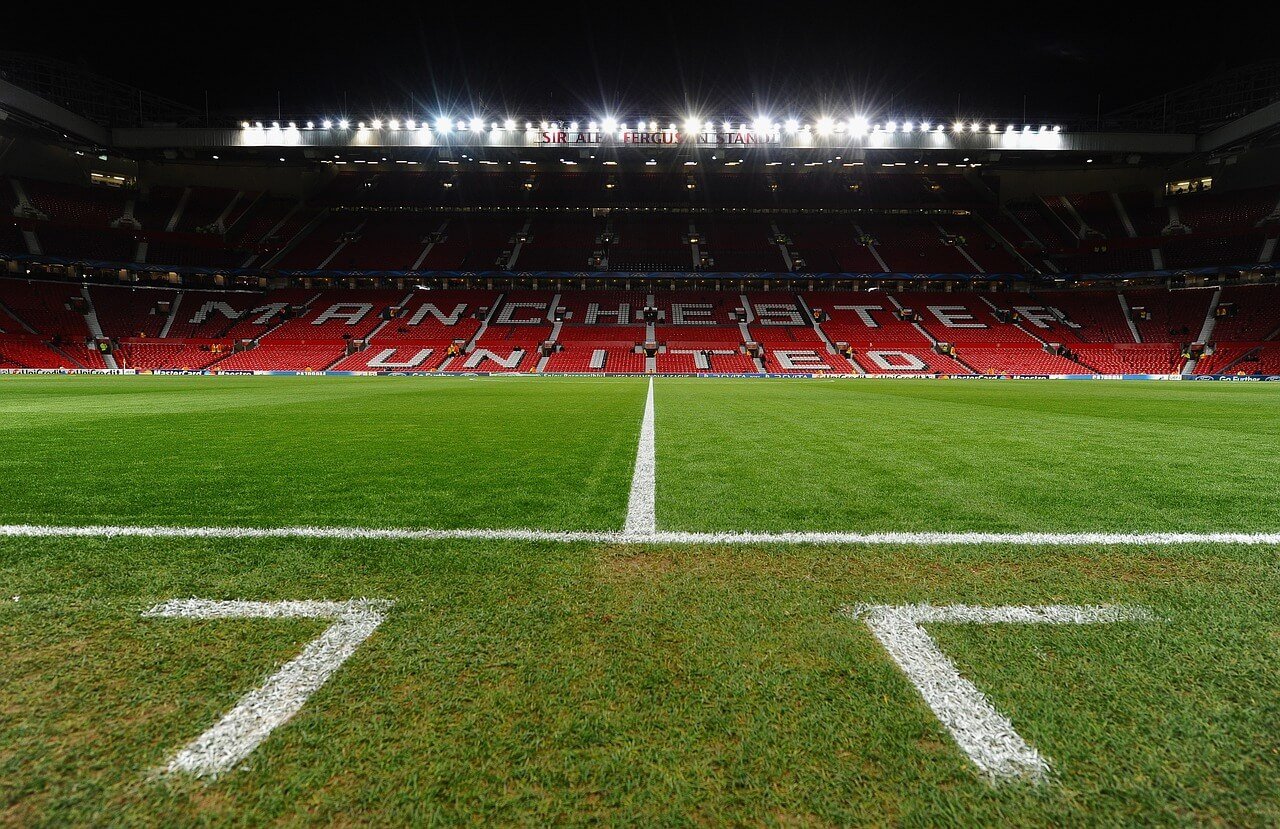
Old Trafford is another iconic stadium, this time situated in Manchester, England. It is of course home of the legendary Manchester United, a club with an unparalleled sporting legacy who have successfully branded itself as the most widely supported and recognised football club in the world (an old joke used to say that United had more fans in Hong Kong than they had in Manchester).
Visitors to Old Trafford can take a guided tour to witness the stadium’s impressive architecture and delve into the club’s storied past, it has to be one of the coolest things to do in Manchester for sure. The museum within the stadium premises houses an extensive collection of memorabilia, allowing fans to relive historic moments.
The serious football aficionados among you also have the option of touring Manchester City’s Etihad Stadium and the UK Football Museum located close to Manchester Victoria train station as part of your Manchester itinerary .
Maracanã Stadium – Rio de Janeiro, Brazil
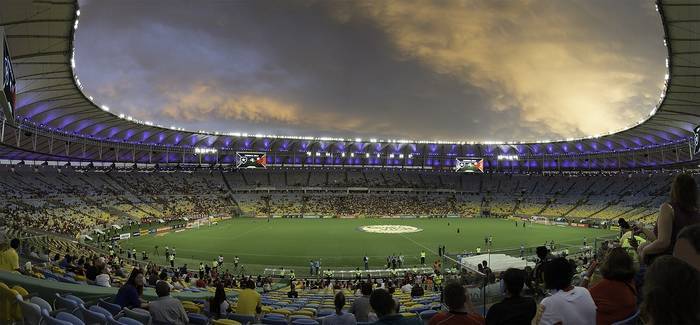
Maracanã Stadium in Rio de Janeiro, Brazil, is widely hailed as the temple of football. This historic venue has witnessed some of the most unforgettable moments in football history, including 2 FIFA World Cup finals. Visiting this incredible place is a must-do when you go backpacking around Brazil !
A tour of Maracanã takes visitors through its remarkable history, and the museum exhibits artefacts that encapsulate the passion and spirit of Brazilian football including a section dedicated to Brazilian football legend Pele who is still hailed as the greatest player the game ever produced.
Wembley Stadium – London, England
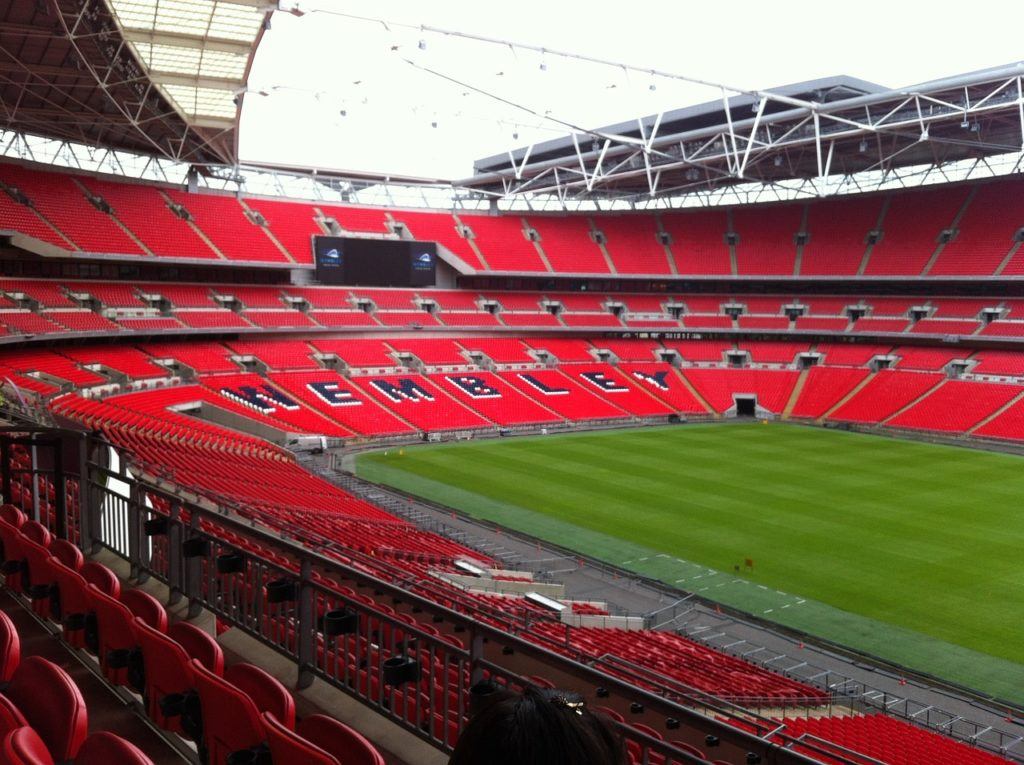
Wembley Stadium, located in London, England, is a truly iconic symbol of British football – it was here in 1966 when England won their one and only World Cup title. So if you’re a football fan, it’s one of the top things to do in London for sure.
This state-of-the-art stadium (rebuilt in 2007) hosts major domestic and international competitions, including the FA Cup final and England national team matches. Visitors can take guided tours to explore the stadium’s impressive facilities and learn about its illustrious past. The Wembley Stadium Tour also offers an immersive virtual reality experience where visitors can step into the shoes of their favorite players and experience the thrill of walking out onto the hallowed Wembley turf.
Allianz Arena – Munich, Germany
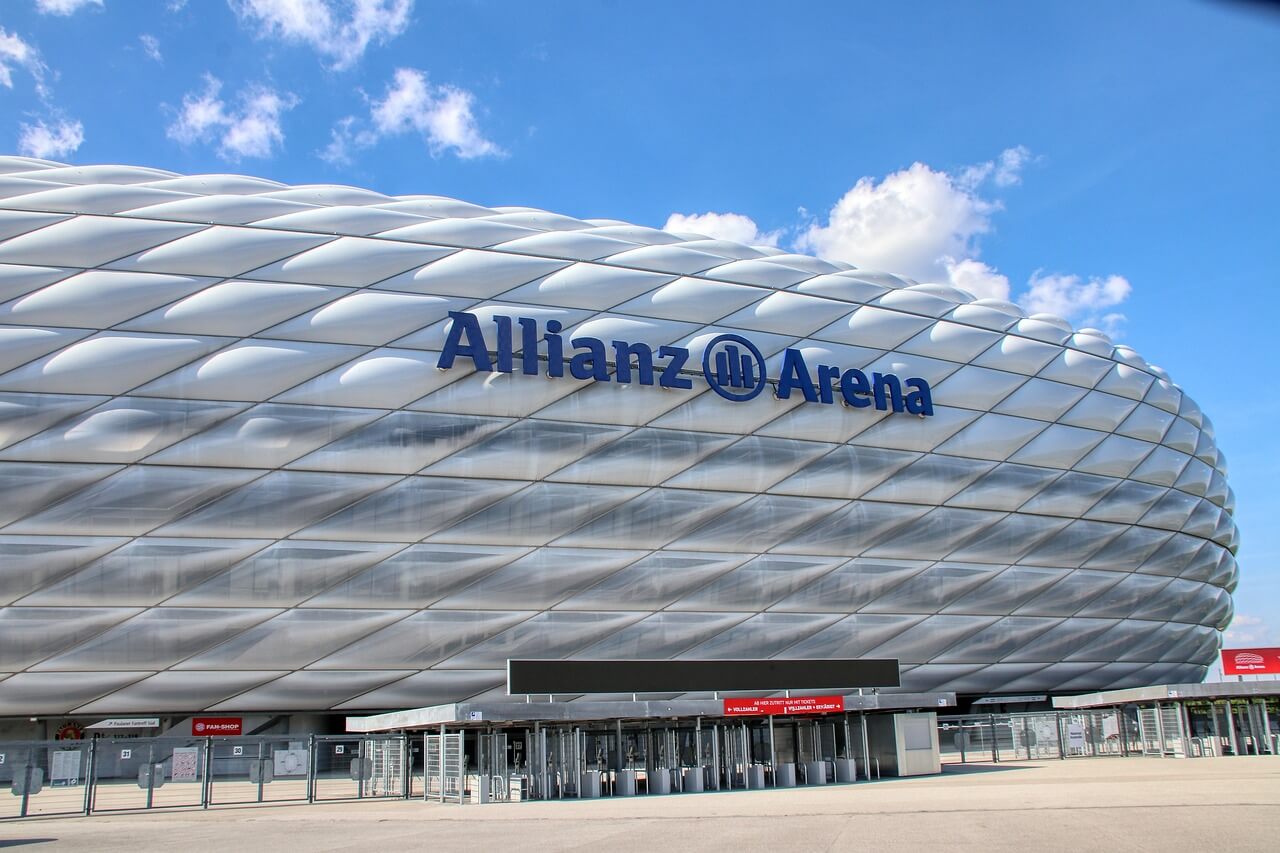
Allianz Arena is a modern masterpiece located in Munich, Germany. This architectural marvel is the home stadium of the mighty FC Bayern Munich who have been kicking arse in the German Bundesliga for decades now.
The stadium’s unique feature is its exterior, which can change colors to reflect the team playing inside. Guided tours provide access to the stands, changing rooms, and the press conference area, allowing visitors to immerse themselves in the world of German football. If you’re a footie fan then you can’t miss this when visiting Munich .
If you want to catch a match during your visit, the good news is that Bayern tickets are significantly cheaper than those of other European titans.

We’ve tested countless backpacks over the years, but there’s one that has always been the best and remains the best buy for adventurers: the broke backpacker-approved Osprey Aether and Ariel series.
Want more deetz on why these packs are so damn perfect? Then read our comprehensive review for the inside scoop!
San Siro – Milan, Italy
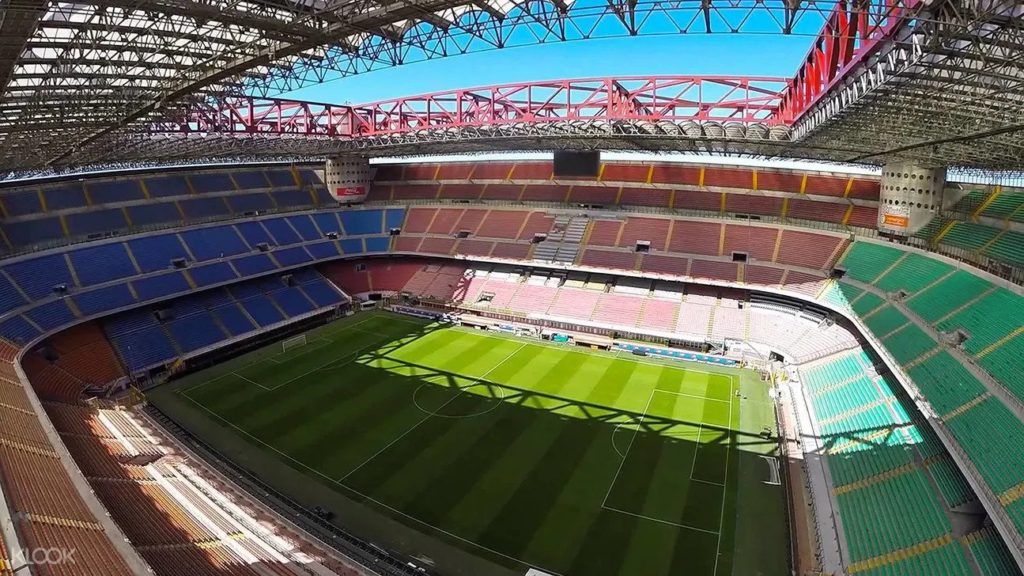
San Siro is an iconic stadium situated in Milan, Italy. It is home to not one but two of Italy’s most successful clubs, AC Milan and Inter Milan (stadium sharing is kinda commonplace in Italy by the way). So it’s one of the most interesting places to visit in Milan .
The stadium, officially known as Stadio Giuseppe Meazza, offers guided tours that take fans behind the scenes, including visits to the players’ tunnel and the pitchside area. The museum inside the stadium showcases the rich history and fierce rivalry between the two Milanese giants.
Be sure to visit soon too, because there are plans afoot for a new mega stadium in Milan .
Emirates Stadium – London, England
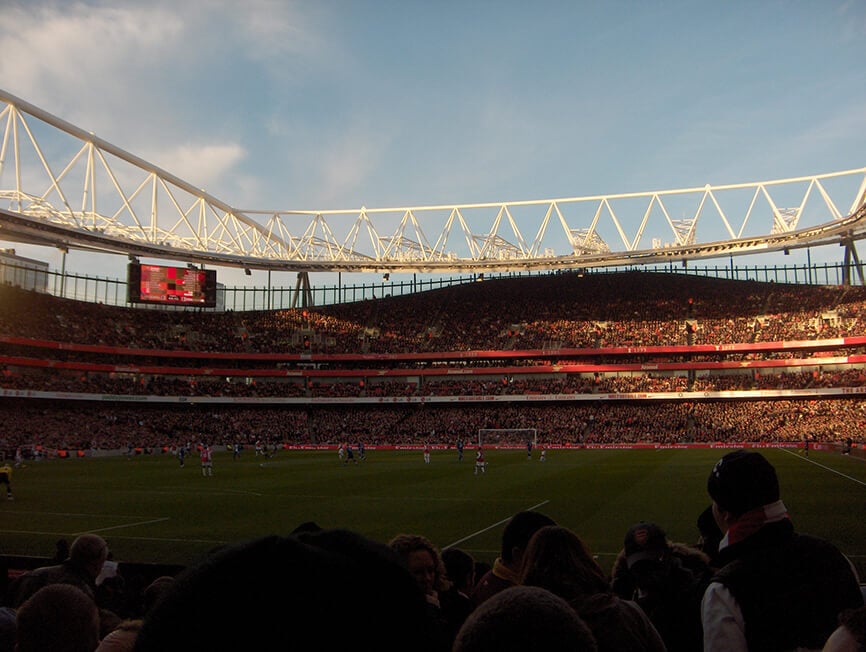
The Emirates Stadium has been the iconic home of Arsenal FC since they left Highbury in 2006. Situated in North-west London, the stadium’s sleek design and modern amenities provide an excellent matchday experience for fans. It’s a great day trip whilst in London .
Emirates Stadium guided tours offer a chance to explore the stadium’s key areas, including the dressing rooms and the pitchside, while also providing insights into Arsenal’s rich history and heritage. Note that London and its boroughs are home to 14 different professional, English league football grounds so if you are in London you stand a strong chance of actually bagging some match tickets.
If you do want to catch a game, why not head over to Go Sport Travel and see if they can hook up with some match tickets?
Estadio Santiago Bernabeu – Madrid, Spain
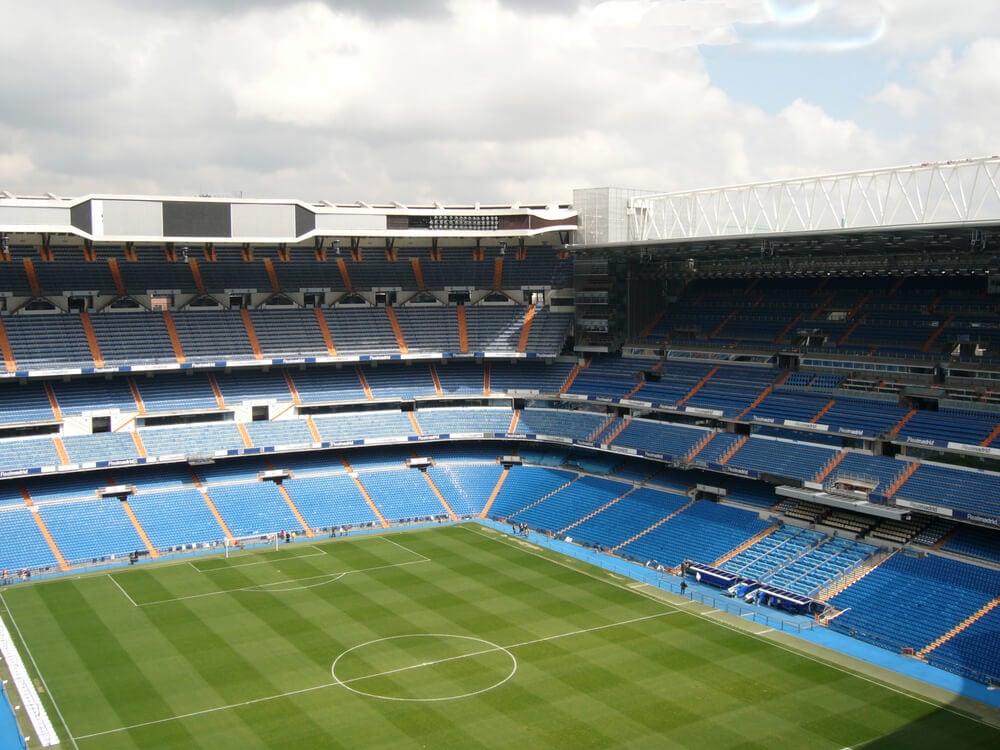
Estadio Santiago Bernabeu, located in Madrid, Spain, is the legendary home of Real Madrid. This majestic stadium has witnessed countless historic moments in football, including numerous UEFA Champions League triumphs.
If you’re wondering whether to pick Madrid or Barcelona when it comes to footballing history, it can be a difficult decision … so do both if you can!
Guided tours allow visitors to explore the stadium’s impressive architecture, walk through the players’ tunnel, and get a glimpse of the club’s trophy room, which showcases the team’s remarkable achievements and it’s a real fun thing to do in Madrid . However, note that the tour may gloss over Real Madrid’s problematic history with Spain’s Fascist Dictator General Franco.
Signal Iduna Park – Dortmund, Germany
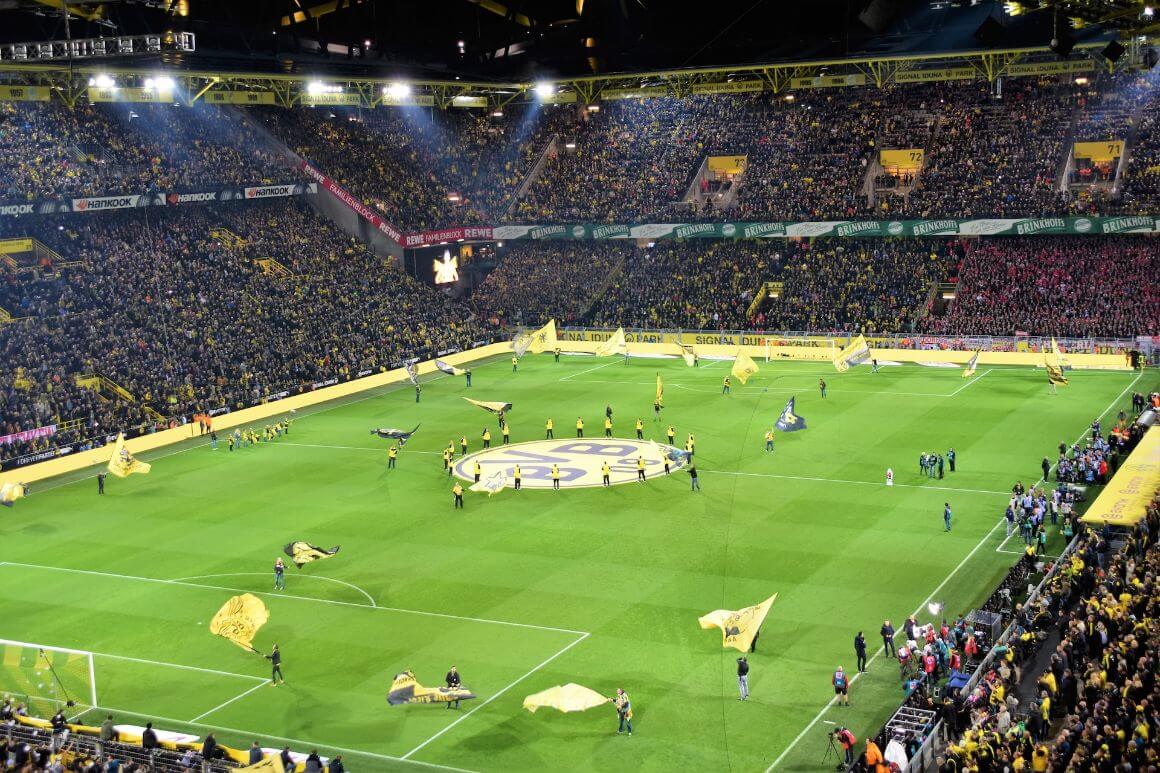
Signal Iduna Park, located in Dortmund, Germany, is home to Borussia Dortmund, one of the most passionate and fervent football clubs in Europe. If Bayern Munich are the poster boy of German football, Dortmund are its edgier but cooler rival.
This atmospheric stadium, also known as “The Yellow Wall,” boasts the highest average attendance in European football. Guided tours allow visitors to experience the electrifying atmosphere of the South Stand, explore the stadium’s facilities, and learn about the club’s loyal fan culture. Be sure to visit Germany during the winter if you want to catch a game.

A new country, a new contract, a new piece of plastic – booooring. Instead, buy an eSIM!
An eSIM works just like an app: you buy it, you download it, and BOOM! You’re connected the minute you land. It’s that easy.
Is your phone eSIM ready? Read about how e-Sims work or click below to see one of the top eSIM providers on the market and ditch the plastic .
Azadi Stadium – Tehran, Iran
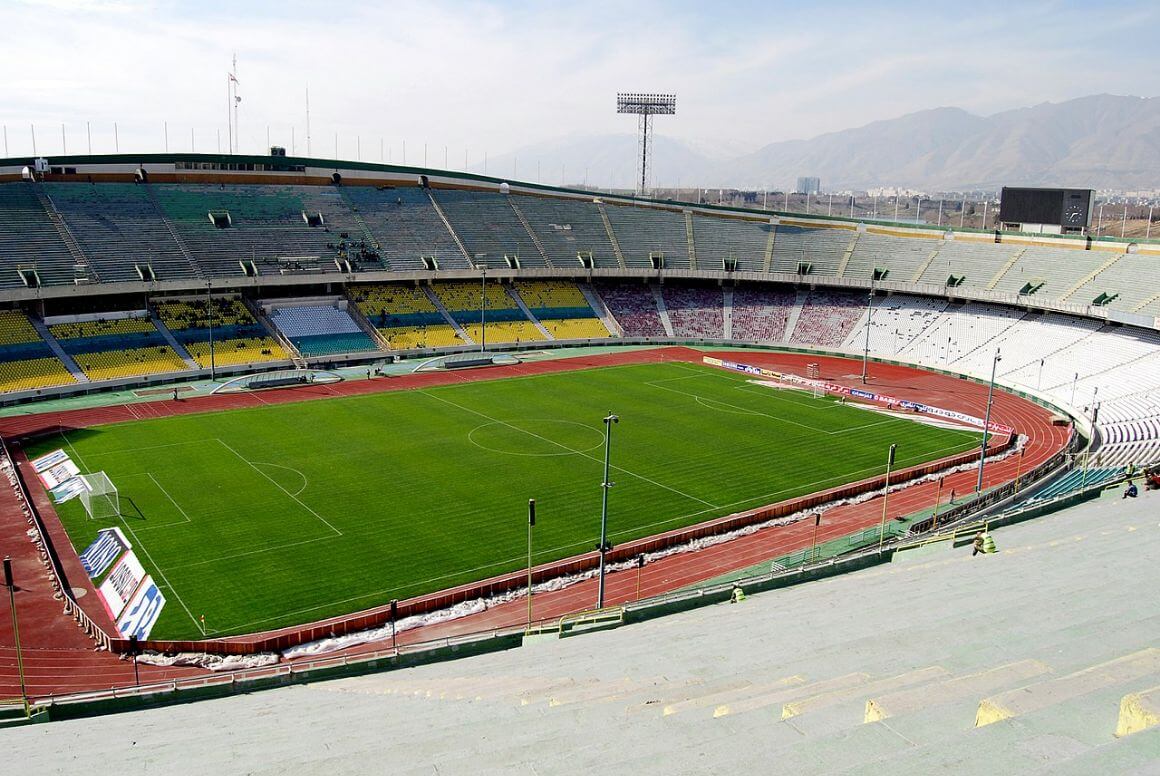
Azadi Stadium in Tehran, Iran, is not only one of the largest stadiums in the world but also holds immense cultural significance. As the home of the Iran national football team, it has witnessed countless historic matches and is one of the most fun and interesting things to do in Tehran .
Visitors can take guided tours to learn about the stadium’s architecture and its role in shaping Iranian football culture. For an insight into how important soccer is in the “complicated” modern Iranian culture, check out the award-winning 2006 film Offside.
Stadio San Paolo – Naples, Italy
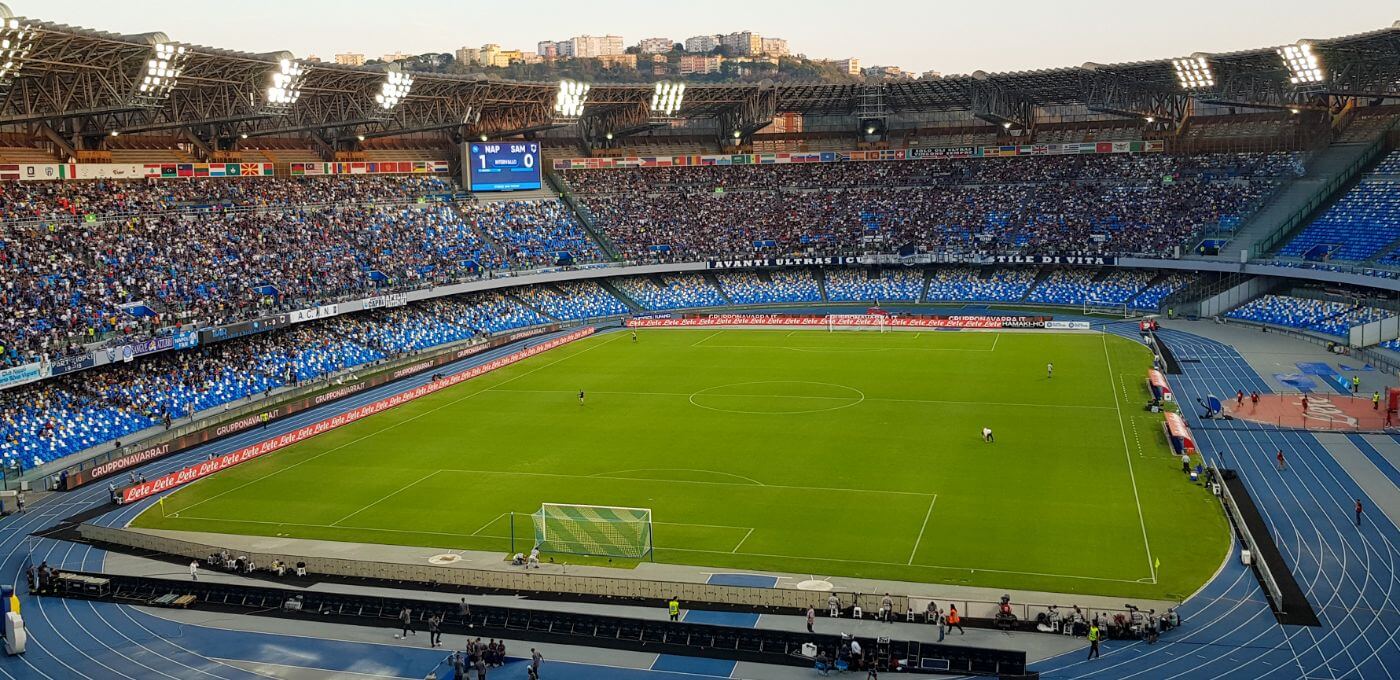
Stadio San Paolo in Naples, Italy, is the legendary home of SSC Napoli, the club synonymous with football icon Diego Maradona and to a lesser extent the Italian Mafia. This stadium has an electric atmosphere, fueled by passionate (see sometimes violent) fans known as the “Tifosi.”
Guided tours are a great thing to do in Naples and offer a glimpse into the club’s history, including Maradona’s unforgettable era, and allow visitors to appreciate the intense football culture that thrives in Naples.
Soccer City Stadium – Johannesburg, South Africa
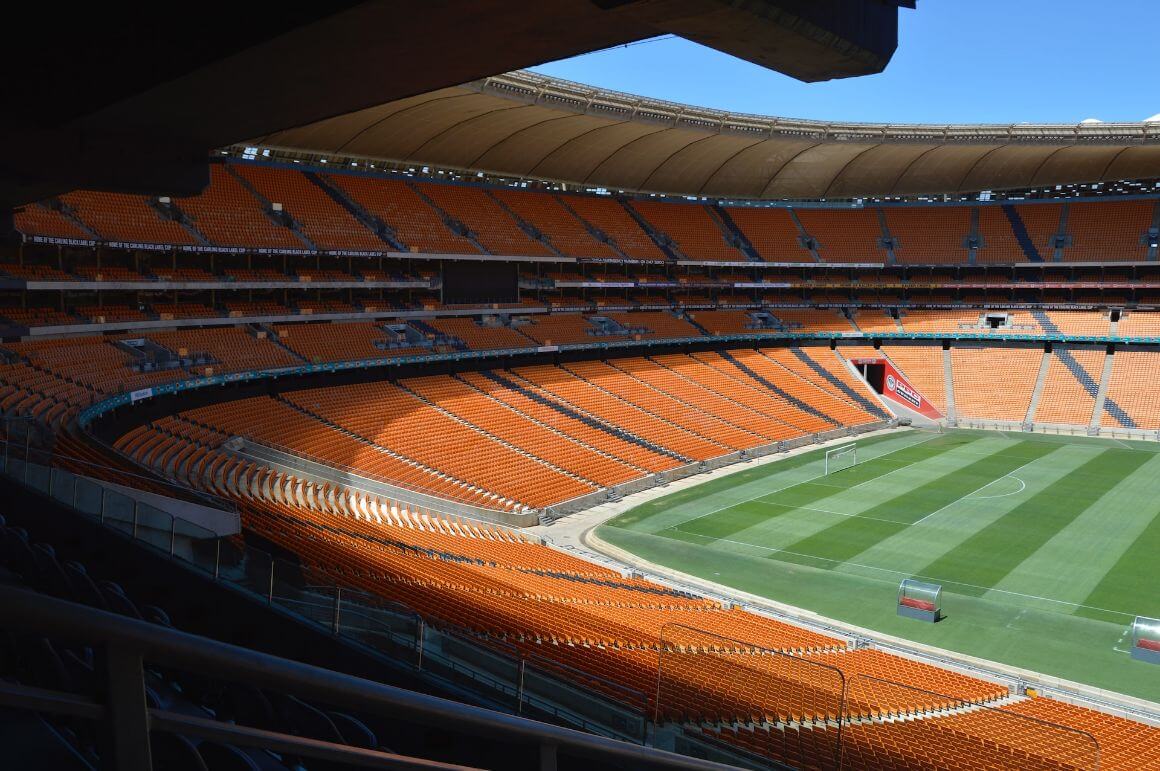
Soccer City Stadium in Johannesburg, South Africa, is a symbol of pride and unity for the nation. It hosted the memorable 2010 FIFA World Cup final and has since become an architectural landmark.
Visitors to Soccer City Stadium can explore the stadium’s vibrant surroundings, appreciate its unique design, and learn about the significant role it played in South African football history. If you’re wondering whether to visit Cape Town or Johannesburg , this stadium might just throw the balance in Joburg’s favour!
Estadio Monumental – Buenos Aires, Argentina
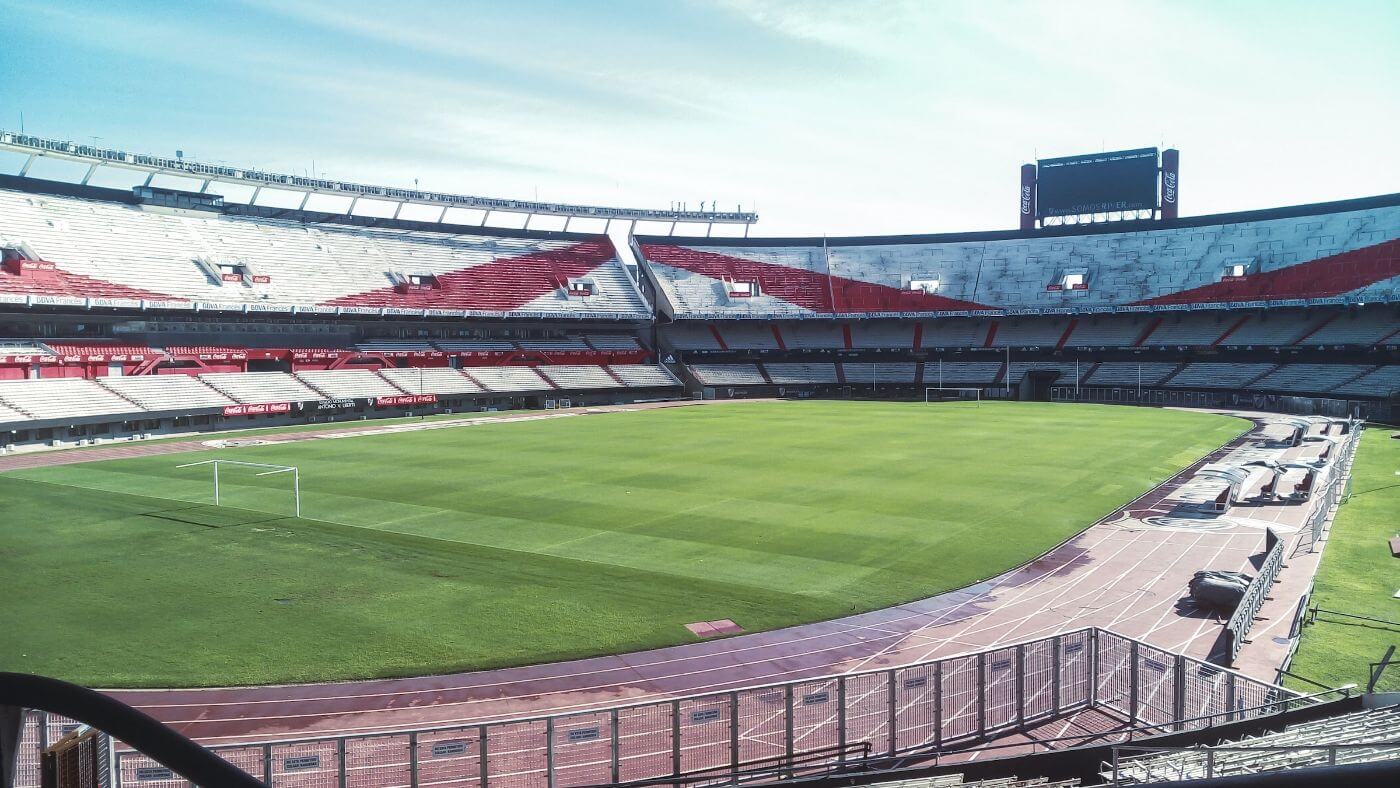
Estadio Monumental, located in Buenos Aires, Argentina, is the revered home stadium of Club Atlético River Plate. It is known for its intense atmosphere and passionate fans – if you ever make it here when they play rivals Boca Juniors then it will be an unforgettable experience on any Buenos Aires itinerary .
Guided tours take visitors through the stadium’s impressive facilities, including the pitch, the players’ tunnel, and the trophy room. The stadium’s museum showcases the club’s rich history and honors its legendary players.

Our GREATEST Travel Secrets…
Pop your email here & get the original Broke Backpacker Bible for FREE.
Anfield – Liverpool, England
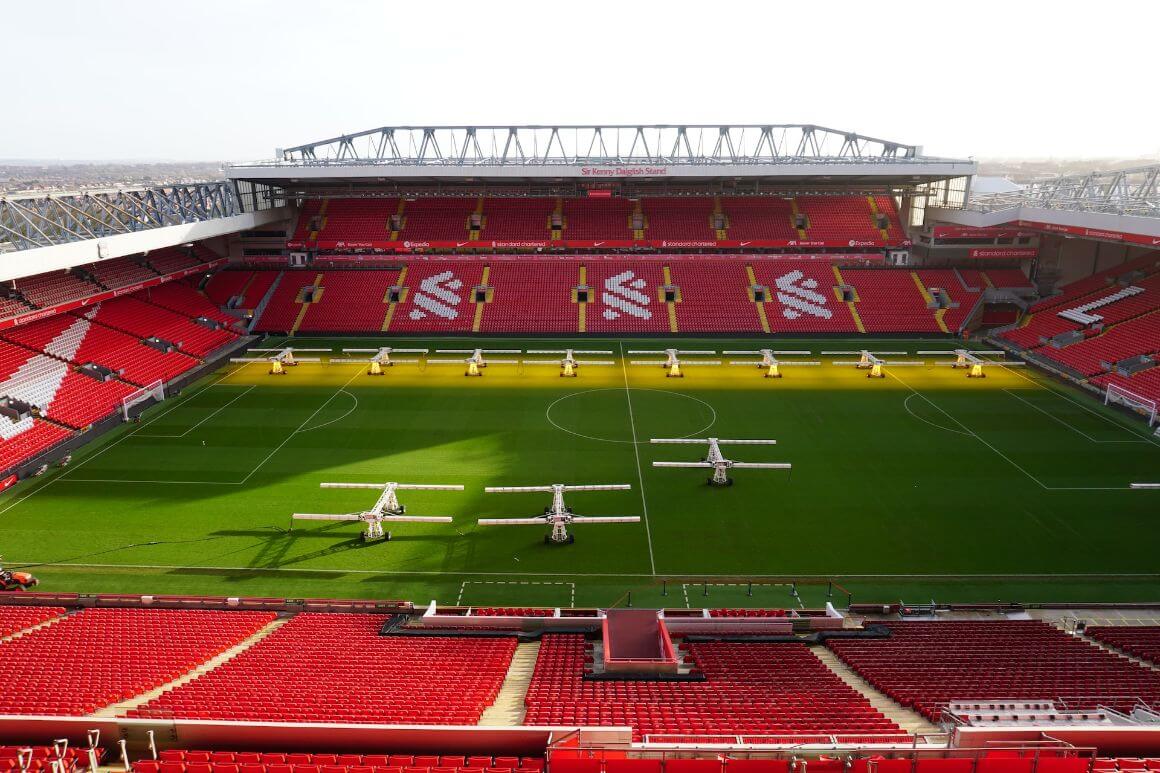
Anfield is the historic home of Liverpool FC, one of the most successful clubs in English football and one of the most loved football teams on earth. Situated in inner city Liverpool, this iconic stadium holds a truly special place in the hearts of football fans worldwide and is a must-do when visiting Liverpool .
Guided tours of Anfield allow visitors to soak in the rich history and traditions of the club. From the famous “This is Anfield” sign to the revered Kop Stand, visitors can explore the stadium’s key areas, including the dressing rooms and the players’ tunnel. The museum at Anfield showcases the club’s glorious past, with exhibits dedicated to legendary players and unforgettable moments.
If you fancy doing the Scouse double, then Everton’s Goodison Park stadium is a short bus ride from Anfield – that is until they move into their new, highly controversial city centre stadium sometime in 2024.
Civitas Metropolitan Stadium – Madrid, Spain
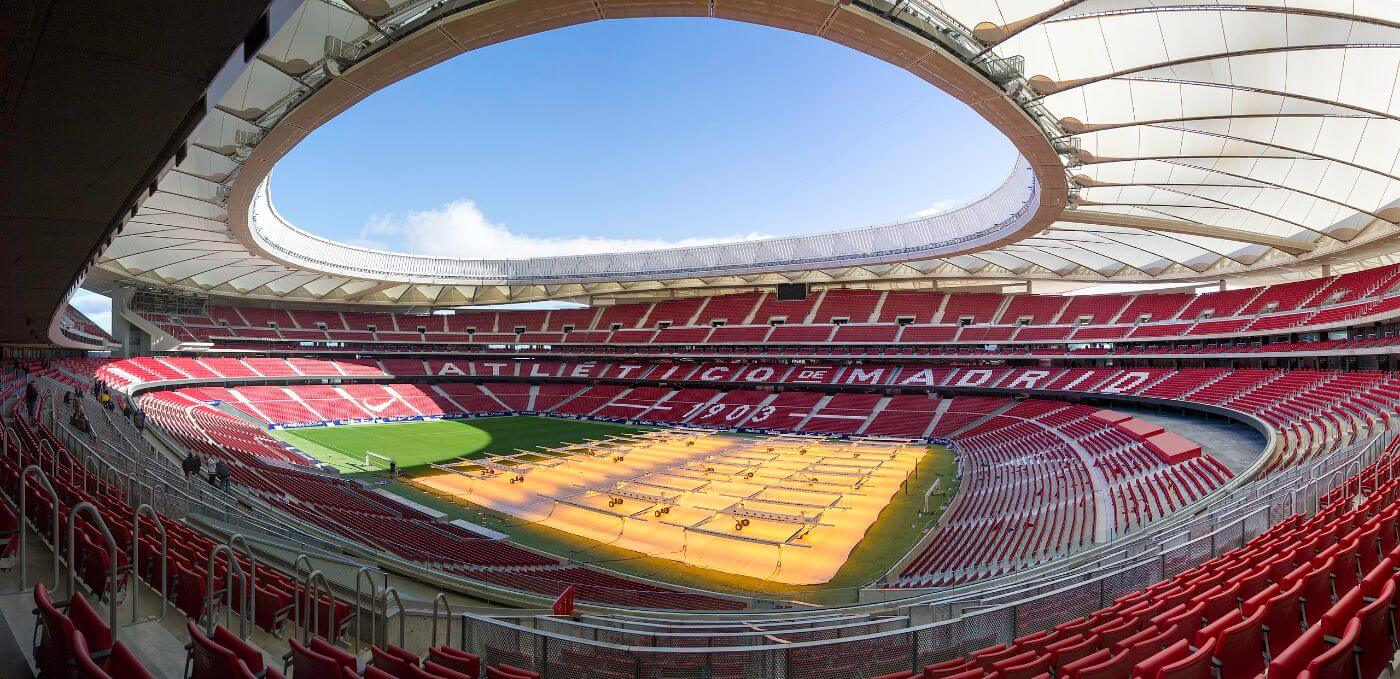
Civitas Metropolitan Stadium in Madrid, Spain, is a modern architectural gem and the home of Atlético Madrid. Known for its unique design and impressive facilities, this stadium offers a remarkable matchday experience.
While Atletico are nowhere near as big or successful as their rivals Real, they are widely considered as the peoples club as opposed to their “Royal” neighbours and are of course free of the problematic links with General Franco. If you happen to be in Madrid over a weekend when they are playing, then you’ll have a much more authentic experience if you manage to catch a game too.
Guided tours of Civitas Metropolitan Stadium provide visitors with a behind-the-scenes glimpse into the inner workings of the club. From the state-of-the-art dressing rooms to the pitchside area, fans can witness the stadium’s grandeur up close. The museum within the stadium showcases the club’s achievements and celebrates its passionate fan base and former greats.
ALWAYS sort out your backpacker insurance before your trip. There’s plenty to choose from in that department, but a good place to start is Safety Wing .
They offer month-to-month payments, no lock-in contracts, and require absolutely no itineraries: that’s the exact kind of insurance long-term travellers and digital nomads need.

SafetyWing is cheap, easy, and admin-free: just sign up lickety-split so you can get back to it!
Click the button below to learn more about SafetyWing’s setup or read our insider review for the full tasty scoop.
Can I buy tickets to watch a match at these stadiums?
While stadiums offer tickets for matches, it can be a lot harder to get match tickets for others. It’s recommended to check the official websites of the respective clubs for ticket availability and purchase well in advance of your visit.
Are guided tours available in multiple languages?
Many stadiums these days provide tours in multiple languages to cater to international visitors. However, it is more common for tours to be offered in the local language, and then English Check the stadium’s official website or inquire beforehand for specific language options.
Can I visit the stadiums on non-match days?
Yes, stadiums usually offer guided tours on non-match days only. It’s advisable to check the tour schedules and book in advance to secure your spot.
Do these stadiums have facilities for disabled visitors?
Most modern stadiums prioritize accessibility and provide facilities for disabled visitors. It’s recommended to contact the stadium’s visitor services or check their website for specific information.
Are photography and filming allowed during the tours?
Photography and filming policies tend to vary from stadium to stadium. Some stadiums allow it, while others may have certain restrictions. It’s best to check the guidelines provided by the stadium or the tour organizers.
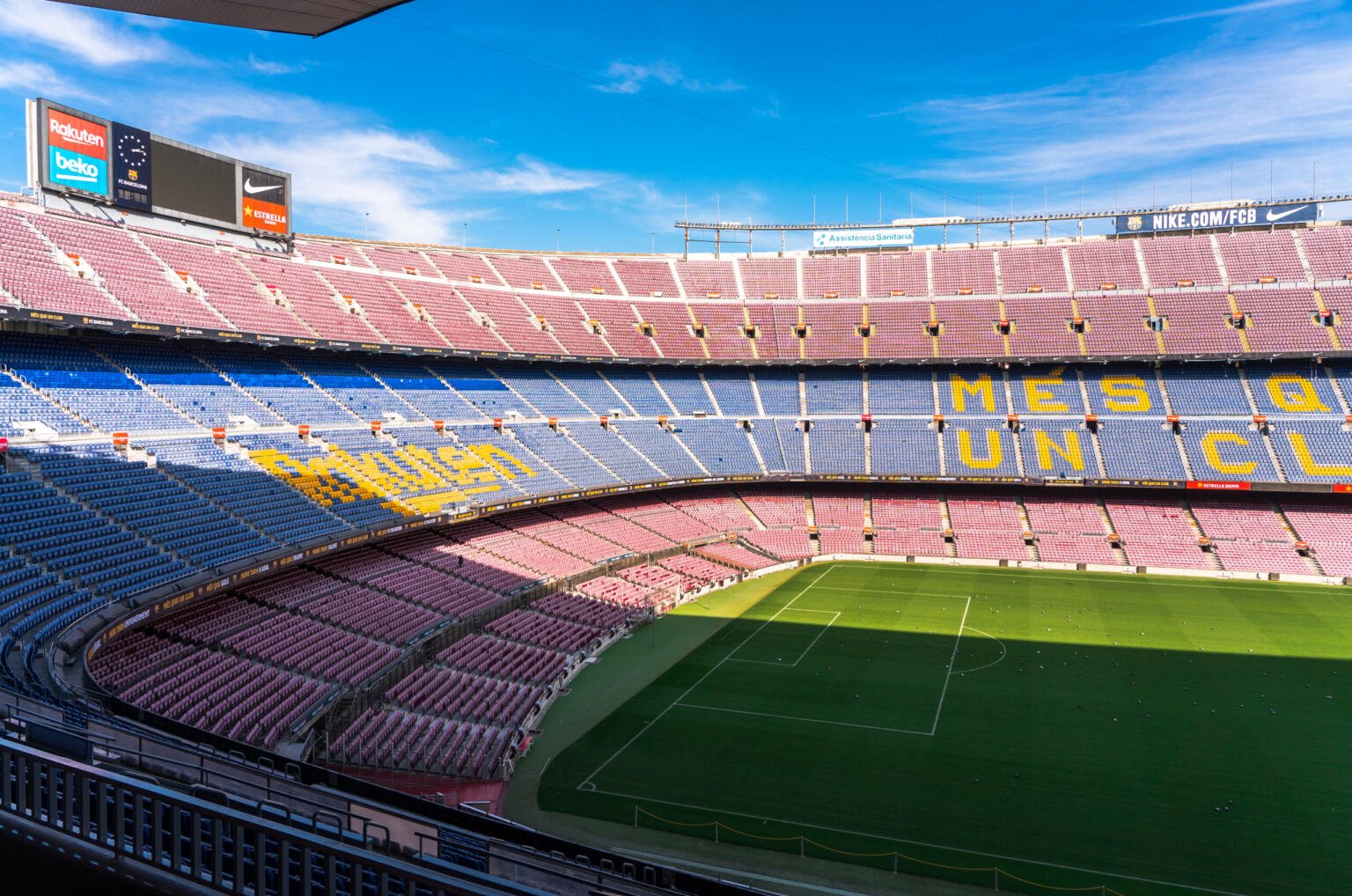
Final Thoughts
Well, exploring the best football stadiums around the world is a dream come true for any football aficionado. These mighty soccer stadiums offer not only thrilling matches but also immersive tours replete with fascinating museums that provide a deeper understanding of the sport’s history and cultural significance.
From the colossal Camp Nou in Barcelona to the historic Maracanã Stadium in Rio de Janeiro, each stadium has its own unique story to tell and captures the essence of football and the local community in its own way.
How was that? Have you visited any of these stadiums? Did we miss your favourite? Let us know in the comments below!

And for transparency’s sake, please know that some of the links in our content are affiliate links . That means that if you book your accommodation, buy your gear, or sort your insurance through our link, we earn a small commission (at no extra cost to you). That said, we only link to the gear we trust and never recommend services we don’t believe are up to scratch. Again, thank you!

Aiden Freeborn

Share or save this post

Leave a Reply Cancel reply
Your email address will not be published. Required fields are marked *
Save my name, email, and website in this browser for the next time I comment.
Notify me of followup comments via e-mail.
Best College Football Stadiums, Ranked
/granite-web-prod/7a/cc/7accf4451bd54b76afdcccb2925b6d1d.jpeg)
College football has never been more popular than it is today — a sports monolith generating billions of dollars each year with rabid fanbases from coast to coast.
For each college football team, so much of their identity is wrapped up in where they play their home games. Some of the stadiums that play home to the very best teams in the nation take on iconic identities forged, in some cases, thanks to over a century of football games played there.
If you're a true college football fan, many of the most well-known stadiums have probably found their way onto your sports bucket list of places to visit before you die.
Here's a look at the best college football stadiums in the U.S., ranked.
25. Milan Puskar Stadium (West Virginia)
/granite-web-prod/0e/3e/0e3ee671a0364f01b42039aaa0af4d48.jpeg)
Location: Morgantown, West Virginia
Capacity: 60,000
Opened: 1980
Bottom Line: Milan Puskar Stadium
/granite-web-prod/2a/98/2a98dc934e1440b895493d94a55b4192.jpeg)
Toss aside all the couch-burning and moonshine jokes about West Virginia football, and you have a consistently above-average football program with a stadium that is the focal point of the entire state on game days.
Take this into account — during games when Milan Puskar Stadium is at its listed capacity of 60,000, it has a higher population than either of the state's two largest cities of Charleston (48,864) and Huntington (46,842). Which is pretty awesome.
24. Folsom Field (Colorado)
/granite-web-prod/8a/62/8a6275d320c04b669f47e3db1cbc3281.jpeg)
Location: Boulder, Colorado
Capacity: 50,183
Opened: 1924
Bottom Line: Folsom Field
/granite-web-prod/51/62/5162a61ff1654f4daccdbc0737239bcf.jpeg)
The big-swing, hot-take addition to this list is Colorado's Folsom Field. Despite coming off a season in which the Buffs went 1-11, you cannot deny the buzz that's been building in Boulder with the hiring of head coach Deion Sanders . College football old-heads understand what an absolute joy it was to watch games here in Colorado's glory years in the 1980s and 1990s. The hiring of Sanders sparked a ticket-buying frenzy that saw season tickets sell out for just the ninth time in school history.
That said, Colorado also has one of the great traditions in college football with Ralphie, the live buffalo mascot for the school that gets to run around the field with handlers before and at halftime of each game.
23. Albertsons Stadium (Boise State)
/granite-web-prod/c2/f6/c2f675330299450b86e9bcee811bb42f.jpeg)
Location: Boise, Idaho
Capacity: 36,387
Opened: 1970
Bottom Line: Albertsons Stadium
/granite-web-prod/00/18/00182e3a635c475984ba105d04fdb7b2.jpeg)
Yes, the blue turf at Boise State's Albertsons Stadium is awesome and almost worth the trip alone. But if the team that played on it sucked, the blue turf would just be an oddity.
Thankfully, Boise State has been one of college football's best programs over the last 25 years. Since their last losing season in 1997, the Broncos have gone undefeated twice, had six one-loss seasons and won at least 10 games in a season 18 times. You don't have that type of success without having a great home fanbase and a great home stadium.
22. Rice-Eccles Stadium (Utah)
/granite-web-prod/3b/10/3b10318dc2564bd99110d31f92da0f84.jpeg)
Location: Salt Lake City, Utah
Capacity: 51,444
Opened: 1998
Bottom Line: Rice-Eccles Stadium
/granite-web-prod/fe/f1/fef1f684a6354982b1b759dd4d229cc2.jpeg)
The newest stadium on this list, Utah's Rice-Eccles Stadium has been home to some pretty wonderful football over the last 25 years — remember that Utah was the first team outside of the Power Five Conferences to receive a bid to a BCS bowl game.
You have to have a pretty amazing fanbase to move from a mid-major conference (WAC) to a better mid-major conference (MWC) to a Power Five (Pac-12) to another Power Five (Big 12), and that's all happened since Rice-Eccles opened.
21. Husky Stadium (Washington)
/granite-web-prod/4d/e7/4de75e336dc244568fdec532725070fd.jpeg)
Location: Seattle, Washington
Capacity: 70,138
Opened: 1920
Bottom Line: Husky Stadium
/granite-web-prod/f7/6b/f76b99843c144c8ba9c3bcfe13bff9b2.jpeg)
Husky Stadium has been home to Washington's football team for over a century and has seen some pretty amazing football — most notably a pair of national championships in 1960 and 1991.
What's more unique about Husky Stadium is, even if you take out all of that winning, you still have a pretty amazing place to watch a football game with its U-shaped design opening up to views of Lake Washington and the Cascade Mountains. So many vibes.
20. LaVell Edwards Stadium (BYU)
/granite-web-prod/a4/b6/a4b6f746185148c6aa98411d8be04425.jpeg)
Location: Provo, Utah
Capacity: 63,470
Opened: 1964
Bottom Line: LaVell Edwards Stadium
/granite-web-prod/33/24/3324401e0b114f4fb3f076cf18934252.jpeg)
Renamed for former head football coach LaVell Edwards upon his last home game in 2000, BYU's home field has been part of big-time college football moments long before joining the Big 12 in 2023.
If you want to know something about BYU fans, take into account that Cougar home games have had the largest average home attendance for any college football team in the West — including Pac-12 schools — since 2021.
19. Nile Kinnick Stadium (Iowa)
/granite-web-prod/dc/30/dc30a42e8e484864a178c8afd41d7558.jpeg)
Location: Iowa City, Iowa
Capacity: 69,251
Opened: 1929
Bottom Line: Nile Kinnick Stadium
/granite-web-prod/c0/c8/c0c8c25f9f3c4766b70b77fedb75ee63.jpeg)
Iowa has the only college football stadium named for a Heisman Trophy winner — Nile Kinnick won the award in 1939 and died fighting in World War II.
The football here has been good to pretty great over its lifetime — hardly ever truly bad — and games here took on a new meaning beginning in 2017. That's when fans turned their phones on and waved at the kids in The University of Iowa Children's Hospital, which overlooks the field.
18. Camp Randall Stadium (Wisconsin)
/granite-web-prod/f7/44/f74434efc5fd40099a92d87e1d35d051.jpeg)
Location: Madison, Wisconsin
Capacity: 80,321
Opened: 1917
Bottom Line: Camp Randall Stadium
/granite-web-prod/fb/3b/fb3bdff765574815aaf8bec0b814497e.jpeg)
In over 100 years of football at Camp Randall Stadium, there's one tradition that overshadows all others and is among the greatest in all of sports.
Since 1993, when Wisconsin plays home games, House of Pain's "Jump Around" plays between the end of the third quarter and the start of the fourth quarter, and the student section becomes the only place in the universe. That's goosebumps time in Madison. What a wonderful feeling.
17. Doak Campbell Stadium (Florida State)
/granite-web-prod/48/77/4877991c1f1e4ee5969eb4bc1301282a.jpeg)
Location: Tallahassee, Florida
Capacity: 79,560
Opened: 1950
Bottom Line: Doak Campbell Stadium
/granite-web-prod/98/64/98644c0fbf06496d8ec74d5b4cb71d07.jpeg)
Florida State football has very much been in flux over the last five years, but if you were paying attention to college football at the end of the 2022 regular season, you got to see Doak Campbell Stadium at its full power. After all, this is the place that made a whole generation fall in love with college football in the early 1990s.
When it's really hot outside and the football is good, you can't beat seeing a game here.
16. Gaylord Family Oklahoma Memorial Stadium (Oklahoma)
/granite-web-prod/d6/6c/d66c0c1780cf458aa247f5a6669ed39a.jpeg)
Location: Norman, Oklahoma
Capacity: 80,126
Opened: 1923
Bottom Line: Gaylord Family Oklahoma Memorial Stadium
/granite-web-prod/16/eb/16ebbb31c2084eb58b6d0231c4822289.jpeg)
While some might have reservations about Oklahoma ending its 103-year association with the Big 12 Conference following the 2023 season, it's not much of a stretch to think home games will still be super-duper lit at Gaylor Family Oklahoma Memorial Stadium with a recurring roster of SEC teams coming to visit.
This is a great place to watch college football — if the team is average or bad like they were in 2022, that could change quickly. We'll give them the benefit of the doubt for now.
15. Darrell K. Royal-Texas Memorial Stadium (Texas)
/granite-web-prod/27/58/27582835100a48aea5647bfb4dba57b7.jpeg)
Location: Austin, Texas
Capacity: 100,119
Bottom Line: Darrell K. Royal-Texas Memorial Stadium
/granite-web-prod/78/42/7842db18895c4a77825596b00cf742c2.jpeg)
The official capacity for Darrell K. Royal-Texas Memorial Stadium might be listed at just a smidge more than 100,000, but the Longhorns managed to squeeze just more than 105,000 for a game against Alabama in September 2022 — an enticing look at what life will be like when Texas joins the SEC in 2024.
This is the marquee stadium for the marquee college football program in the state where football matters the most. All that's missing now is a good team.
14. Autzen Stadium (Oregon)
/granite-web-prod/8d/b2/8db2a79a2fda4d079c5a3e4319b1cf6c.jpeg)
Location: Eugene, Oregon
Capacity: 54,000
Opened: 1967
Bottom Line: Autzen Stadium
/granite-web-prod/fb/fb/fbfb7c3a76374f2486095786cf944708.jpeg)
A lot of the stadiums that made this list made it on vibes alone — how it makes us feel when we're tailgating or attending a game or even how we feel just watching a game on television. Oregon's Autzen Stadium has amazing vibes.
While vibes are one thing, having a great football team is another, and Oregon becoming one of the nation's best teams over the last 20 years contributes to that. It also contributes to the school being able to justify upgrades to Autzen and Nike being able to justify making a unique uniform for every single game.
13. Ben Hill Griffin Stadium (Florida)
/granite-web-prod/ea/2d/ea2dbafc4fbb48c79245b595ad2ea49b.jpeg)
Location: Gainesville, Florida
Capacity: 88,548
Opened: 1930
Bottom Line: Ben Hill Griffin Stadium
/granite-web-prod/64/4b/644b478596d446c3981a08a641228643.jpeg)
If you watched Netflix's documentary, "Swamp Kings," on the Urban Meyer years at Florida, you got to see what "The Swamp" is like in all of its steamy glory.
While there haven't been many opportunities in recent years for Florida fans to really stretch the limits of Ben Hill Griffin Stadium, you have to give them credit for coming back to the Gators no matter what. They're the Nebraska fans of the south.
12. Neyland Stadium (Tennessee)
/granite-web-prod/60/fd/60fdb529724c46f5a47ba96282ef9833.jpeg)
Location: Knoxville, Tennessee
Capacity: 101,915
Opened: 1921
Bottom Line: Neyland Stadium
/granite-web-prod/3a/0e/3a0efe85fd224679a113f54f8f93241a.jpeg)
The full power of Tennessee's Neyland Stadium was finally on display for all to see when the Vols took down No. 3 Alabama at home in 2022. Tennessee's first win over the Crimson Tide since 2006 resulted in both goalposts being torn down and thrown in the Tennessee River along with a $100,000 fine from the SEC for fans storming the field.
Tennessee fans donated $152,000 in the following 24 hours to pay the fine and replace the goalposts. Neyland Stadium's not higher on this list only because football at Tennessee has been objectively awful for most of the last 20 years — a stretch that includes nine losing seasons and three more seasons when the Vols finished just one game over .500.
11. Michigan Stadium (Michigan)
/granite-web-prod/f6/61/f6617f7dacac490eb5f5570aa4459555.jpeg)
Location: Ann Arbor, Michigan
Capacity: 107,601
Opened: 1927
Bottom Line: Michigan Stadium
/granite-web-prod/3f/81/3f8158d3637544adb23d7e7c21f20a4b.jpeg)
Michigan football is once again among the nation's elite teams — the stadium it plays in took no such break.
Remember going to see a game here isn't just a unique experience for college football because of its capacity seating of over 107,000 fans. It's a unique experience because you're in one of the biggest stadiums in the entire world.
10. Bryant-Denny Stadium (Alabama)
/granite-web-prod/53/46/5346f7a3663745c19e560c205fbb2f63.jpeg)
Location: Tuscaloosa, Alabama
Capacity: 101,821
Bottom Line: Bryant-Denny Stadium
/granite-web-prod/fa/ea/faea46f9507a4f6e9e10ab211578c8d1.jpeg)
There's nothing particularly attractive about Bryant-Denny Stadium in its physical appearance — it's pretty bland architecture — but the team that plays here will really blow your mind.
Under head coach Nick Saban, Alabama has won six of its 18 national championships in the last 14 years, creating perhaps the greatest dynasty in college football history.
9. Kyle Field (Texas A&M)
/granite-web-prod/06/7f/067fb2dd9f5040168a3169d120b75c69.jpeg)
Location: College Station, Texas
Capacity: 102,733
Bottom Line: Kyle Field
/granite-web-prod/1c/a2/1ca24756651b400e95ddc5dd39e9aa20.jpeg)
There's a grey area between listed capacity and how many people a stadium can actually fit if it were stretched to its outermost parameters. This was never more underlined than by Texas A&M's Kyle Field packing just over 110,000 fans in for a game against Ole Miss in 2014 — some 8,000 more fans than its listed capacity.
While some of us might say, "Hey, that might not be the smartest thing to do," please remember … this is Texas. They do what they want, building and fire codes be damned.
8. Memorial Stadium (Clemson)
/granite-web-prod/3f/0d/3f0def3344e8411ba66585c5e672a72f.jpeg)
Location: Clemson, South Carolina
Capacity: 82,000
Opened: 1942
Bottom Line: Memorial Stadium
/granite-web-prod/97/e9/97e9d19b7e444490a69f8c02a605c5aa.jpeg)
Few experiences in college football can compare to going to Death Valley — the nickname of Clemson's stadium — and seeing the team stand perched above the field at Howard's Rock, ready to "Run Down the Hill" before a game.
Made famous when Brent Musburger referred to it as "the most exciting 25 seconds in college football" in 1985, it's taken on even more meaning since Dabo Swinney took over as head coach in 2008. Since then, the Tigers have won two national championships, been national runner-up two more times and won eight ACC titles.
7. Memorial Stadium (Nebraska)
/granite-web-prod/7e/d4/7ed4173e0a7445d59b12e2f2059499cc.jpeg)
Location: Lincoln, Nebraska
Capacity: 85,458
/granite-web-prod/a0/35/a0358c87377e4244961ba5384426ee0c.jpeg)
The most loyal fans in college football belong to the Nebraska Cornhuskers, who have stayed with the team despite abandoning almost a century's worth of rivalries and traditions when they went to the Big Ten and despite being below average to bad over the last decade.
To underline that point, Nebraska has sold out every game since 1962.
6. Jordan-Hare Stadium (Auburn)
/granite-web-prod/73/2c/732c50bef6f647b4b4fe7ea1b3aab5b3.jpeg)
Location: Auburn, Alabama
Capacity: 88,043
Opened: 1939
Bottom Line: Jordan-Hare Stadium
/granite-web-prod/e8/3b/e83bce94843f4f1091f7f5e1ca2a08e7.jpeg)
Few stadiums on this list can say what would happen if you packed them full of people and stress-tested that capacity seating by having the most bananas thing that could possibly happen occur — which is what happened on Nov. 30, 2013, at Jordan-Hare Stadium when Auburn's Chris Davis returned a missed field goal 109 yards as time expired to defeat No. 1 Alabama in the Iron Bowl.
It's the greatest finish to a college football game ever and arguably the greatest finish to any football game ever. And it happened at Jordan-Hare!
5. Ohio Stadium (Ohio State)
/granite-web-prod/6b/51/6b5117bddd8a458dbd404f2a1dd4c6f3.jpeg)
Location: Columbus, Ohio
Capacity: 102,780
Opened: 1922
Bottom Line: Ohio Stadium
/granite-web-prod/ed/64/ed64d51b10c24531a3ae3bda3abae80f.jpeg)
"The Horseshoe" has some of the most aesthetically pleasing architecture in college football — if we're going to describe the look of any stadium as epic, it'd be this one.
But one weird fact about Ohio Stadium is that the Buckeyes weren't able to play regular night games for the first 92 years of playing here until permanent lighting was installed in 2014.
4. Sanford Stadium (Georgia)
/granite-web-prod/ef/2a/ef2ae31a8cad4877bc45c3f6ab461b30.jpeg)
Location: Athens, Georgia
Capacity: 92,746
Bottom Line: Sanford Stadium
/granite-web-prod/c9/36/c93616e9c5ea4f918ae2e363d23890cf.jpeg)
The things that make a great college football stadium seem mostly composed of several quickly distinguishable elements, all of which you can find at Georgia's Sanford Stadium.
Unique features? The privet hedges around the field are among the most recognizable in-stadium accouterments in all of sports, not just college football. Playing games "between the hedges" is a sports colloquialism we all know.
Great aesthetics? The west end of the stadium opens up to the campus and the rolling Georgia hills.
Great team? Georgia has won back-to-back College Football Playoff national championships headed into the 2023 season and has had just one losing season in the last 25 years.
3. Beaver Stadium (Penn State)
/granite-web-prod/b5/7b/b57bd238238948e59c04f2a4b3c0e8bc.jpeg)
Location: University Park, Pennsylvania
Capacity: 106,572
Opened: 1959
Bottom Line: Beaver Stadium
/granite-web-prod/b2/3f/b23f20288e7b466b98f4ead52a99bc84.jpeg)
If we're going totally binary, the thing to point out about Penn State's Beaver Stadium is it's the fourth-largest stadium in the entire world, which is amazing.
If we're going off pure vibes, turn on your television on a Saturday and watch Beaver Stadium during a whiteout game. It's one of the more amazing home-field advantages a team can have, which makes playing here a nightmare for opposing teams.
2. Tiger Stadium (LSU)
/granite-web-prod/54/37/543757525d464a2b9246b325b73119ef.jpeg)
Location: Baton Rouge, Louisiana
Capacity: 102,321
Bottom Line: Tiger Stadium
/granite-web-prod/5a/82/5a820cde4a4e4fb687460bf9621b3a08.jpeg)
According to legend, LSU picked purple and gold as its colors before its first game in 1893 — a 34-0 loss to Tulane in New Orleans in front of a crowd of around 1,000 — because those were Mardi Gras colors and because the team distinguished its colors with ribbons and the green ribbons were sold out.
Games for LSU are a much different experience in 2023. Fans who visit Tiger Stadium will literally feel the earth move underneath their feet when the 102,000-plus in attendance get warmed up. So, if you want to understand what college football means in the South, go to an LSU home game. Or just watch this video of Heisman Trophy winner Joe Burrow's entrance into the stadium on Senior Night.
1. Notre Dame Stadium (Notre Dame)
/granite-web-prod/77/79/77794b6355d740e192a53513172b9203.jpeg)
Location: South Bend, Indiana
Capacity: 77,622
Bottom Line: Notre Dame Stadium
/granite-web-prod/ab/6e/ab6e70d11c564e5f9e5c6099de55de3d.jpeg)
As Notre Dame Stadium closes in on its 100th anniversary, it still retains kind of a mythical status among college football stadiums. How many stadiums on this list can you really call "bucket list" trips? Not many. And Notre Dame Stadium is at the top of the list.
Go see a game when it's cold. Ply yourself with hot cocoa ... or whatever liquid you think will keep you warm. Take a pick with Rudy outside of the bookstore. You won't regret it.
The best football stadiums in the world
From England to Argentina, Italy to Iran, these are the best places to watch football on the planet
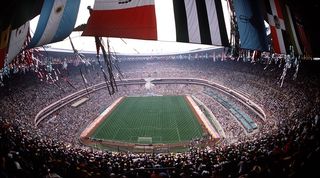
Looking for some additions to your bucket list? Well then you've come to the right place.
We've picked out the best football stadiums in the world, ranking a variety of grounds from all four corners of the planet based on factors such as aesthetics, atmosphere and history.
Fetch your passport, and let the countdown begin...
32. Saitama Stadium 2002

Opened in 2001 ahead of the World Cup the following year, the Saitama Stadium hosted four matches at the tournament.
Now home to Japanese outfit Urawa Red Diamonds, the 63,700-capacity arena creates quite the din when it’s full. It’s no coincidence that Japan play most of their competitive home games here.
31. Olympiastadion
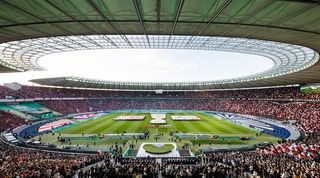
Dating back to 1936, the Olympiastadion has a rich but not always pretty history - swastikas and Nazi salutes abounded when it was used for the Summer Olympics that year.
Now the home ground of Hertha Berlin , it staged the 2006 World Cup final after undergoing a major renovation ahead of the tournament.
Get the FourFourTwo Newsletter
The best features, fun and footballing quizzes, straight to your inbox every week.
30. Stadio Luigi Ferraris
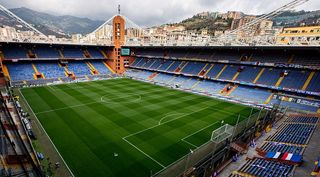
Not the most famous of Italian grounds, perhaps, but the Luigi Ferraris is the oldest still in use for football. Constructed in 1911, it has been Genoa ’s home from day one before opening its doors to Sampdoria after World War Two.
It’s often described as an English-style ground, chiefly because of the absence of a running track.
29. Estadio Municipal de Braga

How many stadiums can you name that are carved into a mountain? It’s a distinction claimed by the Estadio Municipal de Braga, the work of an architect named Eduardo Souto de Moura, who won a prestigious award for his daring design.
A unique setting to watch football, it hosted two matches at Euro 2004.
28. Allianz Stadium
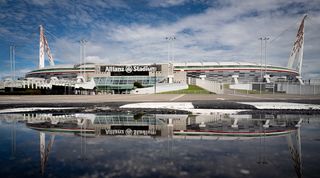
After a miserable time at the unloved Stadio delle Alpi, Juventus moved into their current home - a football-specific ground, unlike the soulless Alpi - in 2011.
The club deliberately chose a relatively low capacity of 41,507 to ensure the atmosphere didn’t get lost in vast stands. The facilities are top notch, which isn’t always the case in Italy.
27. Gelora Bung Karno Stadium
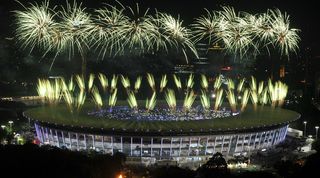
Indonesians have a passion for football that’s virtually unmatched elsewhere in Asia. The impressive Gelora Bung Karno Stadium, which can hold in excess of 77,000 fans, regularly sells out when the national team is playing.
It’s also home to Persija Jakarta, one of the biggest clubs in the country.
26. Sukru Saracoglu Stadium

If you’re looking for a red-hot atmosphere no matter the opposition, book yourself a ticket to football-mad Istanbul.
Fenerbahce ’s stadium edges out those of Galatasaray and Besiktas because of its longer history. The Sukru Saracoglu, named after a former Turkish prime minister, has been refurbished on several occasions but first opened way back in 1908.
25. Estadio Centenario
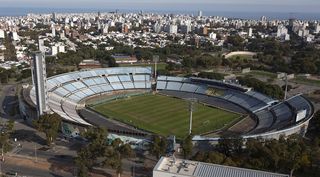
The Estadio Centenario won’t be winning any beauty contests any time soon, but this is one of the most significant grounds in the history of the game.
Almost a century on from its inauguration as the main stadium for the first ever World Cup, it’s still used by the Uruguay national team.
24. Soccer City

Opened in 1989, Soccer City was renovated and expanded to a capacity of 94,736 in time for the 2010 World Cup in South Africa. It was the venue for the final of that tournament, as well as the famous Uruguay vs Ghana clash in the last eight.
Johannesburg-based Kaizer Chiefs play their home matches here, as do South Africa.
23. Johan Cruyff Arena
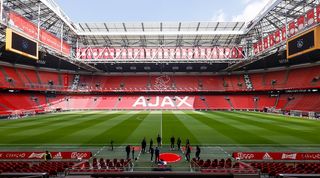
Originally called the Amsterdam Arena, Ajax renamed their home after their greatest ever player in 2018. It’s staged no fewer than nine European Championship games, plus the 1998 Champions League final.
With a capacity just shy of 56,000, the Johan Cruyff Arena is the largest stadium in the Netherlands.

22. Azadi Stadium
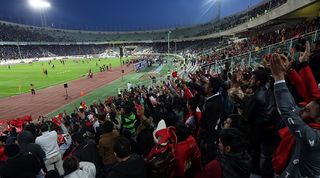
It might have an official capacity of 78,116 these days, but 128,000 people once crammed into the Azadi Stadium to watch a World Cup qualifier between Iran and Australia.
Club sides Esteghlal and Persepolis also call the Azadi home, and an incredible atmosphere is guaranteed for derby games.
21. Estadio da Luz

Built to be both a new home for Benfica and the centrepiece of Euro 2004, the Estadio da Luz is a stunning stadium in the outskirts of Lisbon.
Two Champions League finals have been played here since it opened, while the Portugal national team makes regular appearances at the 64,642-capacity arena.
20. Stade de France

This is the venue where France won their first World Cup in 1998, thanks in large part to Zinedine Zidane’s noggin.
It also hosted the finals of Euro 2016 and the 2020 Champions League, while les Bleus play their home games at this awesome stadium out in the Parisian suburbs.
19. De Kuip
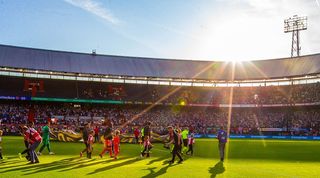
Built in 1938, De Kuip oozes character both outside and in. The architects largely based their design on Highbury, Arsenal ’s former home, with additional inspiration taken from the Yankee Stadium.
When Feyenoord are flying, De Kuip generates a remarkable racket. It also hosted the final of Euro 2000, when France beat Italy 2-1.
18. Cairo International Stadium
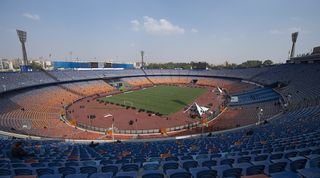
Don’t expect to hear yourself think when a big game’s on at the Cairo International Stadium, one of the best stadiums outside Europe and South America.
This cavernous, open-air ground holds 75,000 and there are seldom many tickets going when Egypt are in town, or when arch-rivals and co-tenants Zamalek and Al Ahly are locking horns.
17. Estadio de Mestalla

Valencia have been trying to move to a new ground for years , but football purists everywhere are delighted they remain at Mestalla.
With its orange seats and remarkably steep stands (acrophobia sufferers need not attend), this is a stadium like no other. Mestalla hosted three of Spain’s games at the 1982 World Cup.
16. Estadio Metropolitano

Atletico Madrid left their spiritual home, the Estadio Vicente Calderon, in 2017. There were fears that the Estadio Metropolitano would pale in comparison, but the designers did a magnificent job.
The Metropolitano produces tremendous noise too, not least when the floodlights are on for an evening kick-off. The 2019 Champions League final between Liverpool and Tottenham was played here.
15. Anfield

Nestled in between rows and rows of terraced housing, Anfield sits right at the heart of the Liverpool FC community. Originally the home of Everton, the red team from the city moved in in 1892.
Liverpool abandoned plans for a new stadium in the 2000s, as the club instead decided to stay at its spiritual home.
14. Stade Velodrome

Many modern arenas are criticised for a lack of atmosphere and identikit design. Neither charge can be levelled at the gorgeous Stade Velodrome.
Marseille have played here since 1937, but the ground took on its current look - including the extraordinary, elliptical roof - only after a massive renovation before Euro 2016.
13. Celtic Park

Celtic are not the force they once were on the European stage, but no Champions League or Europa League visitor relishes a trip here.
Dating back to 1892 but modernised several times since, Celtic Park - or Paradise, as the club’s fans call it - is the ideal blend of old and new.
12. Wembley Stadium
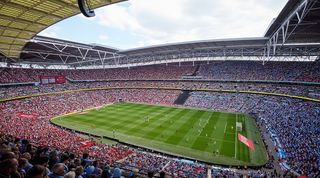
Wembley cops its fair share of flak, but the 90,000-capacity stadium in north London has a lot going for it. The name alone is recognisable in every corner of the globe.
The arch gives it a distinctive look, just as the twin towers did at the old ground on this site.
11. Allianz Arena

It may look like a giant spaceship from the outside, but the Allianz Arena is a terrific place to watch football.
Such a bold and innovative design would count for less if Bayern Munich ’s home ground didn’t also produce an electric atmosphere. Thankfully it does, especially on big European nights.

Architect Archibald Leitch had a hand in numerous football stadiums in Britain, but Ibrox was probably the Glaswegian’s finest work.
With its red-brick facade the main stand (a listed building, no less) is strikingly grand, while the atmosphere is ferocious - particularly for Old Firm games. Rangers have played here since 1899.
9. Tottenham Hotspur Stadium

The Tottenham Hotspur Stadium sits on the site of the old White Hart Lane, which means it’s still the hub of the local community.
The acoustics and all-round fan experience are excellent, while the towering South Stand, which seats 17,500 fans, is a sight to behold. The ground cost £1 billion but was worth every penny.
8. Estadio Azteca

The Estadio Azteca was the first ground to host two World Cup finals, in 1970 and 1986. Those who watched either tournament couldn’t help but be dazzled by the colour and exoticism of this splendid arena.
Home to Cruz Azul, Club America and the Mexico national team, the Azteca has a capacity of 87,523.
7. Estadio Monumental
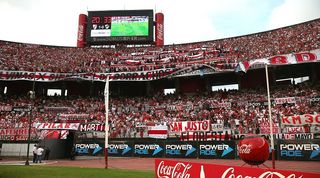
River Plate have played at the glorious Estadio Monumental since 1938. It was originally the shape of a horseshoe but all four stands are connected these days, to the benefit of the atmosphere.
Argentina won the 1978 World Cup at the Monumental, where the national team continues to play many of its matches.
6. Camp Nou
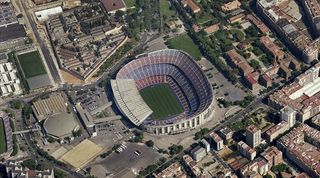
The largest stadium in Europe, no ground-hopping aficionado’s work is complete until they have visited the Camp Nou.
Barcelona have played here since 1957, while five games at the 1982 World Cup took place at this cathedral of football. Inspired by Feyenoord’s De Kuip, the Camp Nou deliberately has no open corners.
5. San Siro
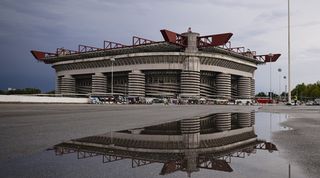
The San Siro sets the pulse racing as soon as you exit the nearby metro station. The imposing concrete towers and spiral staircases are unique, but nothing can prepare you for the noise and colour inside.
Both AC Milan and Inter have tried to move out over the years , but the San Siro is mercifully still standing.
4. La Bombonera
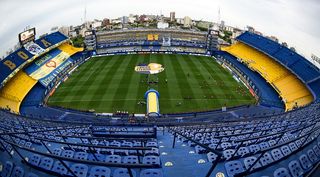
Its official name might be the Estadio Alberto José Armando, but everyone knows Boca Juniors ’ home as La Bombonera - the ‘chocolate box’, because of its distinctive D-shape.
There’s something alluring about the blue and yellow all around the ground, while the atmosphere is undoubtedly among the best on the planet.
3. Signal Iduna Park

Borussia Dortmund ’s Signal Iduna Park, or Westfalenstadion, houses one of the most fantastic sights (and sounds) in world football.
The Yellow Wall is the nickname for those fans who stand on the 24,454-capacity South Bank and help to create one of the best atmospheres you’ll find anywhere in sport.
2. Maracana
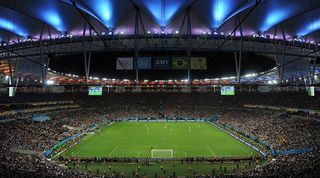
There’s no more evocative stadium in the world than the Maracana, even if the Estadio Jornalista Mario Filho in Rio de Janeiro isn’t actually called that.
Pele, Garrincha, Zico, Romario, Ronaldo and Ronaldinho have all strutted their stuff at a ground which has hosted two World Cup finals and countless other big games.
1. Estadio Santiago Bernabeu

The biggest club in the world needs a stadium befitting that status - and Real Madrid have certainly got it.
The Estadio Santiago Bernabeu packs in 83,168 people, whose noise can barely escape the towering stands and spectacular steel roof. It’s the only ground to have hosted the final of the World Cup, European Championship, Champions League and Copa Libertadores.
Thank you for reading 5 articles this month* Join now for unlimited access
Enjoy your first month for just £1 / $1 / €1
*Read 5 free articles per month without a subscription
Join now for unlimited access
Try first month for just £1 / $1 / €1

Greg Lea is a freelance football journalist who's filled in wherever FourFourTwo needs him since 2014. He became a Crystal Palace fan after watching a 1-0 loss to Port Vale in 1998, and once got on the scoresheet in a primary school game against Wilfried Zaha's Whitehorse Manor (an own goal in an 8-0 defeat).
Players known by their first name
Clubs with prolific youth academies
Erik ten Hag has given Gareth Southgate something extra to think about ahead of Euro 2024
Most Popular
- 2 Manchester United identify ideal midfield partner for Kobbie Mainoo - from relegation-threatened club: report
- 3 Tottenham edge ahead in transfer race for in-form Serie A forward: report
- 4 Manchester United have 'intensified' move for star who could become one of the fastest players in the Premier League: report
- 5 Arsenal 'talks ongoing' with superstar striker wanted by Manchester United: report
Road to CFB
The 14 Most Scenic College Football Stadiums
Some locations and backdrops of the nation’s college football stadiums make them destinations for sports travelers. The beauty of college football is that these venues often reside in smaller towns and in some of the most picturesque locations in the country. Below, we’ll look at the 13 most scenic college football stadiums.
Subscribe to Road to CFB for more!
Type your email…
14. McLane Stadium, Baylor

The entire Baylor University campus is picturesque, but the athletics side of campus sits right on the Brazos River. McLane Stadium, built in 2014, took full advantage of its positioning, opening the horseshoe directly facing the river. While Waco, Texas, is far from a destination city (save for Fixer Upper fans), Baylor’s campus and football stadium are worth adding to the college bucket list.
13. Acrisure Stadium, Pitt

For both college and professional football, Acrisure Stadium (formerly Heinz Field) boasts one of the best backdrops. The skyline of Pittsburgh sits at the fork of three rivers and in the heart of the Allegheny Mountains. Former facilities on this land included Tri River Stadium, which pays homage to this natural formation. For maximum views, visit the upper west deck (pictured above). On a clear fall night, the Steel City is one of the best places to be.
12. Lane Stadium, Virginia Tech

If you sit high enough in the east stands of Lane Stadium, you’re rewarded with a spectacular view of the Appalachian Mountains. This area is known as the Blue Ridge and during peak fall foliage, few stadiums in college football are as scenic. Add in the aesthetic of the Virginia Tech campus and the traditions surrounding the Hokies (namely Enter Sandman) and you’ll be hard pressed to find a better all around atmosphere.
11. Maverik Stadium, Utah State

Spoiler alert: Utah State isn’t the only Utah school on this list. Nestled right in between the Rocky Mountains and the Great Salt Lake, Maverik Stadium offers vastly different yet scenic views depending on which way you look. Also a nice bonus, the landscaping placed inside the stadium pulls you into the nature vibe (pictured above).
10. DKR Texas Memorial Stadium, Texas

Situated in the heart of Austin, DKR Texas Memorial Stadium gives you city views unparalleled in the FBS. The upper decks are truly towering and sitting high up in the north end zone gives you that spectacular view of the skyline. Hill Country sits just to the west and the flat plains of Central Texas surround the rest. You can see for over 30 miles from up this high.
9. Rice-Eccles Stadium, Utah

If you sit on the home side of Rice-Eccles Stadium, you might be doing more watching of the mountain backdrop than the game itself. Like its State counterpart, this stadium sits within eyeshot of the truly gorgeous Rocky Mountains. Perhaps it’s the color scheme of the Utes, or just coincidental placement, but the views work slightly better here.
8. Canvas Stadium, Colorado State

Along the I-25 corridor sits some of the most breathtaking views of the Rocky Mountains anywhere in the country. Fort Collins happens to sit on that corridor and the architects of Canvas Stadium – a relatively-new venue opened in 2017 – knew that. Sit up high in the east stands for the best view of not only the mountainous backdrop, but the home stands of this beautiful newer stadium.
7. Michie Stadium, Army

Not many places in the world match the color show put on during fall foliage in New York. Michie Stadium sits on one of the country’s most beautiful and prestigious campuses, The United States Military Academy, which bumps right up on the Hudson River. While Michie Stadium itself doesn’t sit directly on the Hudson River, they get their own body of water in the Lusk Reservoir. Head here in mid-October to be rewarded with some of the most spectacular views in all of college football.
6. Rose Bowl Stadium

It’s not the most iconic scene in college football for nothing. The Granddaddy of Them All etched its place in sports as a staple game, venue, and sight to behold. The San Gabriel Mountains set the stage for stunning sunsets and the most photographed stadium in college football. Rose Bowl Stadium transcends just a sporting event and becomes a pilgrimage for sports fanatics to cast their eyes on the iconography.
5. California Memorial Stadium

What more could you ask for from a stadium view? From California Memorial Stadium, you can see the Santa Cruz Mountains, the sprawling hills and campus of Berkeley, the San Francisco skyline, the Golden Gate Bridge, and the San Francisco Bay. The upper concourse here offers 360-degree spectacular views of everything the Bay Area has to offer.
4. Husky Stadium, Washington

The most defining feature of Husky Stadium – and perhaps Washington football – isn’t the purple nor their husky mascot. It’s the backdrop of their football stadium, which sits on Union Bay. This school is famous for “sailgating” where hundreds of boats take their tailgates into Union Bay (pictured above). UW’s campus is already one of the most beautiful in the world, but the strategic placing of this football stadium over 100 years ago holds to be its defining feature today.
3. Kidd Brewer Stadium, Appalachian State

Far removed from anywhere and anything sits Boone, North Carolina. It’s buried in the gorgeous Appalachian Mountains, particularly in the famed Blue Ridge region. Everywhere you look is picturesque, and that’s cranked up to 11 during peak fall foliage. In fact, you might not find a more beautiful region to be in when the fall leaves turn. Even the drive into town is scenic.
2. Folsom Field, Colorado

The Flatirons (pictured above) are some of the most dramatic mountain sheers in the United States. Luckily for the University of Colorado, the campus and football stadium were built squarely in their shadow. Sit in the east stands for the most dramatic views of the most-visited spot in the Rockies and enjoy the Colorado air. No matter the season, Folsom Field is one of the most scenic stadiums in college football.
1. LaVell Edwards, BYU

How do you one-up sitting in the shadow of the Rockies? How about sitting a baseball’s throw away from them? BYU’s campus and athletic facilities are almost as close as you can get to a mountain without having to build the stands on their side. Sitting in the home stands offers the most breathtaking view of a venue in all of American sports. As BYU flocks to the Big 12, new groups of fans will be afforded access to the most scenic college football stadium every year.
Do you agree with the list? Think I left one off? Let me know on Twitter !
Share this:
- Click to share on Twitter (Opens in new window)
- Click to share on Facebook (Opens in new window)
One thought on “ The 14 Most Scenic College Football Stadiums ”
- Pingback: College Football 'No Bad Seat' Large Stadiums | Road to CFB
Leave a Reply Cancel reply

Previous article
UPDATED Ranking College Football Stadiums: 108 Down

Next article
College Football ‘No Bad Seat’ Large Stadiums
Discover more from road to cfb.
Subscribe now to keep reading and get access to the full archive.
Continue reading
The most visited Stadiums
These are the football stadiums that most groundhoppers have visited.

Stamford Bridge
Capacity: 41,798
Home to Chelsea
24 Groundhop visits

Capacity: 54,074
Home to Liverpool
23 Groundhop visits

Emirates Stadium
Capacity: 60,272
Home to Arsenal
18 Groundhop visits

Johan Cruijff Arena
Capacity: 54,990
Home to Ajax
16 Groundhop visits

Old Trafford
Capacity: 75,635
Home to Manchester United

Stadio Giuseppe Meazza
Capacity: 80,018
Home to Inter , Milan

Wembley Stadium
Capacity: 90,000
15 Groundhop visits

Capacity: 98,787
Home to Barcelona
13 Groundhop visits

Loftus Road Stadium
Capacity: 18,000
Home to Queens Park Rangers

Capacity: 20,146
Home to Millwall

Estadio Santiago Bernabéu
Capacity: 81,044
Home to Real Madrid
12 Groundhop visits

Signal-Iduna-Park
Capacity: 81,365
Home to Borussia Dortmund

Stadion Feijenoord
Capacity: 51,177
Home to Feyenoord
11 Groundhop visits

Stadion im BORUSSIA-PARK
Capacity: 54,057
Home to Borussia M'gladbach

Craven Cottage
Capacity: 25,700
Home to Fulham
10 Groundhop visits

Etihad Stadium
Capacity: 55,097
Home to Manchester City

Friends Arena
Capacity: 54,000
Home to AIK

Capacity: 40,000

Philips Stadion
Capacity: 35,000
Home to PSV

Kenilworth Road Stadium
Capacity: 10,226
Home to Luton Town
9 Groundhop visits
Groundhop is a growing community of football enthusiasts
The ultimate resource for football fans looking to explore new stadiums and keep track of visited stadiums.
- Bayern Munich
- Borussia Dortmund
- Leeds United
- Manchester City
- Manchester United
- Newcastle United
- Real Madrid
- Tottenham Hotspur
- Premier League
- Champions League
The 13 grounds you must visit on a European football road trip
Being in Europe means being on the doorstep of a bottomless pit of opportunity to catch some truly brilliant football matches, across cities packed with culture.
While there are some truly mesmerising football stadiums and genuine bucket list pipedreams of stadiums we’d love to visit worldwide, the advantage that a European road trip has is, well, exactly that – the close proximity allows for much more efficient groundhopping if you’re putting together a mini-road trip of sorts.
Taking into account factors such as beautiful stadiums, atmospheres and fan culture, good transport links and the things to do in each city, we’ve pulled together a list of 13 stadiums you ought to try and watch a game at on a European road trip.
In a bid to try and create as much variation as possible, we’ve done our best to limit this to one stadium per country, with a few exceptions.
Santiago Bernabeu – Madrid
Starting with the obvious ones, there is simply no excuse not to visit the Bernabeu if you find yourself in Spain – even more so now it’s been renovated.
Home to perhaps football’s biggest club, seeing a Real Madrid game is a genuine bucket list experience. Superstars galore in an institution so rich in history that it hurts.
It’s also just as easy to catch Real Madrid Femenino at the Alfredo Di Stefano while there, and Madrid is full of things to do as a tourist.
A no-brainer.
Camp Nou – Barcelona
Europe has an endless supply of brilliant football to the point where you could make a few weeks of just watching several games within one country, which is why this list is difficult to narrow down.
If you’re in Spain, though, and have the chance to visit both Barcelona and Madrid, visiting both stadiums simply has to be done. The Camp Nou is undergoing heavy renovations right now, but when it’s done, it’ll be an unmissable experience similar to that of the Bernabeu.
Away from the football, Barcelona is also a stunning city.
San Siro – Milan
Both Milan clubs have been keen to move out of San Siro – also known as the Giuseppe Meazza – for several years now, thus it’s hard to know exactly how long we’ve got left to visit one of football’s holy grails before it’s potentially knocked down.

READ: I watched Inter Milan at the San Siro & discovered the meaning of life
Stade Velodrome – Marseille
An impressive 67,000-seater stadium in the South of France, the Velodrome looks like something from the future and is home to one of the most ferocious atmospheres in European football.
Marseille are a club steeped in history with nine Ligue 1 titles, 10 Coupe de France trophies and one Champions League, and their fans are notoriously passionate – sometimes too passionate.
Opened in 1937, the Velodrome has been a host of two World Cups and is also regularly used by France’s national rugby team. Away from the sport, there’s plenty to do in Marseille, a picturesque port city with lots of lovely architecture, good food and great weather.
Stadion An der Alten Försterei – Berlin
Germany is yet another nation where you’re essentially spoilt for choice when it comes to brilliant cities for football. Berlin, however, should be a priority.
The capital is swimming with fascinating history, plenty to do and two Bundesliga teams to enjoy watching. Watching Hertha is an option, but we’d prefer to go southeast and watch Union Berlin at the Stadion An der Alten Försterei.
A tightly-packed stadium surrounded by greenery, it holds just over 22,000 fans and has those all-important standing terraces which improve an atmosphere tenfold. It also has an exceptionally unique look and is easy to get to.
Affordable and one for the hipsters among us.
Signal Iduna Park – Dortmund
If you want a more well-known German football experience and are willing to spend a little more money on a ticket – merely due to such high demand – then a trip to Dortmund for a game is a no-brainer.
Home to the famous Yellow Wall, the Signal Iduna Park – also known as Westfalenstadion – champions one of the most impressive terrace-standing sections in the game behind the goal and is an absolute marvel.
Affordable beers, great food and the best part is that you can take those affordable beers to your seat.
Tickets might be a little harder to come by – especially if you want to be in the atmosphere sections – but if you can snag some, then do.

Some view, that.
Johan Cruyff ArenA – Amsterdam
A true footballing institution within a city where it’s impossible to be bored, a stop in Amsterdam coupled with a trip to the Johan Cruyff ArenA is the dream.
They might not be the footballing powerhouse that they once were, but to hear Ajax fans on home turf, those iconic shirts and the young guns taking their chance in such an impressive stadium is a must.
And like we’ve just alluded to, there’s much more to Amsterdam than just the football.
Fortuna Arena – Prague
While it doesn’t stand out among the big flashy names, the Czech Republic – and Prague in particular – is a hidden gem for a European football fix on a budget, and you get the full experience.
One of the game’s most underrated derbies is contested in the capital between Slavia Prague and Sparta Prague. It doesn’t stop there, though, with as many as six teams based in Prague.
We’ve highlighted Slavia and the Fortuna Arena, a 21,000-seater stadium east of the centre which has famous ultras – and a McDonald’s drive-thru built into the side of the ground. Really.
Don’t waste your time in the McDonald’s, though, get lost in the city centre and the various bars and restaurants. You won’t struggle.

The McDonald’s drive-thru in full view…
Old Trafford – Manchester
There is a very real possibility that Old Trafford as we know it will no longer exist in the not-too-distant future. That is an absurd thought and all the more reason for a trip to Manchester to watch Manchester United.
The Red Devils are a far cry from the force that they once were, but you’ll struggle to find someone who doesn’t concur that Old Trafford – when in full voice – is one of the greatest grounds ever to be stood in. Historic.
A weekend in Manchester around that isn’t bad, either. Bring a waterproof and get lost in bars, or take a train to any of the surrounding cities or more rural areas.
Anfield – Liverpool
From a stadium pending an overhaul to one which is coming out of a fantastic renovation phase, Anfield is merely down the motorway from Manchester and another brilliant bit of footballing history that’s a must for anyone wanting the Premier League experience.
Much like Old Trafford, snagging a ticket for a game at Anfield will be difficult – and/or cost you a pretty penny – but if you can get one, don’t hesitate.
Only a stone’s throw away from Manchester on the train, Liverpool is a brilliant city for a mini-break. If you like Manchester’s options, you’ll love Liverpool’s.
Henryk Reyman Stadium – Krakow
A brilliant holiday destination and always affordable, Krakow is just one of several brilliant cities to visit in Poland.
The national team play in Warsaw, another excellent city, but for a combination of football and good times then a trip to the Stadion Miejski im. Henryka Reymana – home of Wisla Krakow – is a brilliant shout for the football fix.
A club steeped in history, the stadium looks brilliant. It’s tightly-packed and the stands sit right on top of the pitch. Krakow is also home to excellent food, cheap beer and plenty of culture.
Architecture, castles, the old town, an amazing square and museums – just to name a few recommendations.
Parken – Copenhagen
You might’ve noticed Copenhagen making a splash in the Champions League in recent times, one particularly big splash being their 4-3 victory at home to Manchester United in November 2023.
They did so at the ever-electric Parken, which has become home to some of the most impressive fan displays in recent times.
Compact, noisy and passionate, it’s a serious insight into just how good European football can be away from the big names. Just be sure to bring plenty of spends and your nicest clothes – the capital of Denmark is one stylish city.

A proper showing.
Besiktas Stadium – Istanbul
We’re finishing off this list in Turkey’s capital, where again you’ve got the pick of the bunch between several giants.
While Galatasaray or Fenerbahce might be the most obvious choice, Besiktas are a club who boast equal star power in the players they attract and their new stadium opened in 2016, making for a brilliant experience right on the Port of Istanbul, for even better views.
A bustling city with amazing mosques and museums as well as bars, food and tourist activities, it’s a trip that has it all – and one you can do at a fair price.
READ NEXT: 11 of the most iconic stadiums that we wished still existed: Highbury, Upton Park…
TRY A QUIZ: Can you name the last 20 players to break the world transfer record?
15 Best Cities Around The World Known For their Football Stadiums!

If you're a fan of the beautiful game of football, then chances are everything automatically revolves around the game for you. The joy that a football fan receives from watching his favourite team play in its home stadium is unprecedented, and hence it's completely logical to travel far and wide for this very objective. Our country is full of passionate football fans who are avid travellers as well, and hence it's only natural that their destination bucket list is full of football stadiums and places where they can extract the maximum footballing satisfaction.
So without further ado, here are:
15 cities in the world a football fan must visit to complete his ultimate pilgrimage of football stadiums :
Credits: Paul
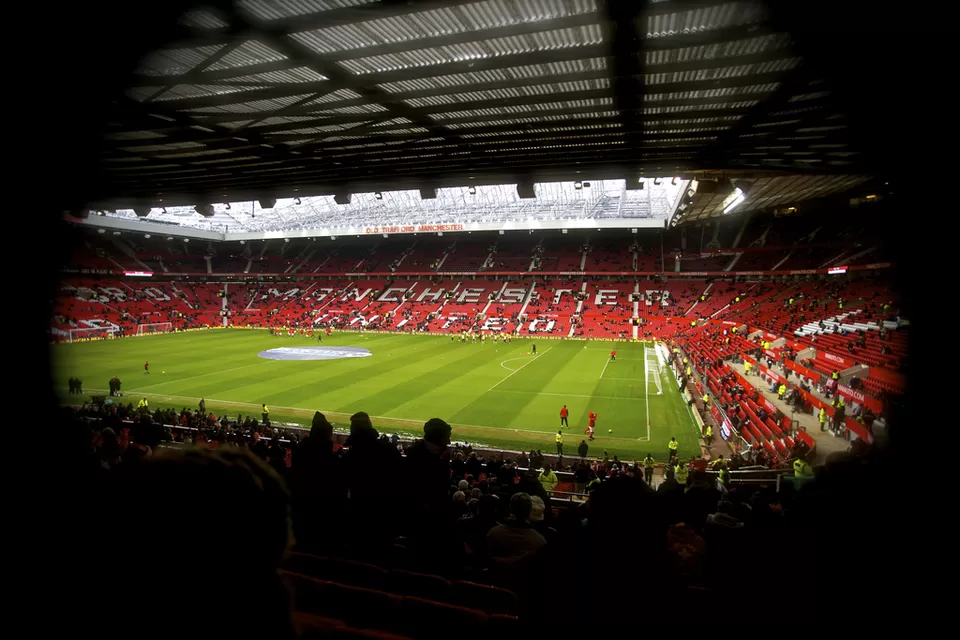
Home of the world's most "supported" football club, Manchester United, the city of Manchester is also home to another great club, Manchester City. And hence, a city with two dominant football forces is a must-visit in any fan's itinerary.
Famous footballers to have played here: George Best, Eric Cantona, Sir Bobby Charlton, David Beckham, Cristiano Ronaldo, Sergio Aguero.
Things to do apart from football: Visit the Manchester Art Gallery to see great contemporary works of art. Experience the fantastic nightlife.
Average expenditure per day per head: Rs. 4,500
Book the best hotels.
Read more about the city.
Credits: Jackie.Ick
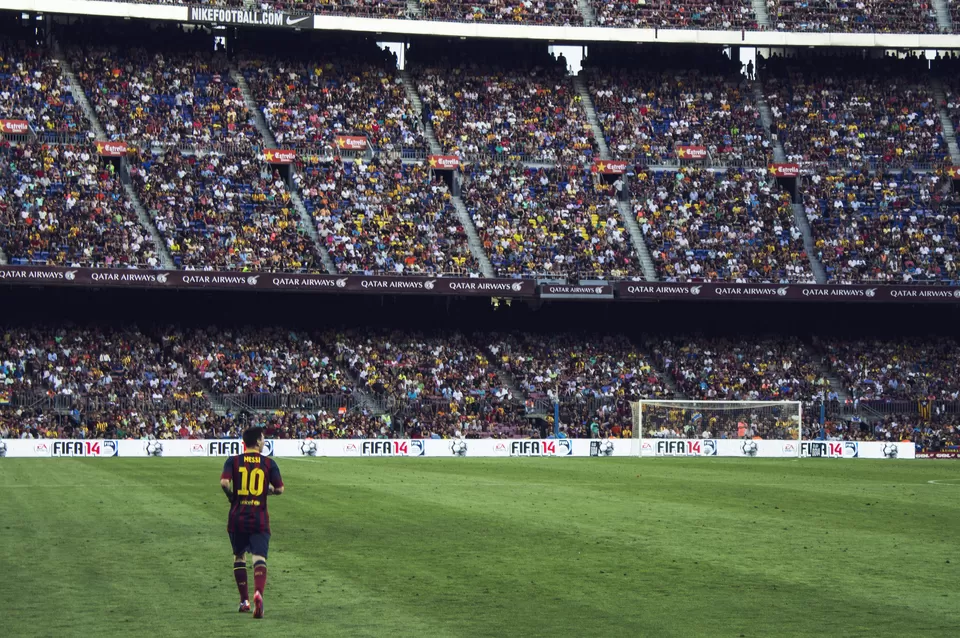
Home to arguably the best football club in the world - FC Barcelona - in the recent past, and also Lionel Messi. Their home ground - Camp Nou - is also one of the largest football stadiums in the world.
Famous footballers to have played here: Lionel Messi, Luiz Ronaldo, Johann Cryuff, Rivaldo, Andres Iniesta, Diego Maradona.
Things to do apart from football: Walk around Park Guell to marvel at Guell's greatest pieces of art. Visit the Gothic Quarter to witness sublime cathedrals.
Average expenditure per day per head: Rs. 3,500
Credits: Irene Grassi
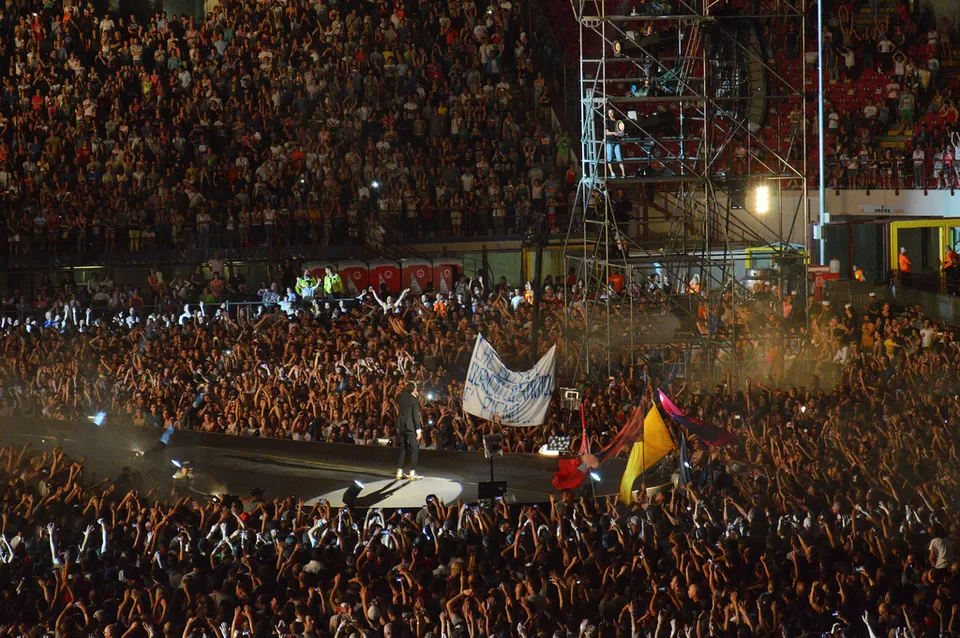
Two of the most successful football clubs of Italy – Internazionale FC and AC Milan – still play their home matches in the very same stadium. If you're looking for return on investment on your travelling, this is the perfect place.
Famous footballers to have played here: Paolo Maldini, Javier Zanetti, Luiz Ronaldo, Zlatan Ibrahimovic, Hernan Crespo, Kaka.
Things to do apart from football: Visit the Sforza Castle to check out medieval art treasures. Shop for the best fashion at Galleria Vittorio.
Credits: Sonke Biehl
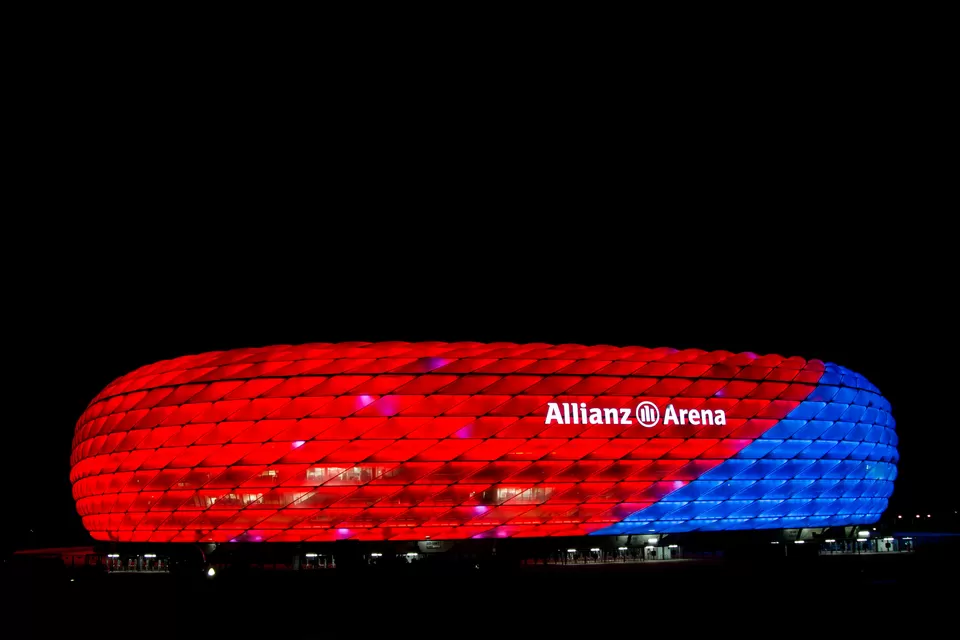
Home to one of the most iconic football clubs in the world – Bayern Munich. Their home stadium, Allianz Arena, complements their stature perfectly. What obviously helps is that Munich is also the venue of Oktoberfest.
Famous footballers to have played here: Oliver Kahn, Manuel Neuer, Phillip Lahm, Franz Beckenbauer, Gerd Muller.
Things to do apart from football: Visit the regal Nymphenburg Palace. Go beer-tasting at Englischer Garten.
Average expenditure per day per head: Rs. 4,000
Credits: Azotesdivinos
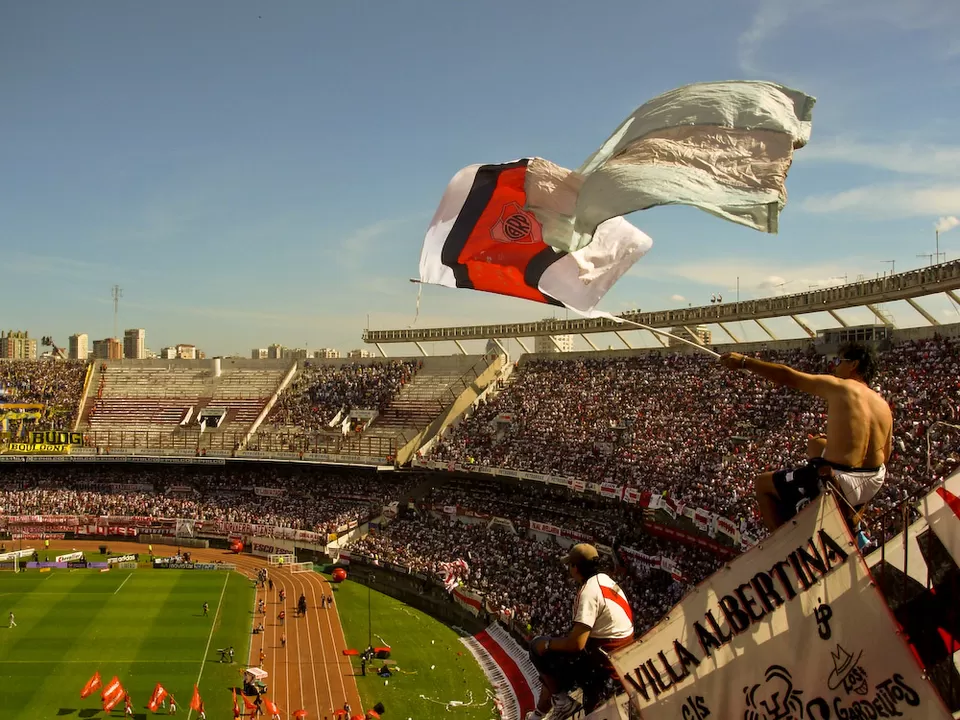
If you don't pompously show your support towards the local football clubs in Lima, you won't have a very good trip. Everyone is extremely passionate about football and would expect you to be too.
Famous footballers to have played here: Claudio Pizarro, Hugo Sotil, Teofillo Cubillas.
Things to do apart from football: Visit the Plaza Mayor to learn more about Peru. Satiate your soul at the Monastery of San Francisco.
Average expenditure per day per head: Rs. 3,000
Credits: Cpakmoi
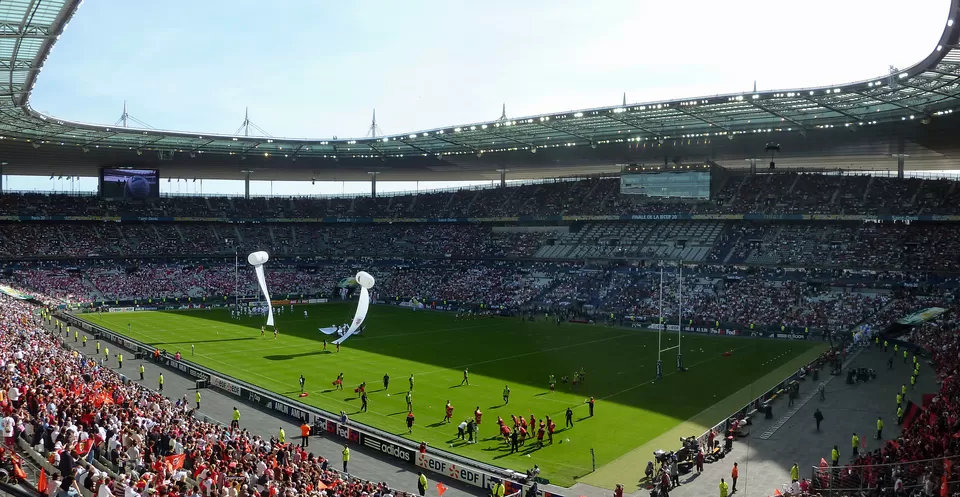
If you thought the French capital is only about the Eiffel Tower and the feeling called love, think again. Paris Saint Germain is a massive force to reckon with in the footballing world, and hence Stade de Paris is a must visit venue.
Famous footballers to have played here: Zlatan Ibrahimovic, Thiago Silva, Edinson Cavani, Angel Di Maria, Ronaldinho, George Weah.
Things to do apart from football: Visit the Eiffel Tower. Experience the best works of art at The Louvre museum.
Average expenditure per day per head: Rs. 5,000
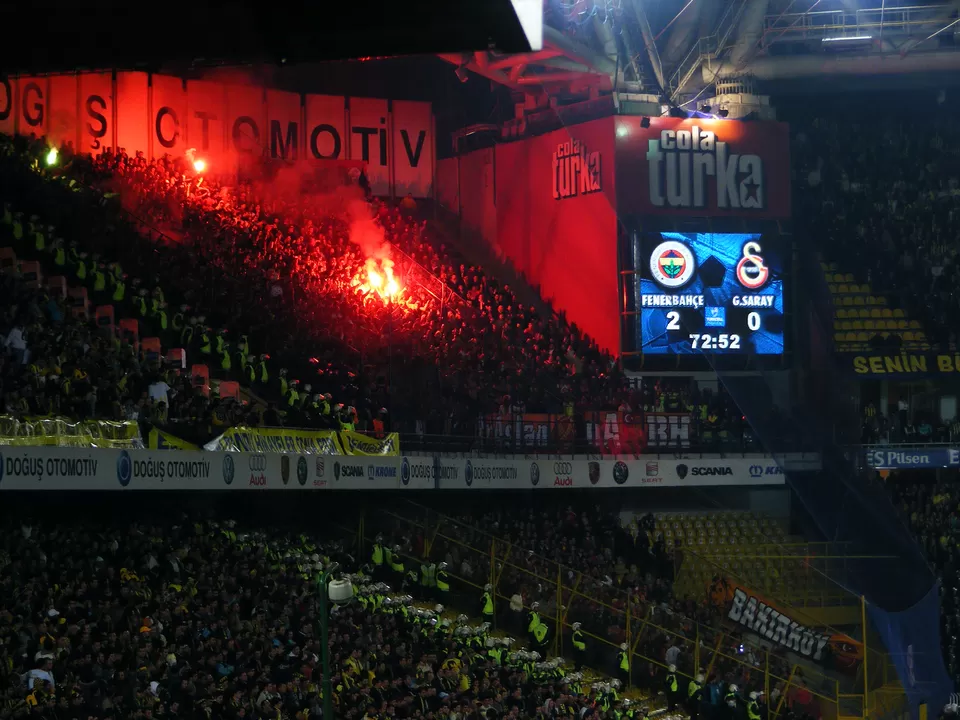
What you experience inside Galatasaray's home stadium, Turk Telekom Arena, can't be done anywhere else. The home fans make the atmosphere so intimidating that it has to be witnessed to be believed.
Famous footballers to have played here: Wesley Sneijder, Lukas Podoloski, Hakan Sukur, Milan Baros, Arda Turan, Didier Drogba.
Things to do apart from football: Visit the iconic blue mosque of Sultan Ahmed. Shop till eternity dawns? at the colourful Grand Bazaar.
Average expenditure per day per head: Rs. 2,500
Credits: MJWho

Napoli football club's home stadium, Stadio Sao Paolo, has also earned a name for being ultra-notorious when it comes to supporting its team. Several minor casualties are reported after every match.
Famous footballers to have played here: Diego Maradona, Gonzalo Higuain, Edinson Cavani, Gianfranco Zola, Fabio Cannavaro.
Things to do apart from football: Witness an actual active volcano – Mt. Vesuvius. Attend an opera performance at San Carlo Theatre.
Buenos Aires
Credits: Alajandro Arango

One of the most passionate football cities in the world, Buenos Aires has borne and nurtured many legends in football; once you're here, it'll be easy to see why.
Famous footballers to have played here: Diego Maradona, Carlos Tevez, Juan Roman Riquelme, Walter Samuel, Gabriel Batistuta.
Things to do apart from football: Visit the colourful neighbourhood of La Boca to see where tango started. Visit Casa Rosada, a pink palace that houses the presidential office.
Credits: Lackystrike
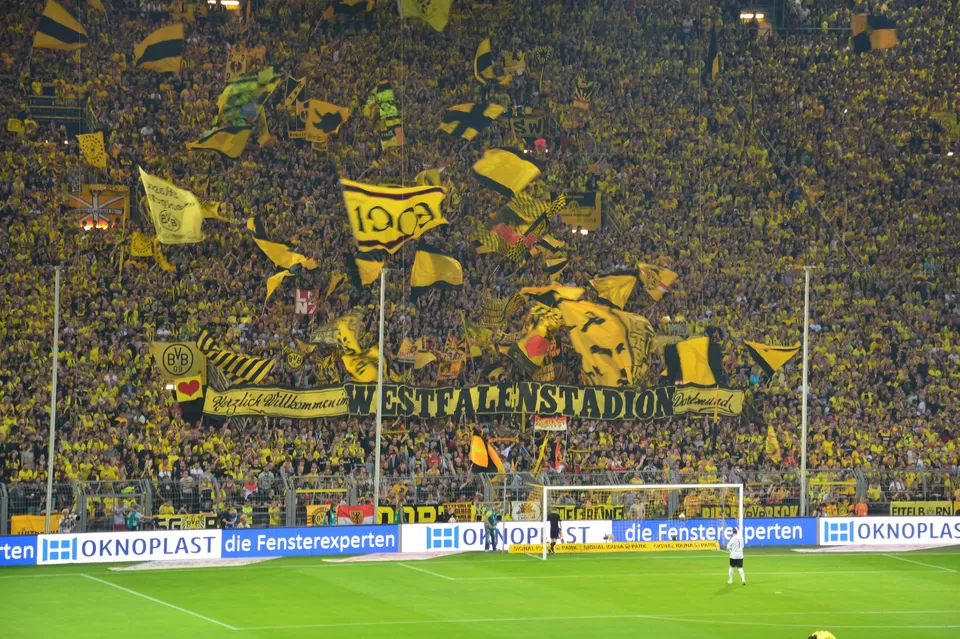
If Borussia Dortmund is the epitome of a loyal football club, then its home ground, Westfalenstadion, is majorly responsible for the same. The fans make the atmosphere so electric that they're collectively called the "12th man" of the team.
Famous footballers to have played here: Marco Reus, Robert Lewandowski, Mario Gotze, Pierre Emerick-Aubameyang, Mats Hummels.
Things to do apart from football: Visit the St. Reinold's Church, the oldest in the city. Marvel at contemporary art at Museum Ostwall.
Mexico City
Credits: Paul Brady
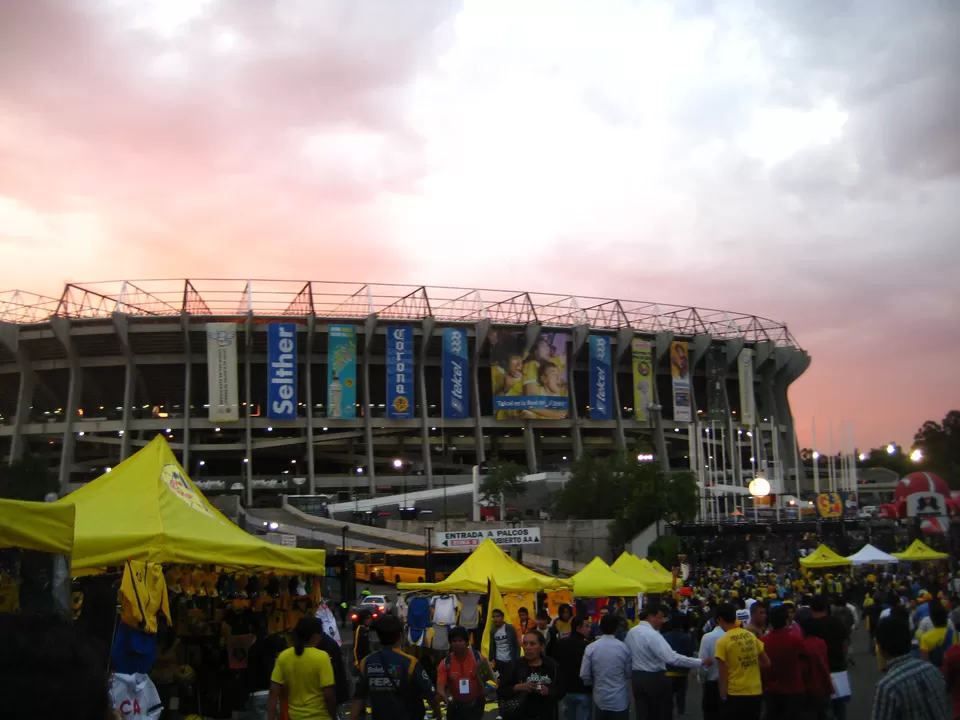
Mexico City's Estadio Azteca is one of the largest football stadiums in the world and the noise during a local match is deafening to say the least. It's a must-visit for any football fan.
Famous footballers to have played here: Silvio Romero, Bruno Valdez, Hugo Sanchez, Ivan Zamorano.
Things to do apart from football: Learn more about the Mayan origins at the National Museum of Anthropology. Visit the Zocalo square, it's the city's center.
Credits: Mai-bee

La Paz has the highest football stadium in the world, the Hernando Siles Stadium, and also the largest sports complex in the country. With every one of the 42,000 seats always packed hours before a match, the ambience is very charged.
Famous footballers to have played here: Luis Cristaldo, Jaime Moreno, Raul Castro.
Things to do apart from football: Visit the ancient temples and pyramids at Tiwanaku. Illimani is a haven for mountain climbers.
Average expenditure per day per head: Rs. 2,000
Credits: Wikipedia
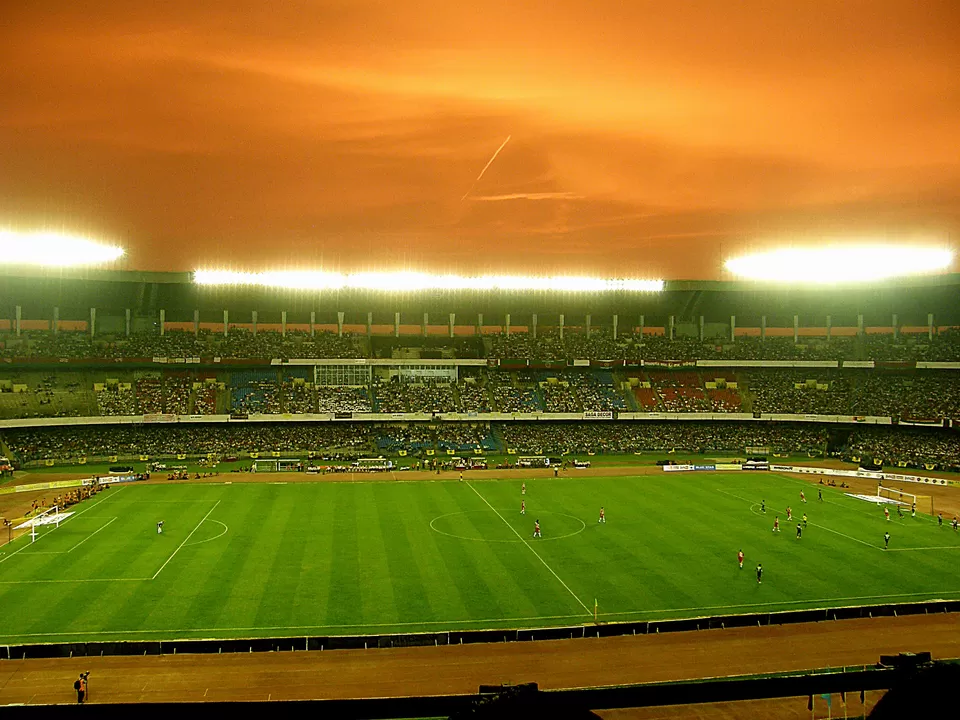
The one and only entry from India, and rightly so. Beneath its sophisticated facade lies a football-crazy city. And sparks fly when there are two major forces, East Bengal and Mohun Bagan, based in the very same city. Kolkata is also home to the largest football stadium in India, the Salt Lake Stadium.
Famous footballers to have played here: Bhaichung Bhutia, Sunil Chhetri, Subrata Paul, Gurpreet Singh Sandhu, Jose Ramirez Barreto.
Things to do apart from football: Go to the heart of the city, Park Street, and walk into any restaurant for a great culinary experience. Visit the city during Durga Puja to truly experience the beautiful mayhem.
Average expenditure per day per head: Rs. 1,000
Rio de Janeiro
Credits: Pixabay

Would've been a shame if the most famous footballing nation didn't make it to this list, but Rio de Janeiro's nooks and corners are brimming with future superstars playing with their make-do footballs all day long. It is funny how crazy the city is for the sport.
Famous footballers to have played here: Zico, Ronaldo, Romario, Carlos Alberto Perreira, Jairzinho.
Things to do apart from football: Surrender yourself to god at the statue of Christ the Redeemer. Experience the world-renowned Rio Carnival.
Credits: Jan Solo

The mecca of football, home to the Los Galacticos - Real Madrid, the richest football club in the world. And of course, Cristiano Ronaldo also plays there.
Famous footballers to have played here: Cristiano Ronaldo, Zinedine Zidane, Luis Figo, Roberto Carlos, Luiz Ronaldo, Gareth Bale.
Things to do apart from football: Visit the Plaza Mayor square to drink in the vibrance of the city. Art connoisseurs can satiate themselves at Museo Nacional Del Prado.
Well, just get your guy gang together and pack your bags for an epic footballing journey across the world of football stadiums. If you've already been to any of these cities, do share your story with us!
Frequent Searches Leading To This Page:-
Turkey Holiday Package, Tour Packages Turkey , Family Tour Packages For Turkey, football stadiums, biggest football stadiums in the world
- Things To Do
- Entertainment
- Food Travel
- Travel Tips
- Travel News
The Best Football Stadiums To Visit In The World – INSIDER Guide
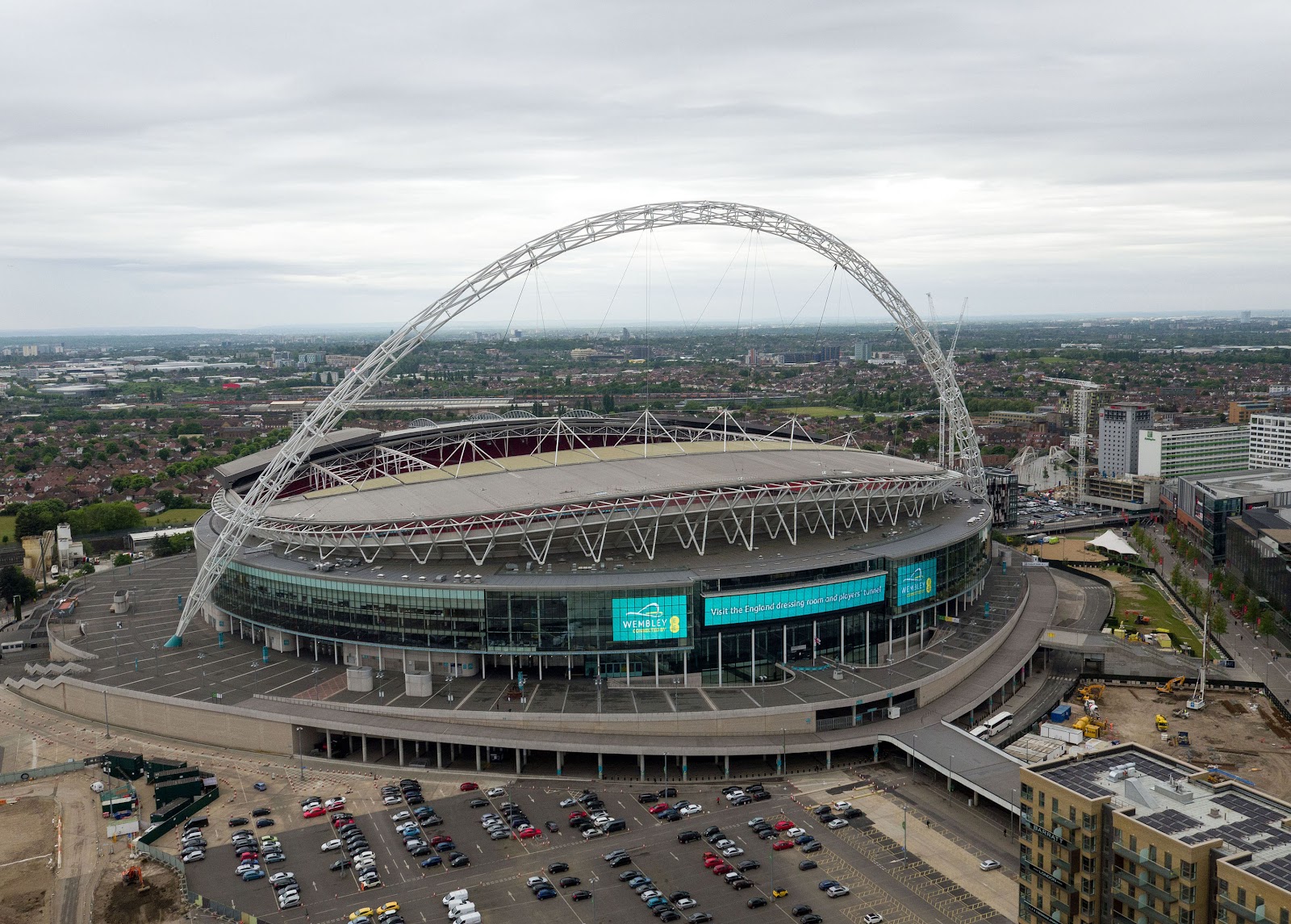
Introduction
Football, also known as soccer in some parts of the world, is not just a sport but a global phenomenon that unites people from different cultures and backgrounds. The passion and love for the game can be found in every corner of the world, and one of the best ways to experience this is by visiting the iconic football stadiums that have become legendary in the sport’s history. From the historic Wembley Stadium in London to the majestic Maracanã Stadium in Rio de Janeiro, these stadiums offer an unforgettable experience for football enthusiasts.
Stepping foot into these hallowed stadiums, you can feel the energy and excitement vibrating through the stands. The cheers of the crowd, the chants, and the collective anticipation as the players take the field create an atmosphere that is truly electrifying. Each stadium has its own unique history, architectural marvels, and cultural significance that make them a must-visit for any football fan.
In this guide, we will take you on a journey to explore some of the best football stadiums in the world. Whether you are a die-hard fan or simply appreciate the beauty of the game, these stadiums offer an immersive experience that goes beyond just watching a match. From the largest stadiums to the most iconic, we will delve into the history, architecture, and atmosphere of each stadium, giving you a glimpse into what makes them so special.
So, get ready to witness the breathtaking beauty of Wembley Stadium in London, the passionate atmosphere of Camp Nou in Barcelona, and the rich football heritage of Maracanã Stadium in Rio de Janeiro. Join us as we embark on this journey to explore the best football stadiums in the world, and get ready to be inspired by the magic of the beautiful game.
Wembley Stadium, London, England
Wembley Stadium, located in London, England, is undeniably one of the most iconic football stadiums in the world. With a seating capacity of 90,000, it is the largest stadium in the United Kingdom and the second-largest stadium in Europe. The stadium holds a significant place in football history and has been the venue for numerous historic matches, including the UEFA Champions League final and the FIFA World Cup final.
The original Wembley Stadium was built in 1923 and witnessed countless legendary moments, such as England’s win in the 1966 World Cup final. However, it was demolished in 2003 to make way for a modern, state-of-the-art stadium. The new Wembley Stadium, inaugurated in 2007, retained the iconic twin towers and the famous Wembley Arch, which stands tall and proudly over the stadium.
What sets Wembley Stadium apart is not only its size and grandeur but also its unique design. The bowl-shaped seating arrangement ensures excellent sightlines from every seat, allowing fans to have an unobstructed view of the pitch. The stadium is embellished with cutting-edge technology, including the largest LED screens in Europe and a retractable roof, ensuring a memorable experience regardless of the weather.
Wembley Stadium is not just a venue for football matches. It is a multi-purpose stadium that hosts various sporting events, including rugby matches, NFL games, and music concerts by some of the world’s biggest artists. The stadium has witnessed iconic performances by legendary musicians, such as Queen, Adele, and Ed Sheeran. The combination of world-class sports and entertainment makes Wembley Stadium a must-visit destination for anyone visiting London.
Visiting Wembley Stadium is not just about watching a match or a concert; it’s about immersing yourself in the rich history and heritage of the game. The Wembley Stadium Tour allows visitors to explore behind the scenes, walk through the player’s tunnel, and even stand on the famous pitch where football legends have graced. The tour gives fans a chance to experience the spirit and atmosphere that fills the stadium on match days.
Whether you’re a football fanatic or simply appreciate the grandeur of world-class stadiums, a visit to Wembley Stadium is an unforgettable experience. It encapsulates the essence of the beautiful game, combining history, emotion, and sheer excitement, making it a top choice for any football lover.
Camp Nou, Barcelona, Spain
Nestled in the vibrant city of Barcelona, Spain, Camp Nou stands as a magnificent temple dedicated to the beautiful game of football. Home to FC Barcelona, one of the most successful football clubs in the world, Camp Nou is not just a stadium but a symbol of Catalan culture and identity. With a staggering seating capacity of over 99,000, it is the largest stadium in Europe.
Camp Nou, meaning “new field” in Catalan, opened its doors in 1957 and has witnessed countless historic moments in football history. The stadium’s design is a masterpiece of architecture, boasting an impressive facade and a canopy roof that covers all the stands, protecting the passionate fans from the elements while creating an incredible atmosphere.
Stepping into Camp Nou, you are immediately struck by the sheer size and grandeur of the stadium. The stands seem to stretch endlessly, enveloping the pitch with an aura of excitement and anticipation. The Camp Nou experience goes beyond the match itself – it is an immersion into the rich history and tradition of FC Barcelona.
One of the highlights of a visit to Camp Nou is the FC Barcelona Museum, located within the stadium complex. The museum showcases the club’s illustrious history, featuring trophies, memorabilia, and interactive exhibits that allow visitors to delve into the club’s legacy. You can see the impressive collection of Ballon d’Or awards won by Barcelona players, including Lionel Messi, Xavi Hernandez, and Johan Cruyff.
As you explore the stadium, you can also take a walk through the player’s tunnel, imagining the anticipation and nerves that the players feel as they step onto the sacred pitch. The Camp Nou Tour further provides the opportunity to visit the press room, the dressing rooms, and even sit in the dugout, giving fans an intimate glimpse into the inner workings of the club.
What truly sets Camp Nou apart is the atmosphere generated by the passionate Barcelona supporters, known as culés. The chants, the flags, and the energy in the stadium are truly awe-inspiring. Attending a match at Camp Nou is an unforgettable experience, with fans creating a wall of sound that reverberates throughout the stadium, bringing the game to life.
Whether you are a Barcelona fan or simply a lover of the beautiful game, a visit to Camp Nou is a must. It is not only a chance to witness world-class football but also to immerse yourself in the history and culture of this iconic club. Camp Nou is a testament to the eternal bond between a city, a club, and its passionate supporters.
Maracanã Stadium, Rio de Janeiro, Brazil
When it comes to iconic football stadiums, Maracanã Stadium in Rio de Janeiro, Brazil, holds a special place in the hearts of football fans around the world. Known as “The Temple of Football,” Maracanã has earned its reputation as one of the most legendary and historic stadiums in the sport’s history.
Built in 1950 for the FIFA World Cup, Maracanã Stadium has a rich heritage that spans over decades. With an impressive seating capacity of over 78,000 spectators, the stadium has witnessed some of the most memorable moments in football history, including Brazil’s devastating loss in the 1950 World Cup final and their triumph in the 2014 World Cup final.
What makes Maracanã Stadium truly remarkable is not just its grandeur but its association with the vibrant football culture of Brazil. From the samba rhythms echoing through the stands to the passionate chants of the fans, every match at Maracanã is a celebration of the beautiful game.
The magnificent architecture of Maracanã is a sight to behold. With its towering circular design and a rooftop that seems to touch the sky, the stadium stands as a symbol of Brazil’s passion for football. The open-air design allows spectators to soak in the energy and atmosphere of the game while offering breathtaking views of the surrounding city.
Maracanã Stadium is not only a venue for football matches but also for concerts and other major events. Over the years, it has hosted performances by renowned artists such as Madonna, The Rolling Stones, and Frank Sinatra, further solidifying its status as an iconic cultural landmark.
A visit to Maracanã is an immersive experience that goes beyond attending a match. The stadium offers guided tours, allowing visitors to explore the locker rooms, walk through the tunnel, and even step onto the hallowed pitch. Standing where football legends have played fills you with a sense of awe and reverence for the history that has unfolded within those walls.
For football enthusiasts, there is nothing quite like witnessing a match at Maracanã Stadium. The electric atmosphere, the passionate fans, and the unrivaled energy make for an unforgettable experience. Whether you’re cheering for the local teams Flamengo or Fluminense or attending an international fixture, a visit to Maracanã will leave you with memories to last a lifetime.
Maracanã Stadium stands as a testament to the power of football in Brazilian culture. It represents the connection between the sport and the people, showcasing the immense joy and pride that football brings to this football-crazed nation.
Allianz Arena, Munich, Germany
Nestled in the heart of Bavaria, Germany, the Allianz Arena stands as a magnificent symbol of football excellence and architectural marvel. Home to FC Bayern Munich and TSV 1860 Munich, this state-of-the-art stadium is a true gem in the football world. One of the most visually striking stadiums, the Allianz Arena is known for its unique external façade that illuminates with vibrant colors during matches, creating a stunning visual spectacle.
The Allianz Arena was inaugurated in 2005 and has since become an iconic landmark in Munich. Designed by architects Herzog & de Meuron, the stadium embodies innovation and modernity. With a seating capacity of over 75,000, it offers fans an immersive experience, enhanced by its cutting-edge facilities.
One of the most impressive features of the Allianz Arena is its translucent outer skin, composed of inflatable ETFE panels. These panels can change color, allowing the stadium to be illuminated in the respective colors of FC Bayern Munich or TSV 1860 Munich during home matches. This distinctive feature not only creates a captivating visual display but also serves as a symbol of unity and pride for the local football community.
Inside the stadium, fans are treated to top-notch amenities and comfortable seating, ensuring an enjoyable experience. The acoustics of the stadium are designed to amplify the crowd’s cheers and chants, creating an electric atmosphere that envelops the pitch during matches.
The Allianz Arena is not just a venue for football matches but also hosts a variety of events, including concerts, exhibitions, and international sporting events. It has welcomed big-name artists such as U2, Madonna, and Coldplay, further solidifying its status as a premier entertainment venue in Europe.
For football enthusiasts, a visit to the Allianz Arena is a must. The stadium offers guided tours that take visitors behind the scenes, providing access to areas usually reserved for players and officials. You can explore the dressing rooms, walk through the tunnel onto the pitch, and even sit in the coach’s seat in the press conference room. These tours offer fans an intimate look into the inner workings of the stadium and the clubs that call it home.
Witnessing a match at the Allianz Arena is a truly unforgettable experience. The synchronized chants, the passion of the fans, and the world-class football on display combine to create an atmosphere that is simply electric. Whether you are a Bayern Munich supporter, a football enthusiast, or simply curious about this architectural marvel, a visit to the Allianz Arena will leave you in awe.
The Allianz Arena represents the perfect blend of football excellence and stunning design, making it a must-visit destination for any football lover exploring the vibrant city of Munich.
Old Trafford, Manchester, England
Old Trafford, located in Manchester, England, is one of the most historic and iconic football stadiums in the world. Home to Manchester United, one of the most successful football clubs in history, Old Trafford has a rich legacy that spans over a century. Steeped in tradition and history, the stadium is a revered destination for football enthusiasts.
Originally opened in 1910, Old Trafford has undergone numerous expansions and renovations over the years to meet the growing demand of passionate fans. With a seating capacity of over 74,000, it is the second-largest stadium in England and offers a magnificent backdrop for football matches.
Walking into Old Trafford, you are immediately struck by the sense of history and tradition that fills the air. The stadium’s red brick exterior and the iconic “Theatre of Dreams” sign evoke a sense of nostalgia, reminding visitors of the legendary moments that have taken place within its walls.
Old Trafford’s unique design places spectators close to the pitch, creating an intimate atmosphere that enhances the matchday experience. The seating arrangement ensures excellent sightlines from all angles, allowing fans to immerse themselves in the action on the field.
At the heart of Old Trafford lies the Sir Alex Ferguson Stand, named after the legendary former Manchester United manager. This stand not only serves as a tribute to a footballing icon but also offers panoramic views of the pitch and the surrounding stadium.
However, Old Trafford is not just a stadium; it is a destination for fans and visitors alike. The Manchester United Museum and Tour offers an in-depth look at the club’s history, showcasing memorabilia, trophies, and exhibits that pay homage to the Red Devils’ success. Visitors can explore the rich heritage of the club, relive iconic moments, and even test their skills in the interactive activities.
Attending a match at Old Trafford is an experience like no other. The passionate chants, the sea of red jerseys, and the sense of camaraderie among the fans create an electric atmosphere that reverberates throughout the stadium. Manchester United’s signature song, “Glory Glory Man United,” sung by thousands of fans, sends chills down the spine and epitomizes the spirit of the club.
For football fans, a visit to Old Trafford is a pilgrimage, a chance to be a part of the club’s illustrious history and witness the magic of Manchester United. The stadium stands as a symbol of the unwavering dedication and passion of the club’s supporters.
Whether you are a Manchester United fan paying homage to your beloved team or simply a lover of football, a visit to Old Trafford is an essential experience that will leave you with lifelong memories.
Santiago Bernabéu Stadium, Madrid, Spain
Santiago Bernabéu Stadium, located in Madrid, Spain, is not only the home of one of the most successful football clubs in the world, Real Madrid, but also a symbol of football greatness and prestige. Named after the club’s legendary former president Santiago Bernabéu, the stadium has become an iconic landmark that attracts football fans from around the globe.
The history of Santiago Bernabéu Stadium dates back to 1947 when construction began. Since then, it has undergone several renovations and expansions to accommodate the growing fanbase and meet the demands of modern football. Today, the stadium boasts a seating capacity of over 81,000, making it one of the largest in Europe.
Stepping into Santiago Bernabéu Stadium, you are immediately enveloped in a sense of grandeur and history. The stadium’s elegant design, with its steep stands and iconic façade, exudes a timeless charm. The sheer scale of the stadium, paired with its state-of-the-art facilities, ensures a memorable experience for every spectator.
One of the standout features of Santiago Bernabéu Stadium is the incredible trophy room, which houses the numerous accolades won by Real Madrid throughout its illustrious history. From the countless domestic and European titles to the impressive array of individual awards, the trophy room is a testament to the club’s unrivaled success.
Visitors to the stadium can also explore the Real Madrid Museum, which offers a comprehensive journey through the club’s history. The interactive exhibits and memorabilia on display provide a fascinating insight into the club’s rich heritage and the legendary players who have graced the pitch.
On match days, the atmosphere at Santiago Bernabéu Stadium is simply electric. The passionate chants, the sea of white jerseys, and the deafening roar of the crowd create an atmosphere that is nothing short of exhilarating. The legendary Real Madrid anthem, “Hala Madrid y Nada Más,” echoes through the stands, uniting fans in their unwavering support for the team.
Santiago Bernabéu Stadium is not just a place to watch football; it is an embodiment of the Real Madrid philosophy and values. The club’s commitment to excellence and its pursuit of success on the biggest stage have made it a global powerhouse. A visit to the stadium offers fans an opportunity to witness firsthand the dedication, passion, and history that define Real Madrid.
Whether you are a Real Madrid fanatic or a lover of the beautiful game, Santiago Bernabéu Stadium is a must-visit destination. It encapsulates the essence of football greatness, combining history, tradition, and the love for the game, making it a truly unforgettable experience.
San Siro, Milan, Italy
Located in the vibrant city of Milan, Italy, San Siro is a footballing gem that stands as a testament to the rich football culture of the country. Officially known as Stadio Giuseppe Meazza, it is the home of two of Italy’s most successful football clubs, AC Milan and Inter Milan. With its rich history, iconic status, and passionate fanbase, San Siro is widely regarded as one of the most legendary stadiums in the world.
San Siro has an illustrious history that dates back to its opening in 1926. The stadium has seen numerous renovations and expansions over the years, with its current seating capacity exceeding 75,000. The stadium’s distinctive oval shape, towering stands, and intricate architecture make it a visually striking landmark.
What sets San Siro apart is the intense and passionate atmosphere that fills the stadium on match days. The fervent support from both AC Milan and Inter Milan fans creates an electric ambiance that reverberates throughout the stadium. The passion and rivalries between the two clubs add an extra layer of excitement, making each match a highly anticipated event.
Exploring San Siro is a memorable experience for football enthusiasts. The stadium offers guided tours that provide a behind-the-scenes look at the inner workings of the clubs. Visitors can wander through the player’s tunnel, step onto the hallowed pitch, and soak in the history that surrounds them, making it a must-visit destination for any true football fan.
San Siro has also hosted numerous international matches and important tournaments, including the UEFA Champions League final and the FIFA World Cup. These events have showcased the stadium’s ability to create an unrivaled atmosphere, captivating fans from all corners of the globe.
Moreover, San Siro’s location in Milan, one of Italy’s most cosmopolitan cities, adds another layer of appeal. The city itself is known for its rich history, fashion, and culture, offering visitors a myriad of attractions beyond the football experience.
A visit to San Siro is an immersion into the passion and beauty of Italian football. It is an opportunity to witness the rivalry, the skill, and the atmosphere that make Italian football truly special. From the dramatic tifos (large-scale banners) displayed by fans to the spine-tingling chants, San Siro captures the essence of Calcio and leaves a lasting impression on anyone fortunate enough to witness a match there.
For football enthusiasts and lovers of the beautiful game, San Siro is a must-visit destination that encapsulates the rich history, passion, and tradition of Italian football.
Estadio Azteca, Mexico City, Mexico
Situated in the bustling capital city of Mexico, Estadio Azteca is a legendary football stadium that holds a special place in the hearts of football fans around the world. With a seating capacity of over 87,000, it is the largest stadium in Mexico and one of the most iconic venues in the sport’s history.
Opened in 1966, Estadio Azteca has witnessed countless iconic moments in football. It has been the stage for two FIFA World Cup finals, in 1970 and 1986, including the legendary “Hand of God” goal scored by Diego Maradona. The stadium has also hosted memorable matches featuring the Mexican national team and club matches featuring Club América and Club Universidad Nacional.
Estadio Azteca stands out not only for its historical significance but also for its awe-inspiring design. The stadium’s imposing concrete structure, with its circular shape and grandstands reaching towards the sky, leaves a lasting impression on anyone who sees it. The altitude of Mexico City, at over 2,200 meters above sea level, adds an extra challenge for players and gives the stadium a unique atmosphere.
One of the most renowned features of Estadio Azteca is its passionate crowds. Mexican fans are known for their fervent support and colorful displays of enthusiasm, creating an atmosphere that is unmatched. The vibrant chants, waving flags, and rhythmic clapping reverberate throughout the stadium, turning every match into a captivating spectacle.
For visitors, Estadio Azteca offers more than just football. The stadium is home to the Museo del Fútbol – a museum dedicated to the sport’s rich history in Mexico. The museum showcases memorabilia, jerseys, and artifacts from significant matches and players, providing an opportunity to delve into the country’s footballing heritage.
Exploring Estadio Azteca allows fans to walk in the footsteps of football legends. Visitors can step onto the pitch, stand in the player’s tunnel, and imagine the roar of the crowd as they walk out onto the hallowed ground where history has been made.
Estadio Azteca’s significance extends beyond football, as it has also hosted major concerts by internationally renowned artists like U2, Michael Jackson, and The Rolling Stones. The stadium’s vast size and superb acoustics make it a prime venue for unforgettable musical performances.
A visit to Estadio Azteca offers not only the chance to witness world-class football but also an opportunity to experience the passion and love for the game that runs deep in Mexican culture. The stadium’s rich history, iconic status, and vibrant atmosphere make it an essential stop for any football enthusiast visiting Mexico City.
Estadio Azteca, with its grandeur and storied past, serves as a testament to the enduring power of football to unite and inspire people from all walks of life.
Emirates Stadium, London, England
Located in the vibrant city of London, England, the Emirates Stadium is the home of Arsenal Football Club and a modern architectural marvel. Opened in 2006, the stadium replaced Arsenal’s historic Highbury ground and quickly became an iconic landmark in North London.
As one of the largest stadiums in England, the Emirates Stadium has a seating capacity of over 60,000 spectators. Its sleek design, characterized by its curved structure and striking red seating, creates a visually stunning backdrop for football matches.
What sets the Emirates Stadium apart is its commitment to providing a world-class matchday experience for fans. The stadium offers state-of-the-art facilities, including spacious concourses, numerous food and beverage options, and excellent sightlines from every seat. This attention to detail ensures that fans can fully enjoy the game in comfort and style.
While the Emirates Stadium is known for its architectural beauty, it is the passionate Arsenal supporters that truly transform the atmosphere on match days. The chants of “Come on, you Gunners!” and the singing of Arsenal’s famous anthem, “The Wonder of You,” reverberate through the stands, creating an electric atmosphere that propels the team forward.
A visit to the Emirates Stadium is not just about watching a match; it’s an opportunity to immerse yourself in the club’s rich history and heritage. The Arsenal Museum, located within the stadium, showcases the club’s proud legacy, displaying memorabilia, trophies, and iconic moments that define Arsenal’s success.
The Arsenal Stadium Tour provides an exclusive behind-the-scenes experience, allowing visitors to explore the player’s tunnel, the dressing rooms, and even walk down the iconic tunnel to the pitch. Stepping onto the hallowed turf where Arsenal’s legendary players have graced evokes a sense of history and awe.
Located in the vibrant district of Islington, the Emirates Stadium benefits from its proximity to a wide range of dining, shopping, and entertainment options. The area surrounding the stadium is buzzing with energy and offers visitors a chance to explore the local culture and atmosphere.
As a modern masterpiece, the Emirates Stadium has also played host to various non-football events, including concerts by renowned artists such as Coldplay and Muse. These events showcase the stadium’s versatility and its ability to provide an unrivaled entertainment experience.
Whether you are a die-hard Arsenal fan or simply an admirer of world-class stadiums, a visit to the Emirates Stadium is a must. It combines architectural brilliance, passionate fans, and a rich footballing history to create an unforgettable experience.
The Emirates Stadium stands as a magnificent symbol of Arsenal’s identity and ambition, a place where dreams are made and memories are etched forever.
Signal Iduna Park, Dortmund, Germany
Signal Iduna Park, located in Dortmund, Germany, is a fortress of football and a testament to the unwavering passion of Borussia Dortmund’s fans, known as “Die Gelbe Wand” or “The Yellow Wall.” The stadium has become synonymous with the club’s success and the electrifying atmosphere created by its dedicated supporters.
With a seating capacity of over 81,000, Signal Iduna Park is the largest stadium in Germany and one of the most iconic in European football. Originally built in 1974, the stadium underwent major renovations and expansions, transforming it into a world-class venue known for its impressive architecture and design.
What sets Signal Iduna Park apart is the awe-inspiring Südtribüne, also known as The Yellow Wall. This colossal standing terrace houses over 25,000 fans, creating a wall of yellow and black that passionately supports Borussia Dortmund throughout every match. The chants, the songs, and the synchronized movements of The Yellow Wall create an atmosphere that is unparalleled in world football.
Stepping into Signal Iduna Park, you immediately feel the energy and excitement that radiates through the stands. The sheer size of the stadium combined with the passionate fans contribute to an atmosphere that is both intimidating for opposition teams and awe-inspiring for visitors.
The stadium’s design ensures excellent sightlines from every seat, allowing fans to be immersed in the action on the pitch. The two-tiered grandstands offer unobstructed views, ensuring that every spectator feels connected to the game.
Signal Iduna Park is not just a venue for football matches; it is a symbol of Borussia Dortmund’s identity and the pride of the local community. The stadium is deeply rooted in the club’s history and has witnessed numerous historic moments, including Borussia Dortmund’s Champions League triumph in 1997.
Visiting Signal Iduna Park provides insights into the club’s rich heritage. The Borusseum, the stadium’s museum, showcases the club’s history and the evolution of its iconic yellow and black colors. It offers a journey through time, with exhibits that pay homage to the club’s former players, managers, and the memorable triumphs etched in Borussia Dortmund’s history.
Whether you are a Borussia Dortmund supporter or a neutral football fan, attending a match at Signal Iduna Park is an unforgettable experience. The passion, the chants, and the unity among the fans create an atmosphere that remains etched in your memory, regardless of the result on the pitch.
Signal Iduna Park stands as a testament to the power of football to unite and inspire. It is a shrine of football, where the love for the game and the devotion of the supporters merge to create an experience that touches the soul.
The world of football is not just about the game itself; it encompasses the passion, the history, and the allure of the stadiums that hold the collective dreams and memories of fans. From the historic Wembley Stadium in London to the iconic Maracanã Stadium in Rio de Janeiro, each stadium has a unique story to tell and a distinct atmosphere that captivates visitors.
These remarkable football stadiums serve as more than just venues for matches; they are cultural landmarks and symbols of national pride. They bring communities together, create unforgettable moments, and shape the identities of clubs and their supporters. Stepping into these stadiums, one can feel the electricity in the air, the collective emotion, and the indescribable energy that fills the stands.
Whether it’s the awe-inspiring architecture like the Emirates Stadium in London or the vibrant chants of The Yellow Wall in Signal Iduna Park, each stadium leaves an indelible mark on anyone fortunate enough to visit. The guided tours, museums, and interactive exhibits allow fans to delve deep into the history and heritage of the clubs and gain a greater appreciation for the beautiful game.
Football stadiums are not just places to watch a match; they are destinations that offer immersive experiences. They provide a glimpse into the world of football, allowing fans to walk through the player’s tunnel, stand on the pitch, and imagine the intensity and excitement felt by the players themselves.
The love for football knows no borders, and these iconic football stadiums draw fans from all over the world. Whether it’s the deafening roars of fans at San Siro in Milan or the colorful displays of support at Estadio Azteca in Mexico City, the passion and energy of the crowds create an unforgettable atmosphere that transcends language and cultural boundaries.
From the victories celebrated to the heartaches endured, these stadiums have witnessed the highs and lows of the beautiful game. They have become part of the fabric of football, etching memories into the souls of fans and players alike.
So, whether you’re a dedicated follower of a specific club or simply an admirer of football, make it a goal to visit these legendary stadiums. Feel the excitement, immerse yourself in the history, and witness the magic that unfolds within these hallowed grounds.
Football is more than just a sport; it is a universal language that unites people from all walks of life. The stadiums mentioned in this guide are the epitome of this shared love for the game. They are more than just brick and mortar; they are living, breathing entities that embody the heart and soul of football.
So, lace up your boots, put on your team’s colors, and embark on a journey to explore the best football stadiums in the world. Let the sights, sounds, and emotions fuel your passion for the beautiful game as you experience the grandeur and magic of these iconic stadiums.
LEAVE A REPLY Cancel reply
Save my name, email, and website in this browser for the next time I comment.
- Privacy Policy
- Advertising
- Affiliate Disclosure
- Skip to primary navigation
- Skip to main content
- Skip to primary sidebar
Football-Stadiums.co.uk

Best Football Stadiums To Visit
For many football fans, part of the joy of travelling to watch their team play comes not just in actual football but in the pleasure of visiting different stadiums.
But which are the best football stadiums to visit?
There are a wealth of excellent grounds around the United Kingdom, Europe and, indeed, the world, that offer so much more than just what takes place on the field in front of supporters. Being able to add in a tour of such a stadium or a visit to a museum can enhance a trip immeasurably.
Sometimes the pleasure comes from the fact that the football ground in question offers a brilliant atmosphere before, during and after a match, whilst others are all about what else you can do in addition to watching your favourite sport.
If you take football rivalries out of the conversation then you’ll doubtless find that even some of the clubs you’ve grown up to hate have stadiums that offer something to the sport as a whole.
THE NOU CAMP – Barcelona
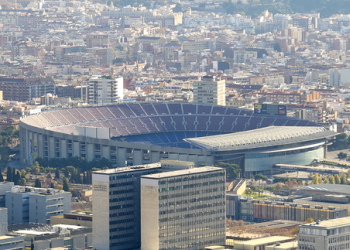
The home of Barcelona is not only an impressive place to watch football because of the size of the ground, though the fact that it is the largest stadium in Europe certainly helps, but also because of how much it represents the people of the city and the surrounding area. Barcelona’s motto is més que un club, or ‘more than a club’, and you get a sense of that when you spend time in the Nou Camp and surrounding area.
The museum at the stadium is the most visited museum in all of Catalonia, which tells you that there is plenty to see there on top of just football memorabilia. Considered to be a ‘temple of football’, Camp Nou first opened in 1957 and has undergone numerous renovations since then. A sign of its cultural importance can be found in the fact that has been used for other purposes, such as when John Paul II hosted mass for more than 121,500 people there in 1982.
ANFIELD – Liverpool
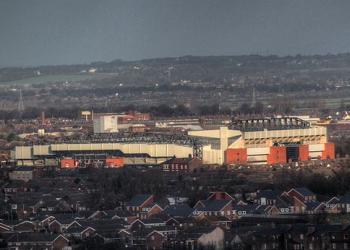
Home of Liverpool Football Club, the most successful side in British footballing history, Anfield is no longer the hot bed of vociferous support for the home side that it once was. That being said, it has hosted some memorable matches in the modern era, such as when the Reds defeated Borussia Dortmund 4-3 in the Europa League in 2016 or when they came back from a 3-0 first-leg deficit in the semi-final of the Champions League in 2019 to win 4-0.
The ground itself has plenty to offer visitors, including a museum that houses all of the European Cups that the team has won over the years as well as a memorial to the 96 supporters that lost their lives at the Hillsborough disaster in 1989. The stadium was originally the home of Merseyside rivals Everton, with the Blue team in the city moving to nearby Goodison Park that you could also fit a visit to if you have time. It’s Anfield that boasts success within its walls, however.
OLD TRAFFORD – Manchester
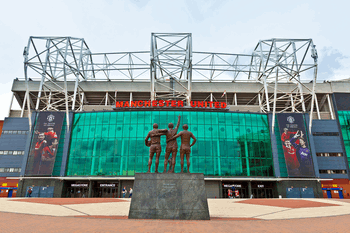
As proof that you need to put footballing rivalries aside when discussing the various merits of a football stadium, Old Trafford is another ground that is worth your time visiting once you’ve been to Anfield. The club that the stadium houses might not be everyone’s cup of tea, but there’s no questioning the fact that the ground itself has hosted some excellent football matches over the years and has been renovated a number of times.
The stadium opened its doors in 1910 and underwent renovations in the mid 2000s, though as it currently is it is in desperate need of a lick of paint in numerous places. The stadium tour is well worth doing, as is a visit to the on-site museum where you can learn about the Busby Babes and the Munich Air Disaster. Alex Ferguson is the club’s most successful manager, so a photograph alongside the statue of the Scot is a must for many.
SAN SIRO – Milan
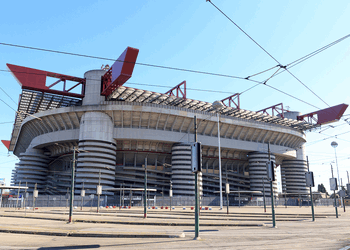
Officially known as the Giuseppe Meazza Stadium, Milan’s San Siro is worth visiting if for no other reason than to figure out how a football ground can successfully house not one but two major teams from the same city. Internazionale and AC Milan both call the ground their home, meaning that the atmosphere on the day of a derby is second to none, not only inside the stadium but all around the city too.
There’s room for more than 75,000 people inside the ground, which opened in 1925. The outside of the venue is iconic in and of itself, with swirling pillars and distinctive corners. It was designed in such a way so as to mean that spectators can see the pitch clearly regardless of where they find themselves, which means that it’s an absolute pleasure to watch a match from within the famous old ground.
Maracanã – Rio de Janeiro
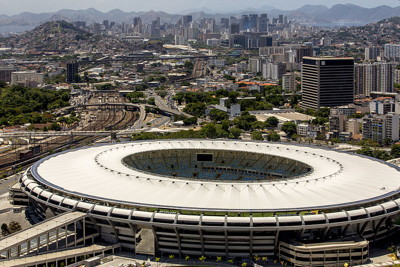
Rio de Janeiro is a vibrant, exciting city to spend time in and the stadium that is located in it reflects the place in many ways. Rio is one the largest settlements in Brazil, housing nearly seven million people , many of whom live far from the Copacabana beach in the Favelas that are found on the edge of the city. The Maracanã was built in the 1940s and the year that it opened saw a record attendance of 199,854 turn up to watch a match, reflecting the city’s own crowded nature.
It is a thrilling venue to visit, even if it has lost some of the originality thanks to numerous renovations that were carried out in 2000s. It is still an imposing and impressive football ground, though, which is why it chosen as the venue for any major sporting events that take place in Brazil such as the World Cup or the Summer Olympics. Only the Estadio Monumental in Peru is larger in the entirety of South America, but that ground doesn’t boast anywhere near the same level of history as the Maracanã.
SIGNAL IDUNA PARK – Dortmund
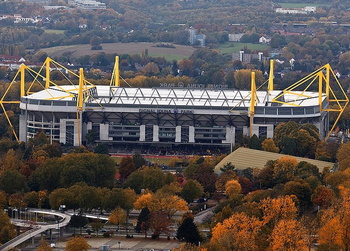
There are many impressive stadiums in Germany, as you might imagine, but few are able to compete with Signal Iduna Park when it comes to spectacle. Home to Borussia Dortmund, the Südtribüne boasts what is known as the ‘Yellow Wall’, with nearly 24,500 fans able to fit inside the terrace. During the 2015-2016 season, more than 81,000 fans attended each game on average, setting a record for attendance and making clear why it’s well worth a visit.
The Westfalenstadion is known for the impressive atmosphere that fans can create, though it’s entirely different from the sort of atmosphere that English football fans would be used to. Instead of ebbing and flowing with the nature of the game, fans make a constant noise throughout the match. As well as touring the stadium, you can also take a trip to the trophy museum and see the likes of the Bundesliga trophies that the club has won over the years. Arrive pre-match and, just like at Anfield at Celtic Park, you’ll hear a rendition of You’ll Never Walk Alone.
CELTIC PARK – Glasgow
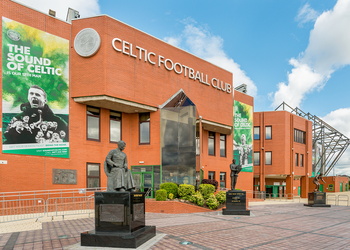
Known to supporters as Parkhead of Paradise, the ground was opened in 1892 and at one point was able to house as many as 83,500 supporters. When Hampden Park isn’t available to host international matches or cup finals it is Celtic Park that the Scottish football authorities turn to, which tells you something about the esteem in which it is held. It’s often forgotten that Celtic won the European Cup in 1967, but you can have a look at the trophy whilst you’re there.
THE EMIRATES – London
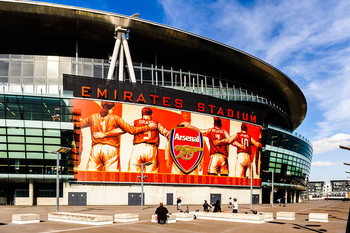
When Arsenal decided to leave Highbury, it was feared that they would be leaving behind a wealth of history and an iconic stadium. Though that is most certainly true, the Emirates stadium is an equally impressive venue to visit and is a great place to watch football. Known as Ashburton Grove before it was sponsored by an airline and referred to Arsenal Stadium when hosting UEFA competitions, it opened in 2006 and can host more than 60,000 supporters.
League success might well have abandoned the Gunners since they left Highbury, but there can be no arguing that the Emirates isn’t a great place to watch football thanks to the modern standard of seating and the manner in which the ground has been designed. The on-site museum underwent a complete renovation before re-opening in 2016, showcasing the club’s history since it was founded in Woolwich in 1886. One of the things you’ll be able to see is the gold Premier League trophy, awarded when they went a season unbeaten.
THE ALLIANZ ARENA – Munich
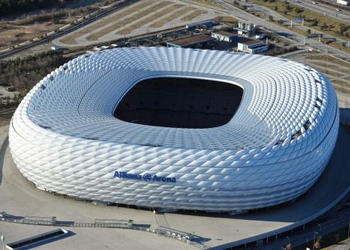
Bayern Munich have called the ground their home since the start of the 2005-2006 season, having previous played at the Munich Olympic Stadium. For a time, the ground also housed 1860 Munich until their rental agreement was terminated in 2017. The museum is the biggest such museum in Germany, which isn’t overly surprising when you realise that it needs to house all of the trophies that the club have won over the years.
TOTTENHAM HOTSPUR STADIUM – London
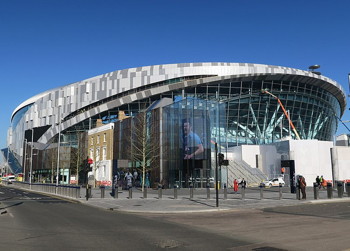
Given the relatively youth of this stadium, which only opened in 2019, it might seem a little strange to have it on this list. Yet it is that youth that, in many ways, ensured its position here. It is incredibly modern and brilliantly designed, ensuring that supporters have a brilliant view of the pitch irrespective of where they find themselves sat. The bowl-design allows for a brilliant atmosphere, whilst the South Stand rivals Dortmund’s Yellow Wall in terms of housing 17,500 fans in a single tier.
The ground was built with the idea of being able to house American Football matches as well as Spurs games in mind, meaning that there are separate facilities for teams from the two sporting disciplines. The Goal Line Bar in the South Stand is 65 metres in length, making it the longest in Europe and therefore well worth a visit for those that enjoy a pint at half-time. The stadium is an impressive and imposing one but also one that remains true to the club’s spirit, which is why it’s somewhere all football fans should go at least once.
La Bombonera – Buenos Aires
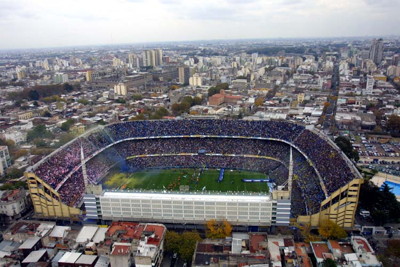
If British football stadium designers would like to get an idea of how to pack a big punch into a small package then a trip to La Bombonera should definitely be on their list. Officially known as the Alberto J. Armando Stadium, it is known as La Bombonera, which translates as ‘the chocolate box’, because of its shape. There is one ‘flat’ stand along one side of the pitch and the other three are steep enough to make your stomach turn.
Owned by Boca Juniors, the stadium was declared of public interest by the Government of Buenos Aires autonomous city, which gives you an idea of how iconic it is. It’s far from the largest stadium on the list, but if you want to think about which stadiums you should visit then it would be madness not to have this one at the forefront of your mind. There are few places in world football that offer the experience of watching a football match that you get from a visit to La Bombonera.

5 must-see football stadiums in Europe
- June 17, 2021
- by Michael Braun
- 3 minutes read
For a few days, the Euros are on and fans get the chance to see football matches in the stadium again. It’s exciting for players and fans after about 1,5 years without any people in the stadium. Even though only a few thousand visitors can go and watch the matches in the stadiums. Football stadiums with their architecture and history are often tourist attractions in big European cities. I will show you the 5 must-see football stadiums in Europe .

Anfield is a stadium in the city of Liverpool . It is the home stadium of Liverpool FC. The football arena opened in September 1884 . Also, it has a seating capacity of around 54.000 which makes it the seventh-largest stadium in England. As Liverpool FC plays in the Premier League, the prices for tickets are quite high. Therefore, I would recommend doing a stadium tour if you want to visit Anfield. The tickets for the tour are around 20€. Especially as a football stadium with a lot of tradition , Anfield is one of the must-see stadiums in Europe .
Allianz Arena

The Allianz Arena in Munich, Germany is the stadium of FC Bayern München. It opened in 2005 with a 75.000 seating capacity . Furthermore, the stadium hosted the Champions League final in 2012 and was a venue of the FIFA World Cup in 2006. The Allianz Arena is known for its inflated plastic panels on the outside of the stadium . In addition to this, it’s the first football stadium with a full color-changing exterior . It is the second-largest in Germany. The Allianz Arena is also one of the most modern stadiums in Europe.
Football stadiums: Camp Nou

Another must-see football stadium in Europe is the Camp Nou in Barcelona , Spain. With a 99.354 seating capacity , the Camp Nou is the largest football stadium in Europe . Since 1957 the FC Barcelona is hosting its home matches in Camp Nou. The plan for increasing the capacity started last year and is supposed to be finished in 2024. I also would recommend you doing a stadium tour of Camp Nou to get some impressions of this incredible football stadium. Camp Nou should be on your list for your trip to Barcelona.
Estádio Municipal de Braga
The Estádio Municipal de Braga in Braga, Portugal is a stadium that you should definitely visit. This is not because of the performance of Sporting Braga. In fact, the club usually has to admit defeat to other clubs in the league. The stadium is a must-see because of its architecture . Its main stand is carved into the massive rock face of Monte Castro , which rises in the air behind the goal. Therefore, Sporting Braga has the most amazing stadium panorama in European professional football.
Football stadiums: Wembley Stadium
The Wembley Stadium is located in London, England . After the demolition of the old Wembley Stadium, the new one was built between the years 2003 and 2007. It has a 90.000 seating capacity and because of that, it’s the second-largest football stadium in Europe . Apart from football, concerts are also taking place in the Wembley stadium.

San Siro is located in the city of Milan , Italy. The stadium is the home of the football clubs AC Milan and Inter Milan. It has space for about 76.000 people . It is also the largest arena in the country. The San Siro hosted matches of the World Cup in 1934 and 1990 and the Euros in 1980. It opened in the year 1923. If you are interested in sports, the San Siro should be on your travel list.
Click here to get some tips for a holiday in Austria.
Recommended For You

Best Tennis Courts in Malaga Where to Play: Top 5

10 Traditional Spanish Dishes you should try

Live Music in Malaga: Top Bars and Clubs to Visit

Best Sports Bars in Malaga to watch Football and More: Top 10

Where to Eat the Best Paella in Seville: Top 7 Places

Holy Week in Malaga 2024: Dates and Events

Privacy Overview

The Most Unique Stadiums to Visit in 2024
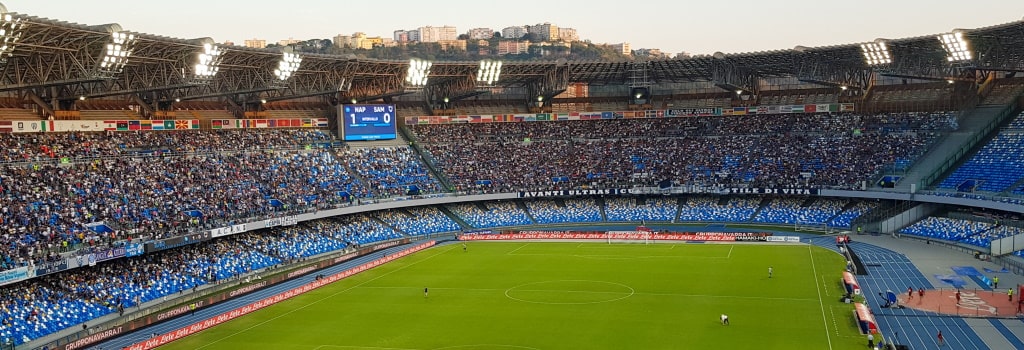
As we step into 2024, the world of football (soccer) offers more than just the excitement of the game. It's an invitation to explore some of the most unique stadiums around the globe. These aren't just places to watch a match. They are also symbols of cultural heritage and hubs of thrilling fan experiences. Let's embark on a journey to discover the most unique stadiums you should consider visiting this year.
Camp Nou, Barcelona (FC Barcelona)
Our first stop is Camp Nou in Barcelona, the largest stadium in Europe. No matter if you are a diehard fan or you only bet on soccer Betway , you certainly heard of it.
Home to FC Barcelona, this colossal structure is more than just a sports venue; it's a pilgrimage site for football enthusiasts. With a seating capacity close to 100,000, the atmosphere here is electric. The stadium's design, which brings fans close to the pitch, amplifies the vibrant energy of the crowd. Following several upgrades, Camp Nou now boasts modern amenities like an extensive Wi-Fi network and public areas. Whether it's for the El Classico or a Champions League night, a visit to Camp Nou is a quintessential experience for any football fan.
Allianz Arena, Munich (Bayern München)
Next, let's head to Munich's Allianz Arena, a marvel of modern architecture. Known for its luminous exterior, this stadium creates a spectacular view that matches the colors of the home team, Bayern München. With a capacity of nearly 75,000, the roar inside the arena during match days is truly unmatched. The Allianz Arena blends luxury with passion, as evident in its plush leather luxury box seats and the fervent energy of the fans. Despite its relatively recent inauguration, it has quickly become a landmark in the football world.
Estadio Diego Armando Maradona, Napoli (SSC Napoli)
In Naples, the Estadio Diego Armando Maradona stands as a testament to one of football's greatest legends. While it may not boast the latest in stadium amenities, the electrifying atmosphere on game day more than makes up for it. Hosting nearly 60,000 fans, the legacy of Maradona looms large here, making it a must-visit for those who cherish football history and culture. The stadium's sheer aura and the passion of SSC Napoli's fans make every match an event to remember.
Alberto Jose Armando Stadium, Buenos Aires
La Bombonera in Buenos Aires is next on our list. The Alberto Jose Armando Stadium, known only as "La Bombonera", is home to the Boca Juniors. It is famous for providing one of the best home-field advantages in the sport.
The stadium's unique feature is its ability to 'shake' during high-energy matches. This creates a thrilling experience for fans. The intense atmosphere here is something every football fan should experience at least once.
Maracana, Rio De Janeiro
Last but not least, we travel to Rio de Janeiro's Maracana, a stadium that captures the essence of Brazilian football. Renovated recently, it combines modern efficiency with traditional charm. This stadium has hosted numerous World Cup and Copa America matches, making it a historical landmark in the football world. With a capacity of 80,000, the Maracana offers an unmatched fan experience, especially during international tournaments.
These stadiums are more than just venues for football matches. They are also cultural landmarks that offer a glimpse into the soul of the sport. Visiting them isn't about watching a game; it's about experiencing football history. Their architecture, and passionate fan culture make football a beautiful game. So grab your jersey, pack your enthusiasm, and get ready to explore the world of football like never before in 2024!
More articles from Football Ground Map...

My Daughter's First Football Match
My daughter's first ever football match - Orlando City v Atlanta United, August 2019. Written for Izzy to read when she gets old enough. Vamos Orlando
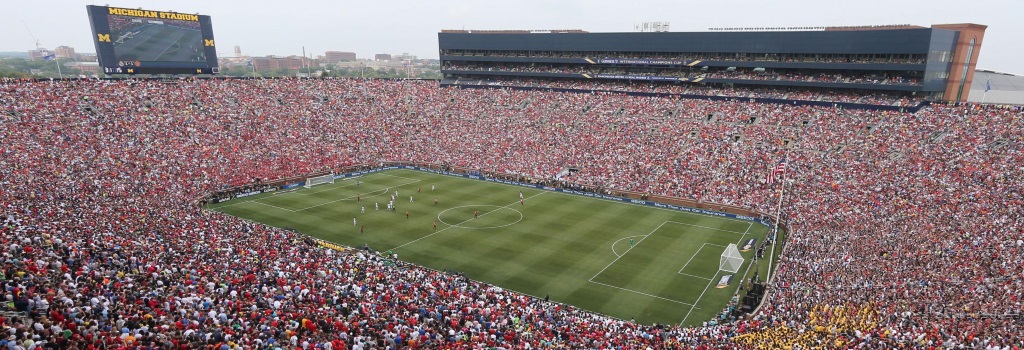
The biggest football attendances ever recorded
An in-depth look at the biggest football attendances ever recorded, from the 1950 World Cup to pre-season friendlies in the States and the Scottish ground with dozens of 100,000+ attendances

My Son's First Football Match
Taking my son to his first football match was one of the best experiences I've had as a father so far. I've written this article for Alex to read when he gets older.

Surviving football boredom - a football fans' guide
23 interesting things to do to pass the time until the football season restarts


- Meet The Team
- Our Newsletter
- Arsenal Tickets & Hospitality
- Aston Villa Tickets & Hospitality
- Bournemouth Tickets
- Brentford Tickets & Hospitality
- Brighton & Hove Albion Tickets & Hospitality
- Burnley Tickets
- Chelsea Tickets & Hospitality
- Crystal Palace Tickets & Hospitality
- Everton Tickets & Hospitality
- Fulham Tickets & Hospitality
- Liverpool Tickets & Hospitality
- Luton Town Tickets & Hospitality
- Manchester City Tickets & Hospitality
- Manchester United Tickets & Hospitality
- Newcastle United Tickets & Hospitality
- Nottingham Forest Tickets
- Sheffield United Tickets & Hospitality
- Tottenham Hotspur Tickets & Hospitality
- West Ham United Tickets & Hospitality
- Wolverhampton Wanderers Tickets
- Blackburn Rovers Tickets
- Cardiff City Tickets
- Charlton Athletic Tickets & Hospitality
- Leeds United Tickets & Hospitality
- Leicester City Tickets & Hospitality
- Millwall Tickets
- Queens Park Rangers Tickets & Hospitality
- Southampton Tickets & Hospitality
- Watford Tickets & Hospitality
- Wimbledon Tickets
- Community Shield Tickets & Hospitality
- FA Cup Tickets & Hospitality
- League Cup Tickets & Hospitality
- England National Team Tickets & Hospitality
- Wembley Tickets & Hospitality
- Celtic Tickets & Hospitality
- Rangers Tickets and Hospitality
- UEFA Champions League Tickets & Hospitality
- UEFA Europa League Tickets & Hospitality
- UEFA Europa Conference League Tickets & Hospitality
- Bayer Leverkusen Tickets & Hospitality
- Bayern Munich Tickets & Hospitality
- Borussia Dortmund Tickets & Hospitality
- Feyenoord Tickets & Hospitality
- PSV Eindhoven Tickets & Hospitality
- Athletic Bilbao Tickets
- Atlético Madrid Tickets & Hospitality
- Barcelona Tickets & Hospitality
- Las Palmas Tickets
- Mallorca Tickets
- Real Betis Tickets and Hospitality
- Real Madrid Tickets & Hospitality
- Real Sociedad Tickets & Hospitality
- Sevilla Tickets and Hospitality
- Lille Tickets & Hospitality
- Lyon Tickets
- Nice Tickets
- Olympique Marseille Tickets & Hospitality
- Paris Saint-Germain Tickets & Hospitality
- AC Milan Tickets & Hospitality
- Inter Milan Tickets & Hospitality
- Juventus Tickets & Hospitality
- Lazio Tickets & Hospitality
- Napoli Tickets and Hospitality
- Roma Tickets & Hospitality
- Belgian Tickets & Hospitality
- Benfica Tickets
- Porto Tickets & Hospitality
- Sporting Lisbon Tickets & Hospitality
- Euro 2024 Tickets & Hospitality
- Copa América 2024 Tickets & Hospitality
- Ticket and Hospitality Refund Policy
- Hire a Guide!
- “Group Groundhops”
- Group Groundhops FAQ
- Soccer Travel Consulting
- Guides and Group Groundhops
- Travel Tips
- How To Watch
- Suggested Reading & Viewing
- Women’s Football
- Premier League
- Championship
- Scottish Premiership
- Netherlands
- Clubs in the UK
- Clubs in Europe
- Clubs in the Americas
- Derbies & Rivalries
- Women’s Football
- Paul’s Soccer Stories
- Referral Program
A Guide to the Must See Historic Football Stadiums in England

One of the best things about seeing games in person is that many of the English football stadiums are worthy destinations in their own right. So here’s our football ground guide of stadiums in England that we think should be at the top of your groundhopping wish list.
What makes English Football Grounds so Great?
Stadiums can be all sorts of shapes, sizes and styles, and they can have very different sets of characteristics. Many English clubs are building fancy modern homes, like the new Tottenham Hotspur Stadium .
For us at Groundhopper Soccer Guides, though, it’s all about the historic soccer stadiums in England, the ones that have housed their clubs for many decades. They aren’t the most comfortable, but they are right in the middle of town, are beloved by fans, and are a part of the fabric of their club.
The Older English Football Stadiums Are Being Replaced
For about twenty years now, England has been engaging in a slow-motion bad idea—similar to something America did in the 1960s and 1970s. They are tearing down old grounds full of character and history, but lacking in space and facilities and corporate boxes, and replacing them with clean, comfortable, sterile, and utterly crap stadiums that everyone seems to agree are better and necessary as well as boring and awful.
Want to see what I mean about these modern stadiums? Go to Southampton, Stoke, Sunderland, Reading, Leicester, or Swansea.
In the States, think about the Polo Grounds giving way to Shea Stadium, or Comiskey Park giving way to wherever the White Sox play now. Or just contemplate Wrigley or Fenway coming down.
So put these English football stadiums, from the top two divisions, high on your list to visit on your next trip to England ( and let us help you plan it! ).
Check Out Our Map of English Football Clubs
Premier league stadiums in our football ground guide.

The Gwladys End seats just over 10,000.
Let’s start with Everton stadium, Goodison Park . They call it the Grand Old Lady, and Goodison Park defines many of the things I love about English soccer stadiums. It’s tucked into a neighborhood so tightly there’s a church inside it; there are pubs directly across a small street; it remains beautiful and old-fashioned; its wood seats are cramped; views are obstructed; everybody agrees it has to be replaced; and everyone is sad about that fact.
Americans: Imagine if you knew the Cubs were about to leave Wrigley. You would hurry up and go, right?
The Bullens Stand was built in 1926 and only updated for fire safety in 1960; it’s one of only three that still has its distinctive trusses from famed architect Archibald Leitch. ( Portsmouth’s Fratton Park is another). The Goodison Road Stand was built in 1971 but isn’t actually straight; one end curves in a bit because the property itself isn’t square. The Gwladys Street End is another Leitch stand from 1938.
Unfortunately, the 2024-25 season will be Everton’s last season at Goodison Park as they are moving to their new Everton Stadium following the conclusion of the season. Be sure to catch a game at Goodison Park before it’s gone for good!
Take a Tour of Everton’s Goodison Park
Next up is Burnley’s Turf Moor — what a name. Burnley’s home since 1883 is also the longest continually used stadium ever to be in the Premier League. Both it and Burnley itself are probably smaller than you think: The Clarets average 20,000 a game in a town of 73,000.

Kickoff at the Burnley Stadium, Turf Moor.
One side and one end were redeveloped in the mid-1990s and are two-tiered, but the other side and end, the Bob Lord Stand and the David Fishwick Stand, date from 1974 and 1969, and both have wooden seats. Like Goodison, Turf Moor is right in the middle of town, with pubs and places to eat right across the street.
See a Game at the Burnley Stadium, Turf Moor
Our next two Premier League clubs both have stadiums in London: Crystal Palace and Fulham .

View form the Main Stand at Crystal Palace’s Selhurst Park
Palace’s Selhurst Park, in the South London area of the same name, is tucked into its neighborhood so tightly that there’s actually a grocery store in it. Across every street are houses, and inside is seating for 26,074 people.
The Main Stand is actually the smallest and is original, dating to 1924. They plan to replace it and add 8,000 seats to the capacity; this has been approved by the local council but isn’t expected to be completed until 2023 at the earliest.
It’s another example of how English football stadiums are being rebuilt and updated for obvious financial reasons, but how a certain historical charm can be sacrificed along the way. Of course, having legroom for people over 5-foot-10 will be welcome!
By the way, Selhurst Park is one of the Ted Lasso filming locations around London, posing as the home of AFC Richmond.
We Sell Crystal Palace Tickets and Hospitality Packages
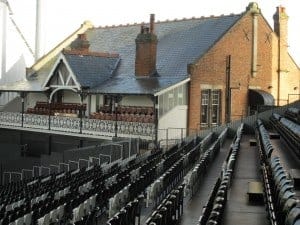
The cottage itself at the Fulham stadium.
The Johnny Haynes Stand at Fulham’s Craven Cottage is actually a historically protected building, one reason it hasn’t been updated (you might wish this were different when you try to pee at halftime). The other three stands are much more modern, but just to walk up Stevenson Road for a game at Fulham makes you think it’s still the 1870s, when the club was founded.
The most famous thing about the Fulham stadium is the cottage itself (right), which was built with the Haynes Stand in 1904. The designer forgot to include dressing rooms, so they added the cabin! It still hosts the tiny dressing rooms and manager’s office. There are three rows of wood seats on the balcony where the players’ families sit during the game.
Fulham has been working on a massive 4+ year project to completely redo the Riverside stand which should be fully opened during the 2023-24 season.
Another must-see Premier League stadium is Bramall Lane at Sheffield United , known by Blades as “Beautiful Downtown Bramall Lane.” And it truly is downtown, just minutes from the train station. It is also the oldest stadium in the world still hosting professional football; people have been playing football on this spot since 1855!

Exterior of Sheffield United’s Bramall Lane.
Obviously, the place has had some work since then, but it still feels historic and cozy, even with just over 32,000 seats. And when they all sing the Greasy Chip Butty Song pregame, you’ll have a proper English football experience!
That Time I Saw The Steel City Derby with Sheffield Wednesday at the Lane
For our next Premier League stadium in our historic football ground guide, we go just up the road in Yorkshire to the Leeds United stadium, Elland Road . This is absolutely one of my favorite English football stadiums, with its combination of old and new, a central location, and what feels like just the right size.

Elland Road at Leeds United has a great mix of old and new.
Look around for pieces of the old days like brick walls left up near entrances. The site was the home of Leeds City FC before United came into existence, so football has been played here since the 1890s. Today it holds 37,890 people in four stands, the most recent of which was built in 1993. And few places can match the atmosphere, as you’ll see in the Netflix documentary Take Us Home Leeds United .
Sometimes you can even take a tour of Elland Road ; they are offered on game days, and they sell out quickly. Check the website for details. My tour was led by a longtime staffer named “Sticks” whose Yorkshire accent and storytelling alone were worth the price of admission. Tell ’em you want a tour with Sticks!

The former Main Stand terraces at Luton Town’s Kenilworth Road
Many English football fans might cringe at this one, but I just love Luton Town’s Kenilworth Road , with its weird angles, floodlight towers blocking some views, chipped paint and plastic seats nailed onto old conrete terraces. Even Luton fans call “the Kenny” a dump, but they lovingly add, “It’s our dump.”
Many away fans, who enter their stand between people’s flats, would disagree. But others have told me it’s one of the last proper football grounds in England , and I feel the same way.
With Luton Town’s recent promotion to the Premier League, Kenilworth Road has undergone significant renovations to adhere to Premier League stadium and pitch standards.
English Football Stadiums Beyond the Premier League
Many of the best football grounds in England are below the top tier of the league pyramid . Let’s look quickly at some of those.

Vicarage Road, home of Watford FC.
Watford’s Vicarage Road is not one of the oldest football stadiums in England, but the work they have done to update it has really kept its historical character. And at just under 22,000 seats in a convenient location, it’s a great way to get close to terrific football. Probably its most famous aspect, named for a former chairman, is the Sir Elton John Stand. Along the top of the stand is a long quote from “Your Song.” When they dedicated it to him in 2014, he famously said that not only did he never think he’d have a stand named for him, “I never thought I would sit in a stand!”

Loftus Road in West London, home of Queens Park Rangers.
Another of the most enjoyable old stadiums in London is Loftus Road, home of Queens Park Rangers . Far from being the most glamorous ground, it will get you closer to the pitch — and the person in front of you! — than many stadiums in England. It’s got just 18,000 seats, but again it’s tucked into the very cool Shepherd’s Bush area of London and surrounded by restaurants and pubs.

Norwich City’s Carrow Road, here hosting bitter rivals Ipswich Town.
Staying in the Championship League, it’s off to Carrow Road, home of Norwich City . Another traditional club and ground in the middle of town, Carrow Road is also really, really green and yellow. It holds 27,244 and was built in 1935, and of course there’s been a lot of work done since, but infill at the corners makes it feel nearly closed in and cozy — and loud.
It also has great banter between home and away fans, as the most passionate City fans sit in the Barclay End behind a goal and the away fans are just across the corner in the near end of the South Stand, which is actually named for a former club chairman named Sir Arthur South.
Take a Walking Tour of the Wonderful City of Norwich
Since I put Sheffield United in here, I would be remiss (and rebuked) were I to leave out their great rivals, Sheffield Wednesday . It’s a shame their home ground, Hillsborough, is known by many people as the place where 96 Liverpool fans died in a 1989 crush. Fact is (sorry, Blades!), it’s a terrific old stadium.

Hillsborough Stadium is the home of Sheffield Wednesday in the English League Championship.
Hillsborough has been Wednesday’s home since 1899, and it hosted World Cup matches in 1966 and European Championship games in 1996, but hasn’t had much work done since then. The North Stand opened in 1961 (with a friendly match against Pele’s Brazilian club team) and was the first in the country to run the whole length of the pitch.
I saw an amazing Steel City derby there , although it’s one Wednesday fans will want to forget.

The 1935 North Stand at Portsmouth’s Fratton Park.
And for our last must-see stadium in this football grounds guide, it’s down to the south coast to Portsmouth FC , currently in League One. It’s the only home the team has ever had, and the two side stands date from 1925 (the South Stand at the top of this post) and 1935 (right). Everything about the South Stand in particular just screams old school, especially the (mock, but who cares) Tudor facade that houses a ticket office and an entrance. It was also designed by famous architect Archibald Leitch.
They have been saying for years that they want and need a new stadium, so please, get to Fratton Park ( and learn more about “Pompey” before you go ) before they go and build whatever boring atrocity they are almost certain to replace it with.
Related Posts

It should go without saying that we at Groundhopper Guides love us some English football…

A Footballing Tour of London: Interactive Storymap As the 2016/17 English Premier League began, a…
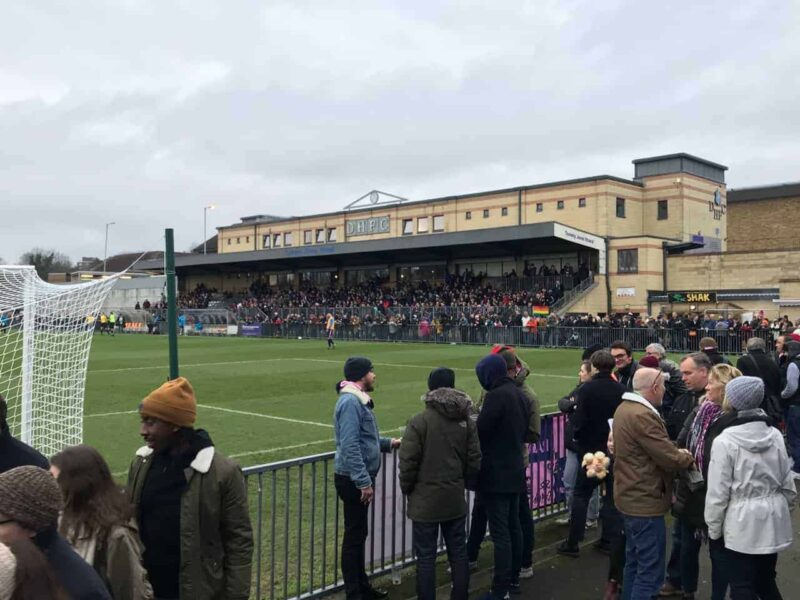
The whole reason for starting Groundhopper Soccer Guides was to help people enjoy watching English…
Post Comments
Privacy overview.

The Club Wembley Private Suite includes:
- Private 12-seater box around Block 229, West Stand
- Premium padded seats directly in front of the suite
- Designated VIP entrance
- Access to the suite from 3 hours before kick-off and 1.5 hours after
- Pre-match 3-course dining in the suite
- Beers, wines, and soft drinks are included in the price. Spirits can be ordered and paid on the day.
- Official event program
Photo shows the location of the seats.
The West Block Club Wembley seats include:
- Wide padded seats behind the goal, Blocks 232-242
- Matchday program
- Access to exclusive restaurants and bars

USF football: 55 pages to build Bulls’ on-campus stadium
T he construction team chosen to build USF football’s on-campus stadium touted its budget control, local ties and experience — including the ongoing renovation of Florida State’s Doak Campbell Stadium.
Those selling points are among the details in the 55-page proposal submitted to USF by Manhattan Construction Company, H.J. Russell & Company and DuCon, LLC. Last week, the Bulls announced they were moving forward with that trio to build the $340 million, 35,000-seat stadium just north of the current football practice facilities.
“This is a powerful combination of local relationships and national buying power with specialty vendors associated with sports projects …” the companies wrote. “We are thrilled to support your vision to transform USF Athletics into a modern, elite, and innovative athletic department in delivering a state-of-the-art stadium and sports performance facility for the development of the football and women’s lacrosse programs, creating a sense of community and shared experience among students, staff, alumni, supporters, and faculty.
“Let’s bring the Bulls Home.”
The proposal, obtained Tuesday through an open-records request, offers some financial estimates and construction details. The Manhattan group had the lowest fee for overhead/profit among the bidders: 2.25%. It projected $488,000 in pre-construction fees and $16.1 million in general conditions or indirect costs.
The total construction budget ($324 million) was the same in the proposals from Manhattan and two competitors (Austin Commercial L.P. and the M.A. Mortenson Company). USF previously authorized up to $22 million for design.
The winning bidders wrote they “have confidence that the project timeline is attainable.” They’ve also already spoken with a consulting group about an approach that would speed up the arrival of steel by at least two months.
The proposal broke the project into three groups. The first is the operations center — the day-to-day home for football and women’s lacrosse. Its project manager, Rachel Bauer, has that same role with the football center being built at Texas Tech. The bid vows to have USF’s facility ready in May 2026, a year before the stadium opens.
“We understand the importance of ensuring the early delivery of the (operations center) to support USF’s strategic goal for recruiting and retaining athletics staff, attracting athletes, player performance development, and developing the women’s lacrosse program,” the bid reads.
The second is the stadium itself. Management includes David Steger, who helped build Houston’s 40,000-seat stadium , and Ed Martin, who worked on recent renovations to Raymond James Stadium and 20-plus projects at USF. They’ll build the stadium counterclockwise with two concurrent crews — one starting on the southwest corner, the other on the northeast.
“ This effort will prioritize the south tower providing ample time for suites, concessions, and press box construction,” the bid reads.
The third group involves utilities and the site while being “accountable for the safety of students, faculty, and guests of USF.”
Manhattan’s bid listed 53 staffers, including 24 project managers and 15 superintendents. It also has at least two engineering interns from USF. Manhattan and DuCon both have Tampa offices.
The firms highlighted their stadium experience. Manhattan built North Texas’ 30,850-seat DATCU Stadium in 2011; that venue helped the Mean Green join the Bulls in the American Athletic Conference a decade later. The partners’ portfolio advertised $1.2 billion worth of work with Populous, the architecture firm designing USF’s stadium. Populous and the builders reached final budgets on two projects in the last year. The portfolio also counts the recent installation of more than 864,741 athletic seats and more than 18 million square feet of athletic space.
Their ongoing projects include the Bradenton Area Convention Center, a utility maintenance facility in Plant City and the nine-figure overhaul to the west and south sides of Doak. More than $65 million in work remains at FSU, but the companies wrote it’s still on track to be ready in July 2025. They said they saved $4 million and two months of work by pivoting to a different foundation system for Tallahassee’s sandy clay soil.
The firms’ top priority is staying on budget. That means creating detailed estimates, having “honest, professional, and tough conversations when needed” and pausing if necessary to run the numbers.
“This is how we guarantee to you that we can achieve the early deliverable for the Sports Performance Center on May 29th, 2026 and ready for game day on March 31st, 2027,” the companies wrote. “We never miss a game!!”
Groundbreaking is scheduled for October.
Sign up for the Sports Today newsletter to get daily updates on the Bucs, Rays, Lightning and college football across Florida.
Never miss out on the latest with your favorite Tampa Bay sports teams. Follow our coverage on Instagram , X and Facebook .
©2024 Tampa Bay Times. Visit tampabay.com. Distributed by Tribune Content Agency, LLC.
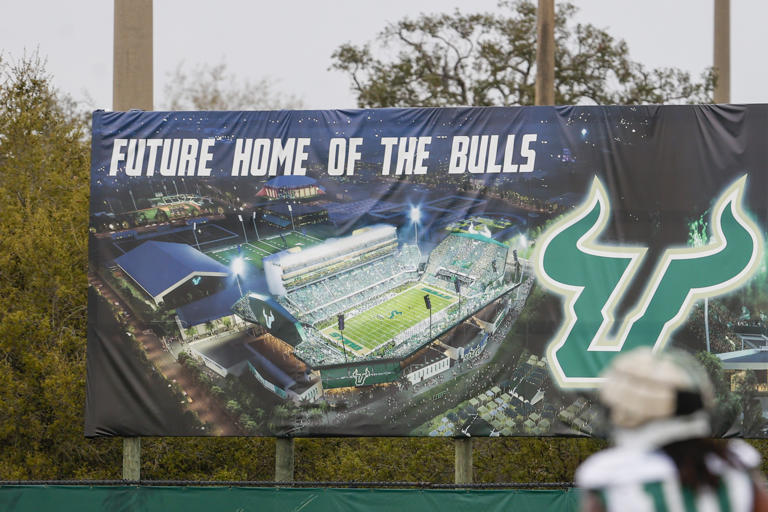
WATCH: Chicago Bears' announcement on new stadium plans in the city
The announcement, set to take place at 12 p.m., will be made "in collaboration with city officials and stakeholders” at the bears' current home, soldier field, the team said in a press release, by nbc chicago staff • published april 24, 2024.
UPDATE: See the full announcement from the Chicago Bears here .
The Chicago Bears will make a big announcement Wednesday as they reveal some of their first plans for a new, " state-of-the-art, publicly owned enclosed stadium " along Chicago's lakefront.
Watch NBC Chicago local news and weather for free 24/7
The announcement, set to take place at 12 p.m., will be made "in collaboration with city officials and stakeholders” at the Bears' current home, Soldier Field, the team said in a press release. The Bears said they will also announce plans for green and open space along the lakefront, with preserved access to the shoreline for families on the Museum Campus, according to the release.
The press conference will be streamed live in the player above once it begins.
Feeling out of the loop? We'll catch you up on the Chicago news you need to know. Sign up for the weekly Chicago Catch-Up newsletter here.
According to a report from the Chicago Tribune , the stadium would cost approximately $4.6 billion to build, with taxpayers financing roughly half of the cost.
After purchasing land in suburban Arlington Heights for a proposed domed stadium , the team recently changed course and committed to building in Chicago , setting their sights on a “publicly-owned” stadium on the city’s lakefront, located near their current home at Soldier Field.
The move could be seen as an attempt to ease concerns from preservation group Friends of the Parks , which successfully sued to prevent George Lucas from building a museum along the lakefront and has previously voiced opposition to the construction of any new stadium project on Museum Campus.
Chicago Bears

Why Bears were especially excited to land Rome Odunze with the No. 9 pick

Caleb Williams reveals moment he knew he was going to be a Chicago Bear
Friends of the Parks declined comment ahead of the Bears' announced press conference.
The Bears' plans have also faced increased scrutiny amid a separate push from the Chicago White Sox to secure public funding for a stadium project in the South Loop. According to a recent Crain's report , the teams have been told that there is little appetite on the part of lawmakers to approve separate financing plans for stadiums, and urged the two teams to work together.
The Bears have pledged up to $2 billion in private funding for a stadium , but have not announced other financing details ahead of Wednesday's press conference.
What would it take for the Bears to build a new stadium in Chicago?
The Bears must overcome several obstacles to make the domed stadium on the lakefront a reality.
The first is ensuring a healthy, long-term relationship between the team and the park district. Given their rocky history, that bridge might be harder to cross than it sounds.
"I believe in people, I believe in relationships," Warren said about the park district-team relationship. "And even since I've been able to be here and spend time with individuals at Soldier Field, individuals at the park district, individuals in the city of Chicago, I've only been welcomed. And we've had a great relationship. And I think people have seen that. They feel it. And I'm just confident that when you have a common goal that people can focus on and come together, I'm confident that we'll have a positive relationship as we go forward. And so one of the things I promised myself when I started on April 17 of last year was that I was going to understand and appreciate and embrace the history of the Chicago Bears and all the relationships. But any tension or negativity, I was not going to take it forward.
MORE: Bears' new stadium plan raises funding questions as taxpayers still owe $589M on Soldier Field
"And so I started from scratch. And I feel that we have not only great from a business relationship, but we've developed a personal relationship. And we work together very well. So I'm pleased with the way that it's gone. And I look forward to even building stronger relationships in the future. So that's an area that’s not really a concern of mine."
As far as the thought that the lakefront project would require more than $1 billion in public infrastructure investment, Warren views the investment, whatever the number is, as good for the city of Chicago as it looks to compete against other cities in the marketplace.
"Those are things that we're working on. And one thing that I can guarantee you, I am fiscally conservative, and I am financially responsible," Warren said when asked about public funding. "So anything that we recommend, from a financial standpoint, will be very well thought out."
Warren cited a Sports Business Journal article that did not have Chicago in "Top 25 Sports Business Cities" as evidence that the investment is needed.
"But to think Chicago, you know, with this massive background, all the professional sports teams we have, the beautiful landscape, the topography, all those things involved, known for an incredible sports city. For us not to be on that list, from a business standpoint, those are the things that as a citizen of downtown Chicago and the state of Illinois, those are things from a business standpoint, concern me I look forward to the day that events like [the NFL league meetings] should and can be and will be held in downtown Chicago."
What will happen to the Bears' land in Arlington Heights?
Bears President Kevin Warren recently discussed the change of direction in the team's plans during media availabilities at the NFL league meetings in Orlando .
When asked about the Bears' pivot to the lakefront and the steam their plan is gaining, Warren noted there is still a long way to go, but he believes things are moving in the right direction.
"All of these projects are, you know, that's a great word. They require momentum. They require vision," Warren said. "They require tenacity. They require a lot of thought and planning, but they also require momentum. And I strongly believe that we're building momentum to that museum area.
"So when you have that combination of the museum, the lakefront, the beach, the architecture, and most of all, what makes Chicago special is the people. And so when you can mix that together, you do get great momentum, but it's going to require a lot of work as we proceed forward."
Warren and the Bears are happy to own the Arlington Park property , but their sights are set on downtown.
"We are the largest landowner in Arlington Heights right now. 326 acres," Warren said. "We own a beautiful piece of land. And I have great respect for Mayor Hayes and Randy Recklaus and all of the politicians there. My belief right now, these projects are incredibly difficult. And just learning the various things that I did in Minnesota, you have to be laser-focused. And right now, we're putting our energy to downtown Chicago, to the museum campus, just from an energy and resource standpoint. So we still own the land. We’re the largest landowner. We’ll stay in communication with Arlington Heights, but the focus now has to be on Chicago to give us the best opportunity for success."
Arlington Heights officials said they will be ready and waiting for if the Bears change their minds, however.
"There’s a lot of challenges ahead with respect to the lakefront stadium in terms of financing and opposition by interest groups like Friends of the Parks… We stand ready to continue discussions with the Bears if they do get a no on the lakefront," Mayor Tom Hayes told NBC Chicago.
He added that while the village is respectful of the Bears' plan to explore a lakefront stadium, they believe the Arlington Heights property is a better fit.
“Other than a lake which we don’t have in Arlington heights, I think everything else in Arlington heights is a better solution for them," he said.
Click here to follow the Under Center Podcast.
This article tagged under:

Check out new renderings for the Bears stadium on Chicago's lakefront
The renderings include a dome with the stadium atop the south parking lot, by ryan taylor • published april 24, 2024 • updated on april 24, 2024 at 5:25 pm.
Ahead of the Bears' press conference unveiling their plans for a new stadium on Wednesday, they released photographic renderings of the stadium on the lakefront.
The renderings include the domed stadium, with the stadium atop the current South Parking lot of Soldier Field. As for Soldier Field, the columns exist, but the stadium is gone.
Here are all the renderings of the stadium. Click here to check out the renderings released by the team.
Stay in the game with the latest updates on your beloved Chicago sports teams! Sign up here for our All Access Daily newsletter.

More on Bears Stadium
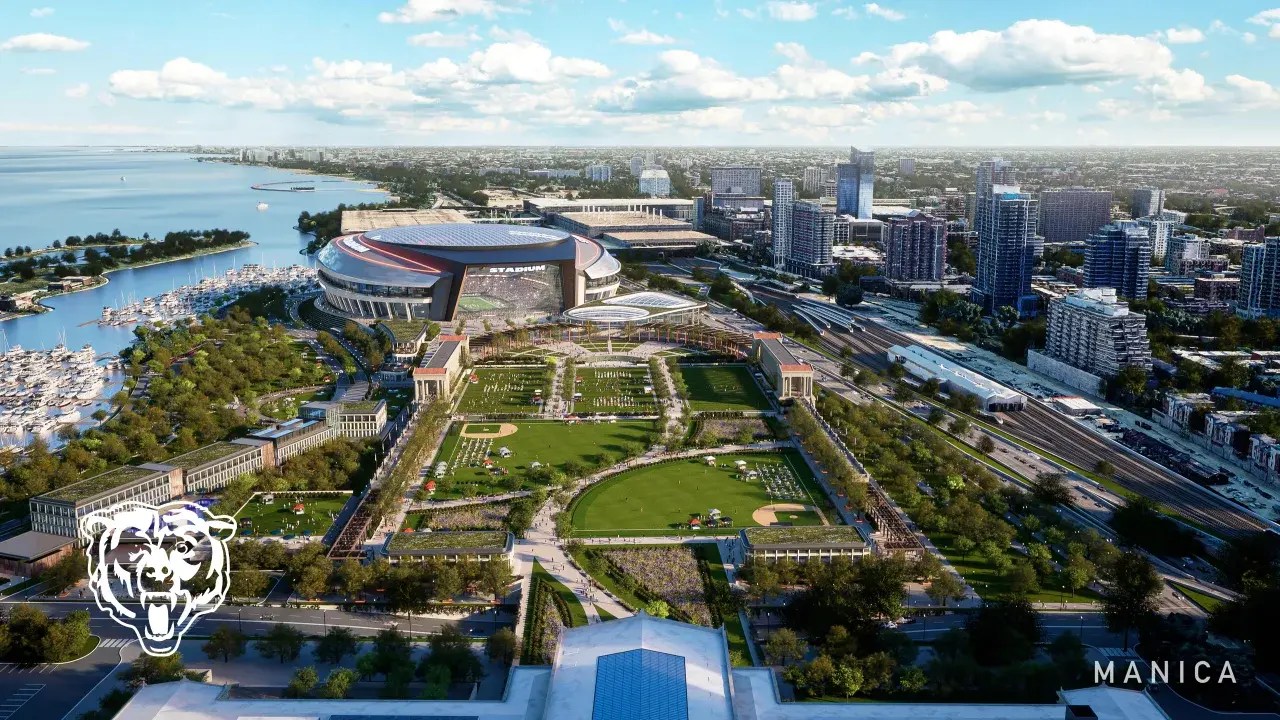
Here's the compelling stadium hype video the Bears played at their press conference
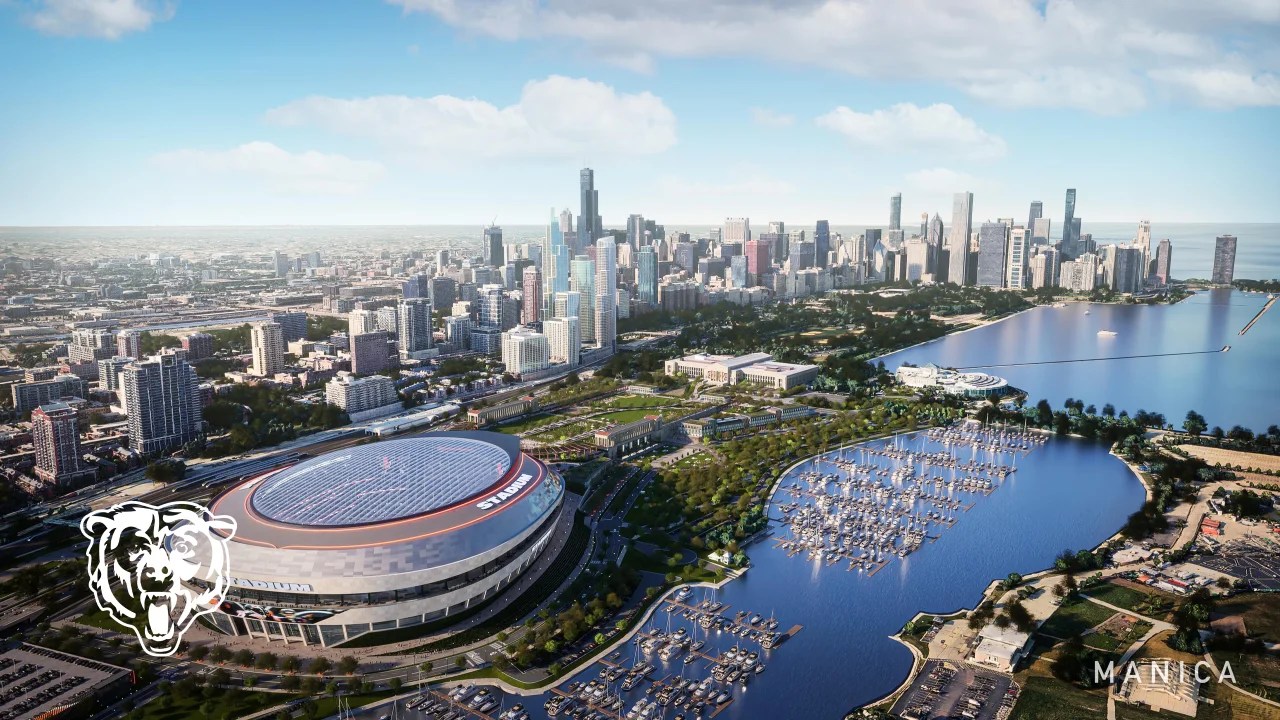
Why do Bears want to build fixed-roof dome? President shares new details explaining decision
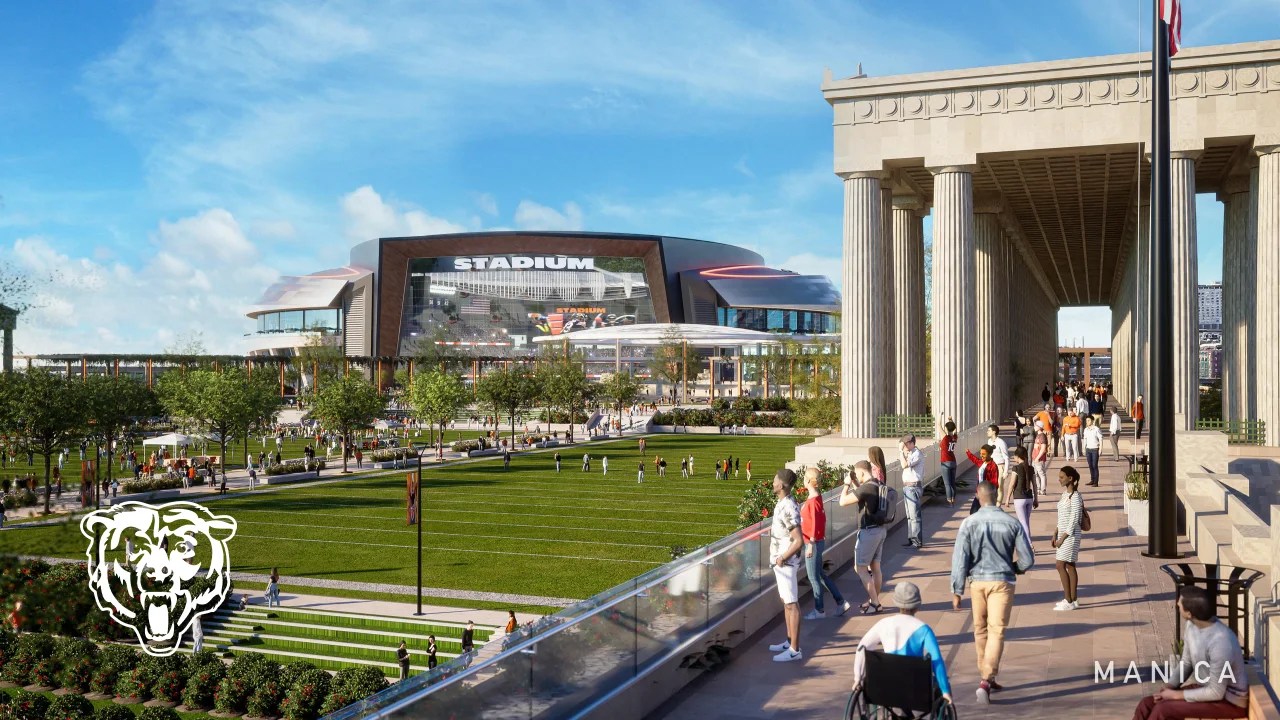
Friends of the Parks responds to Bears' new stadium proposal

Click here to follow the Under Center Podcast.
This article tagged under:
- Josh Schrock
- Free Agency
- Training Camp
- K.C. Johnson
- Charlie Roumeliotis
- Spring Training
- Newsletters
- newsletters
Bears unveil $5B proposal for new domed lakefront stadium
Field Yates breaks down tape of likely No. 1 NFL draft pick Caleb Williams, focusing on his elusiveness on the run and functional arm strength. (2:41)
- ESPN News Services

CHICAGO -- The Bears unveiled a nearly $5 billion proposal Wednesday for an enclosed stadium next door to their current home at Soldier Field as part of a major project that would transform the city's lakefront, and they are asking for public funding to help make it happen.
The plan calls for $3.2 billion for the new stadium plus an additional $1.5 billion in infrastructure. The team and the city said the project would add green and open space while improving access to the city's Museum Campus and also could include a publicly owned hotel.
"This is not an easy project, but Chicago doesn't like it easy," Bears president Kevin Warren said.
The process, the vision and the steps that need to be taken to build a #StadiumForChicago ⤵️ — Chicago Bears (@ChicagoBears) April 24, 2024
The announcement at Soldier Field comes during a busy week for the Bears. They are expected to take 2022 Heisman Trophy winner Caleb Williams with the No. 1 pick in the draft Thursday night and bank on the USC quarterback to solidify a position that has long been a sore spot for the founding NFL franchise.
The team said last month it was prepared to provide more than $2 billion in funding toward a publicly owned stadium in the city.
The proposal calls for $2.025 billion from the Bears, $300 million from an NFL loan and $900 million in bonds from the Illinois Sports Facilities Authority. The funding from the ISFA would involve extending bonds of the existing 2% hotel tax.
The Bears said the project would generate $8 billion in economic impact for the region. It would be built in three phases, and construction would take up to five years. The new stadium would be constructed on a parking lot just south of Soldier Field, the Bears' home since 1971. The team's lease at the 100-year-old stadium runs through 2033.
Mayor Brandon Johnson gave a full-throated endorsement, saying the project is in line with Daniel Burnham's 1909 "Plan of Chicago." Johnson said there would be no tax hikes or new taxes for Chicago residents.
Renderings show the Bears' stadium would have a translucent roof and massive glass panels that would bring in sunlight and allow for views of Chicago's famed skyline. The plan is to host major concerts throughout the year as well as Super Bowls, Final Fours and Big Ten championship games.
Although Soldier Field's famed colonnades would be preserved, the spaceship-like stadium that was installed in the renovation two decades ago would be torn out and replaced by playing fields and park space. The plan calls for a pedestrian mall, food and beverage options, a promenade and a plaza.
"My administration insisted that any new project -- especially one on public land -- must deliver strong public benefit and public use for the City of Chicago, and I am pleased today that this plan does exactly that," Johnson said.
Illinois Gov. J.B. Pritzker, however, said he wasn't on board.
"I remain skeptical about this proposal, and I wonder whether it's a good deal for the taxpayers," Pritzker told reporters Wednesday at an unrelated news conference. "I'm not sure this is among the highest priorities for taxpayers."
Johnson, however, said that the financing for the project will not implement "any new taxes on the residents of the city of Chicago."
Illinois' top legislative leaders also were doubtful.
"If we were to put this issue on the board for a vote right now, it would fail, and it would fail miserably," Illinois House Speaker Emanuel "Chris" Welch said at an unrelated news conference. "There is no environment for something like this today."
However, he added that the environment in Springfield does change.
The proposal comes as two other Chicago sports teams, the White Sox and Red Stars , have expressed interest in public funding for new stadiums.
Warren, who replaced the retired Ted Phillips a year ago, played a big role in the construction of U.S. Bank Stadium in Minneapolis through a public-private partnership when he worked in the Minnesota Vikings ' front office from 2005 to 2019.
The Bears spent $197.2 million over a year ago to purchase the site of the shuttered Arlington International Racecourse from Churchill Downs Inc. They envisioned building a stadium on the 326-acre tract of land some 30 miles northwest of Soldier Field, with restaurants, retail and more on the property -- all for about $5 billion, with some taxpayer help.
The Bears had said they would pay for the stadium in Arlington Heights, with taxpayer dollars covering infrastructure costs such as roads and sewers. Those plans stalled, with the team citing a property assessment it said was too high.
By staying in Chicago, the Bears would remain tenants rather than owning a stadium in Arlington Heights. But Warren said he sees it as more of a partnership with the city rather than a landlord-tenant relationship.
"I believe in Mayor Johnson," Warren said. "I believe in his staff, his vision; I believe in this city. I don't look at it as being a renter. I look at it as being able to develop a relationship, to be able to come together. People asked that same question in Minnesota: Why would you want to be a renter?"
ESPN's Courtney Cronin and The Associated Press contributed to this report.

Other PFT Content

- Mike Florio ,

Football Morning in America

- Peter King ,

Bears new stadium reportedly to cost $4.6 billion

Jaguars add Thomas Jr. to help replace Ridley

Eagles make Mitchell first CB taken at pick No. 22

Fautanu will 'stabilize' Steelers offensive line

Falcons pull a stunner by picking Penix Jr.

Rams seek Donald replacement in FSU DE Verse

Vikings get crucial defensive weapon in Turner

Seahawks select 'disruptive' DT Murphy

Latu becomes first defender off the board

Saints turn to OT Fuaga with No. 14 pick

Raiders add 'weapon' in TE Bowers

QBs continue to fly off board with Nix at No. 12

Nix at No. 12 is a 'great pick' for the Broncos
- Men's Basketball
- Women's Basketball
- FanNation FanNation FanNation
- SI.COM SI.COM SI.COM
- SI SWIMSUIT SI SWIMSUIT SI SWIMSUIT
- SI Sportsbook SI Sportsbook SI Sportsbook
- SI Tickets SI Tickets SI Tickets
- SI Showcase SI Showcase SI Showcase
- SI Resorts SI Resorts SI Resorts
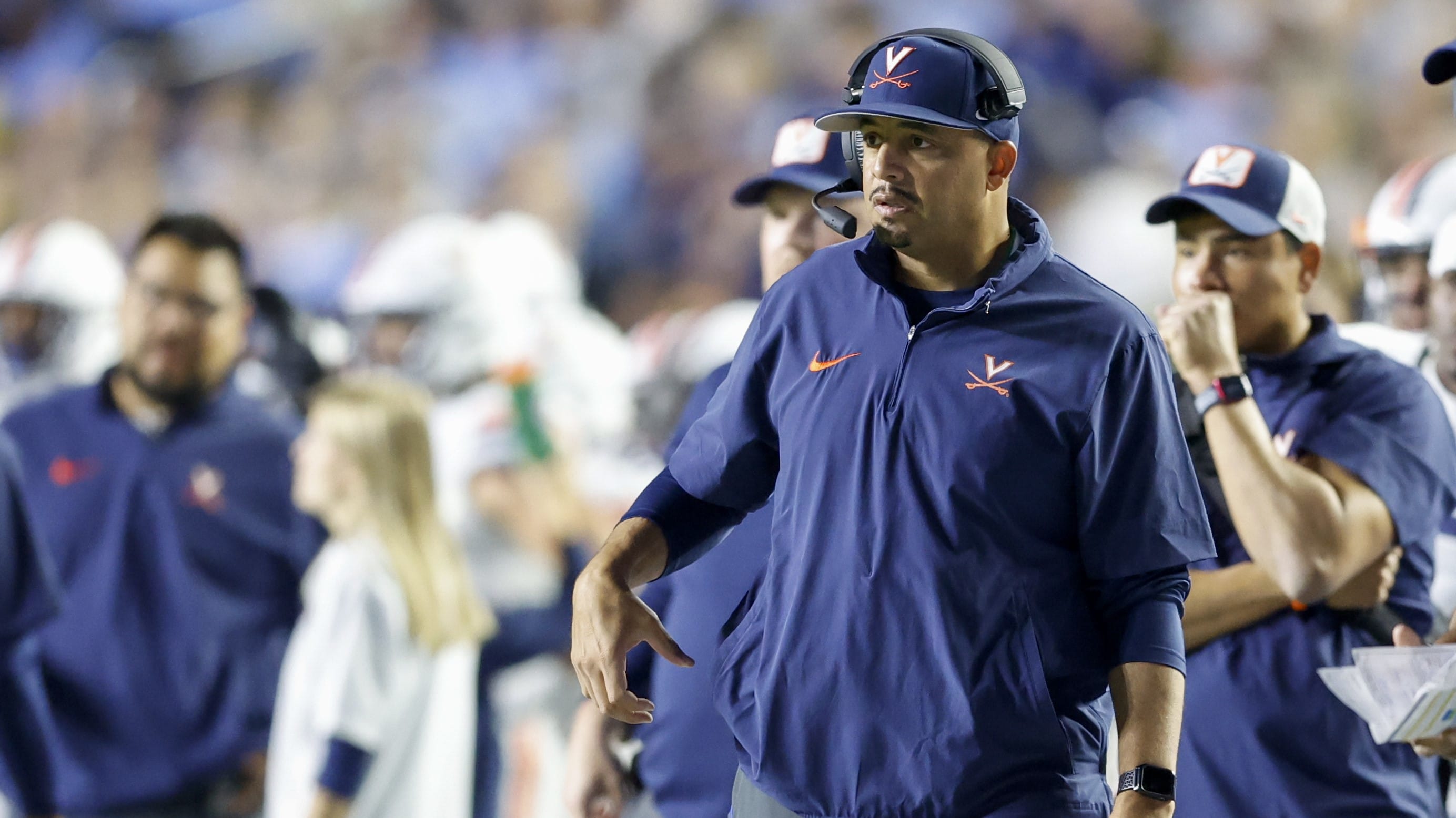
Virginia Football Schedules Home-and-Home Series With Washington State
- Author: Matt Newton
Virginia is beginning to fill out its non-conference schedule for the 2025 football season. UVA football announced on Tuesday that a home-and-home series has been scheduled between Virginia and Washington State, two programs that will meet each other for the first time.
🚨Future schedule alert🚨 2025 - Charlottesville 2031 - Pullman, WA 🔗 https://t.co/uAHRb8Jyl6 #UVAStrong | #GoHoos ⚔️ — Virginia Football (@UVAFootball) April 23, 2024
The first matchup will take place during the 2025 season, when the Cougars will travel to Charlottesville to visit the Cavaliers at Scott Stadium on Saturday, September 27th, 2025. The return game won't take place until six years later, when Virginia plays at Washington State at Gesa Field in Pullman on September 13th, 2031. It will be interesting to see where things stand for the Cougars by the 2025 football season, as Washington State is just one of two remaining member schools (Oregon State) who still be in the Pac-12 starting in the 2024-2025 academic year.
Virginia has now scheduled three of its four non-conference games for the 2025 football season: August 30th: vs. Coastal Carolina September 13th: vs. William & Mary September 27th: vs. Washington State
In ACC play in 2025, Virginia will host Florida State, Stanford, Wake Forest, and Virginia Tech and play road games at Cal, Louisville, Duke, and North Carolina.
See more info on all of Virginia's future football schedules here.

IMAGES
VIDEO
COMMENTS
Michigan Stadium. School: Michigan Location: Ann Arbor, Mich. Capacity: 109,901. Michigan Stadium is the largest stadium in the United States and the number one stadium on this list. When you ...
10 - Old Trafford, Manchester, England. Old Trafford, home of Manchester United FC since 1910, is something that every football lover must visit. Sir Bobby Charlton dubbed it The Theater of Dreams. It is definitely one of the best football stadiums in the world.
The second-oldest college football stadium got a much-needed expansion in 2014, adding 6,000 more seats and at least 6,000 more cowbells to its mix of unique crowd noise.
While this might not be one of the best teams in the country, the Nittany Lions' home crowd certainly makes this one of the best college football stadiums in 2023. Maximum Capacity: 106,572. 1 ...
20. Paycor Stadium - Cincinnati Bengals. This stadium has three things going for it: 1) It was one of only three NFL stadiums not named after a corporate sponsor ( not anymore) 2) it's next to a ...
Maracanã Stadium in Rio de Janeiro, Brazil, is widely hailed as the temple of football. This historic venue has witnessed some of the most unforgettable moments in football history, including 2 FIFA World Cup finals. Visiting this incredible place is a must-do when you go backpacking around Brazil!
Ohio Stadium. THE Ohio State University Buckeyes. Columbus, Ohio. Capacity: 104,944. "From the fans to the Best Damn Band in the Land, the scene in Columbus is college football at its finest ...
Some call it an eye sore, some cherish it, but everyone knows it completes the look of one of the most unique stadiums in College Football. 19. Sanford Stadium - Georgia. Capacity - 92,746. Sanford Stadium was already one of the most impressive stadiums, boasting the 9th largest capacity in the sport.
Iowa has the only college football stadium named for a Heisman Trophy winner — Nile Kinnick won the award in 1939 and died fighting in World War II. ... Fans who visit Tiger Stadium will literally feel the earth move underneath their feet when the 102,000-plus in attendance get warmed up. So, if you want to understand what college football ...
With a capacity of just over 106,500, Beaver Stadium is the second-largest college football stadium in the nation. MORE: College Football's Top 25 Biggest Stadiums. 2) Ohio Stadium, Ohio State ... ear-piercing noise levels, and irregular "sailgating" make for a must-visit extravaganza. Meanwhile, Pac-12 rival Oregon's Autzen Stadium ...
27. Gelora Bung Karno Stadium. Gelora Bung Karno Stadium (Image credit: Getty Images) Indonesians have a passion for football that's virtually unmatched elsewhere in Asia. The impressive Gelora ...
Subscribe to Road to CFB for more! 14. McLane Stadium, Baylor. The entire Baylor University campus is picturesque, but the athletics side of campus sits right on the Brazos River. McLane Stadium, built in 2014, took full advantage of its positioning, opening the horseshoe directly facing the river. While Waco, Texas, is far from a destination ...
The ultimate resource for football fans looking to explore stadiums around the world! Plan your next football trip, read reviews and get helpful tips. ... where to eat and drink and what else there is to see and do. Football cities. Football in Barcelona; Best stadiums Manchester; Best stadiums Buenos Aires; Best stadiums Munich; Best stadiums ...
Howard's Rock, 'The Hill,' invested fans, and a big-time stadium environment made Death Valley a must-visit for college football fans." — Anna Hickey, Clemson247 8.
Fortuna Arena - Prague. While it doesn't stand out among the big flashy names, the Czech Republic - and Prague in particular - is a hidden gem for a European football fix on a budget, and you get the full experience. Ad. One of the game's most underrated derbies is contested in the capital between Slavia Prague and Sparta Prague.
1 / 11. 10 Best Stadiums in College Football That Are a Must Visit ©(Photo by Getty Images) Every Saturday in Autumn hundreds of NFL hopefuls strap on the pads and hit the field in front of ...
Barcelona. Home to arguably the best football club in the world - FC Barcelona - in the recent past, and also Lionel Messi. Their home ground - Camp Nou - is also one of the largest football stadiums in the world. Famous footballers to have played here: Lionel Messi, Luiz Ronaldo, Johann Cryuff, Rivaldo, Andres Iniesta, Diego Maradona.
The Allianz Arena represents the perfect blend of football excellence and stunning design, making it a must-visit destination for any football lover exploring the vibrant city of Munich. Old Trafford, Manchester, England. Old Trafford, located in Manchester, England, is one of the most historic and iconic football stadiums in the world.
Though that is most certainly true, the Emirates stadium is an equally impressive venue to visit and is a great place to watch football. Known as Ashburton Grove before it was sponsored by an airline and referred to Arsenal Stadium when hosting UEFA competitions, it opened in 2006 and can host more than 60,000 supporters.
It is the second-largest in Germany. The Allianz Arena is also one of the most modern stadiums in Europe. Football stadiums: Camp Nou. Another must-see football stadium in Europe is the Camp Nou in Barcelona, Spain. With a 99.354 seating capacity, the Camp Nou is the largest football stadium in Europe. Since 1957 the FC Barcelona is hosting its ...
Alberto Jose Armando Stadium, Buenos Aires. La Bombonera in Buenos Aires is next on our list. The Alberto Jose Armando Stadium, known only as "La Bombonera", is home to the Boca Juniors. It is famous for providing one of the best home-field advantages in the sport. The stadium's unique feature is its ability to 'shake' during high-energy matches.
Go to Southampton, Stoke, Sunderland, Reading, Leicester, or Swansea. In the States, think about the Polo Grounds giving way to Shea Stadium, or Comiskey Park giving way to wherever the White Sox play now. Or just contemplate Wrigley or Fenway coming down. So put these English football stadiums, from the top two divisions, high on your list to ...
A world-class destination for a world-class city. Introducing initial designs for a new lakefront stadium. #StadiumForChicago — Chicago Bears (@ChicagoBears) April 24, 2024
The construction team chosen to build USF football's on-campus stadium touted its budget control, local ties and experience — including the ongoing renovation of Florida State's Doak ...
The Chicago Bears have revealed the first look at its proposed $4.6 billion stadium to be built on the city's lakefront. Bears Chairman George McCaskey, President and CEO Kevin Warren, and Chicago ...
The Bears must overcome several obstacles to make the domed stadium on the lakefront a reality. The first is ensuring a healthy, long-term relationship between the team and the park district.
Ahead of the Bears' press conference unveiling their plans for a new stadium on Wednesday, they released photographic renderings of the stadium on the lakefront. The renderings include the domed stadium, with the stadium atop the current South Parking lot of Soldier Field. As for Soldier Field, the columns exist, but the stadium is gone.
The new stadium would be constructed on a parking lot just south of Soldier Field, the Bears' home since 1971. The team's lease at the 100-year-old stadium runs through 2033.
Mike Florio and Chris Simms take a look at the reported cost for the Bears' new stadium and question if at some point, Chicago could see another NFL team. Chicago Bears' new stadium project reportedly to cost $4.6 billion - NBC Sports
Virginia and Washington State will meet for the first time on September 27th, 2025 at Scott Stadium and then the Cavaliers will visit the Cougars in Pullman in the 2031 season.